OF THE INDUSTRY IS YOURS
PLUMBERS, INSTALLERS & HEATING ENGINEERS



FEATURING...
REACHING

EDITOR: CELIA MATTHEWS celia.matthews@sng-publishing.co.uk
SENIOR GRAPHIC DESIGNER: LEE OWEN design@sng-publishing.co.uk
DIGITAL MANAGER: PHOEBE MANSFIELD phoebe.mansfield@sng-publishing.co.uk
PARTNERSHIP DEVELOPMENT MANAGER: PATRICK BLORE patrick.blore@sng-publishing.co.uk
PARTNERSHIP DEVELOPMENT MANAGER: SARAH HERNE sarah.herne@sng-publishing.co.uk
EVENT MANAGER: REISS BASSETT reiss.bassett@sng-publishing.co.uk
MANAGING DIRECTOR: ZOË TANNER zoe.tanner@sng-publishing.co.uk
PRINTERS: Stephens & George, Wales
To subscribe to HIP Magazine call 0121 779 0888 or subscribe online at www.hip-magazine.co.uk
HIP is published by SNG Publishing Ltd (SNG). All content and artwork is © SNG Publishing Ltd or its contributors and SNG and HIP are trademarks of SNG Publishing Ltd.
No part of HIP may be copied, transmitted or published in any form or by any means without prior permission.
Although SNG has made every effort to ensure the accuracy of this publication, it does not verify any claims or other information appearing in the advertisements contained in HIP. It therefore cannot accept any responsibility whatsoever for consequences that may arise from the content or artwork contained in HIP, including any errors or omissions or any opinions or advice given therein. This publication and its content is not a substitute for professional advice on a particular matter.
Advertisements are accepted for publication in HIP only upon SNG Publishing Ltd’s standard terms of advertising.

Welcome to your Course Companion!

Congratulations on completing your first term at college – you’re already laying the foundation for a strong and rewarding career in the plumbing and heating industry!
This handbook is packed with essential information, including industry top tips, step-by-step guides, and insights into the products and services you’ll encounter during your course and on-site.
At HIP, we’re here to support you every step of the way. Alongside this handbook, we provide magazines, digital resources, and national skills competitions to help build your confidence and experience – all completely free.
Don’t miss out! Follow us on social media for the latest updates, inspiration, and chances to win fantastic prizes in our free competitions.
Here’s to a fantastic 2025 and the successful start of your career!











































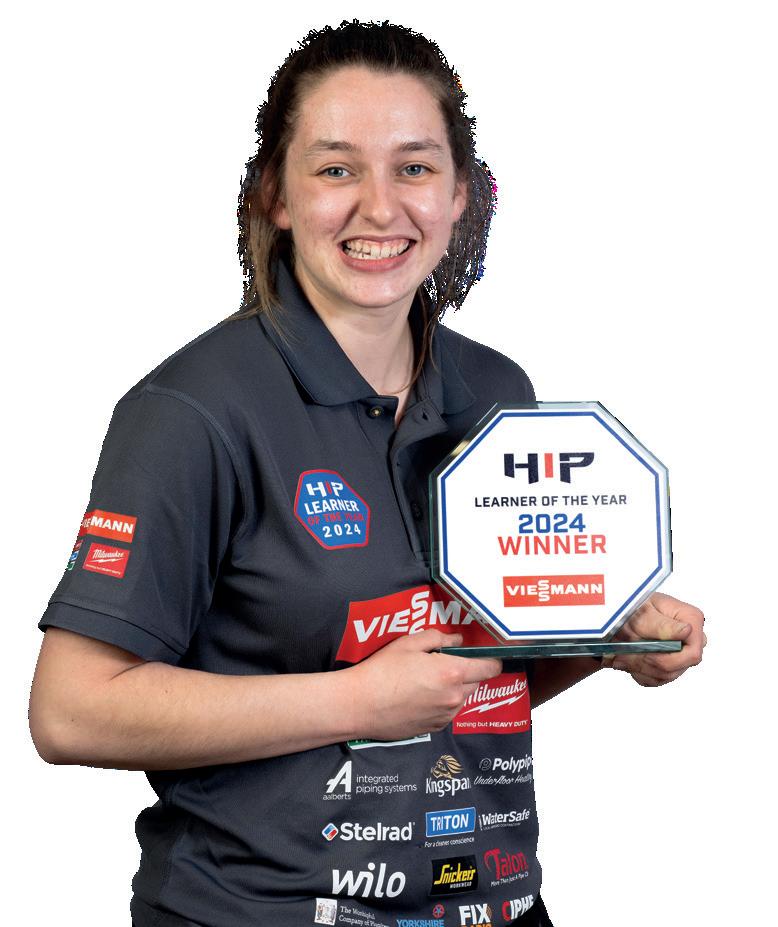
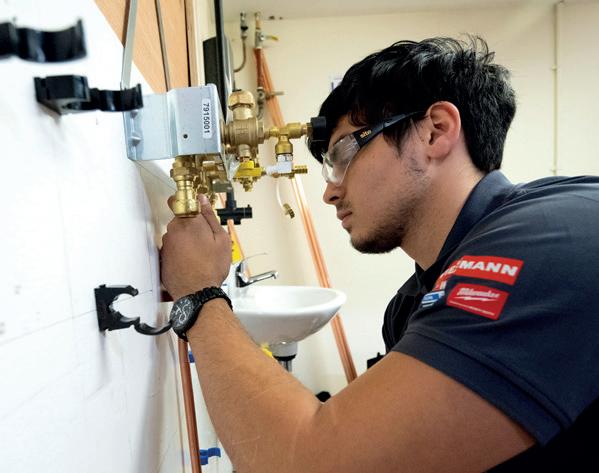
























i




The UK government continues to emphasise sustainability, tightening regulations related to the energy performance and carbon emissions of buildings.
These changes align with the Future Homes Standard, which aims for new homes to produce 75-80% fewer emissions by 2025. One key step towards this target is the update to Part L of the Building Regulations, which came into effect in June 2023. These updates are critical for plumbers and heating professionals as they have direct implications for daily work.
Here’s an essential guide to what’s changed and how you can stay compliant.
One of the most significant updates is the new flow temperature requirement. Heating systems must now not exceed a flow temperature of 55°C, and wherever possible, should operate below this level. Ensuring that systems are correctly sized to meet this requirement involves conducting a heat loss calculation before installation.
All primary circulation pipes, including those located under floors or behind walls, must now be insulated. This is detailed in paragraphs 4.24 and 4.25 of the regulations. The only exemption is one metre of pipework connected to hot water cylinders. Additionally, if you’re upgrading or replacing boilers or hot water storage units, any exposed pipework must be insulated.
Building inspectors now require proof of compliance, so it’s essential to take clear photos of the insulated pipework and submit them to the building control body for verification. Keeping a camera in your toolbox is now as important as any other tool.
For new builds with a floor area exceeding 150 square metres, the updated regulations mandate at least two independently controlled heating circuits. Furthermore, all heating system controls must be wired, ensuring appliances and pumps automatically turn off when heating or hot water is not in use.
For domestic hot water circuits, paragraph 5.16 specifies that they should have separate time controls from space heating circuits,

and electronic temperature controls should also be installed. Additionally, paragraph 5.20 requires that, when upgrading boilers, a thermostatic radiator valve must be fitted on every radiator except for the one connected to the room thermostat.

Before installing a new heating appliance, it’s mandatory to clean and flush central heating and primary hot water circuits of any debris. This ensures compliance with BS 7593, which aims to improve the longevity and efficiency of domestic heating systems. The regulations also stipulate that, when installing new boilers, water quality should be monitored and treated with inhibitors to maintain correct pH levels, while magnetic filters should be added to prevent corrosion.
“If you’re upgrading or replacing boilers or hot water storage units, any exposed pipework must be insulated”
By understanding and adapting to these updates in Building Regulations Part L, plumbers and heating engineers can ensure their installations are energy-efficient and sustainable, helping reduce carbon emissions as the UK moves towards its Future Homes Standard targets.

“Heating systems must now not exceed a flow temperature of 55°C”
for more information about compliance and how Reliance Valves’ range of water control valves can support your installations.

A valve is a device that regulates, directs or controls the flow of water by opening, closing, or partially obstructing various passageways.


> CIRCULATING PUMP > AUTOMATIC BYPASS VALVE > AUTOMATIC AIR VENT > PRESSURE SAFETY VALVE (PSV) > LOCKSHIELD VALVE

The device which generates the flow of water around the heating circuit.

A device which releases air trapped within a water system, automatically. The air vent is usually fitted at the highest point of the heating system.
A valve which ensures a minimum flow rate through the boiler if all zone valves or TRVs are closed.
This is a safety device fitted to relieve excessive pressure within a heating system or boiler. Once excess pressure has been relieved, it will close itself automatically.

A Lockshield Valve is fitted at the return side of a radiator and is used to balance the system when it is first installed. It is usually covered with a cap.

> RADIATOR VENT

A device that releases air from within a radiator.
> THERMOSTATIC MIXING VALVE (TMV)

A TMV blends cold water with hot water to ensure constant, safe shower and bath outlet temperatures, preventing scalding.
> REDUCED PRESSURE ZONE VALVE (RPZ) > THERMOSTATIC RADIATOR VALVE (TRV)

The RPZ Valve is a device which prevents backflow, protecting against the contamination of mains cold water supply. RPZ valves are widely used in the UK.
> ROOM THERMOSTAT

A Room Thermostat switches the heating system on and off as required. It works by sensing and responding to the air temperature. It switches on the heating when the air temperature falls below the thermostat setting, and switches it off once this set temperature has been reached.
> PRESSURE REDUCING VALVE (PRV)

Precisely controls and regulates water flow and pressure for safe operating conditions.

A valve fitted to one end of a radiator that automatically opens and closes as necessary to achieve the pre-set room air temperature.
> WIRELESS PROGRAMMABLE ROOM THERMOSTAT

The Wireless Programmable Thermostat is designed to provide wireless time and temperature control to heating or cooling systems in domestic and light commercial buildings.
> TENANT VALVE

A space saving and compact all-in-one water monitoring unit, that consists of a ball type isolating valve, pressure reducing valve, double check valve, test point and a connection point for Reliance Valves single jet water meter.

As a plumber you will need to be able to recognise the different types of fittings and their correct applications. Shown below are some of the most common you may come across.



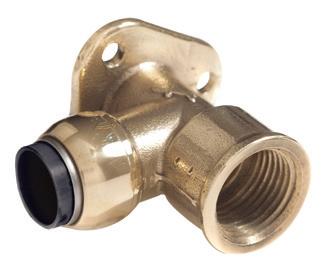





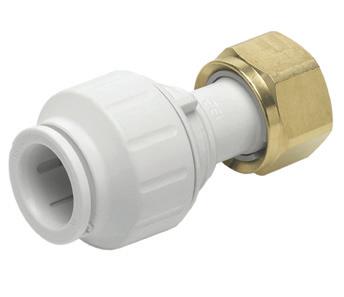



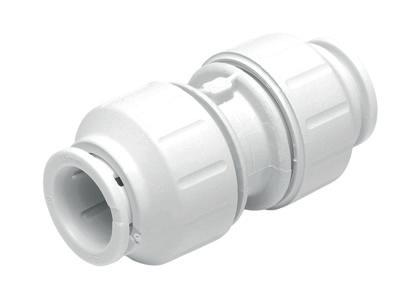














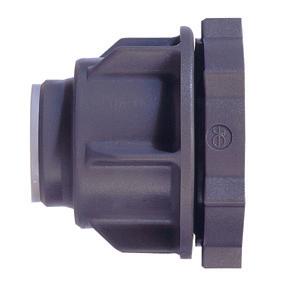




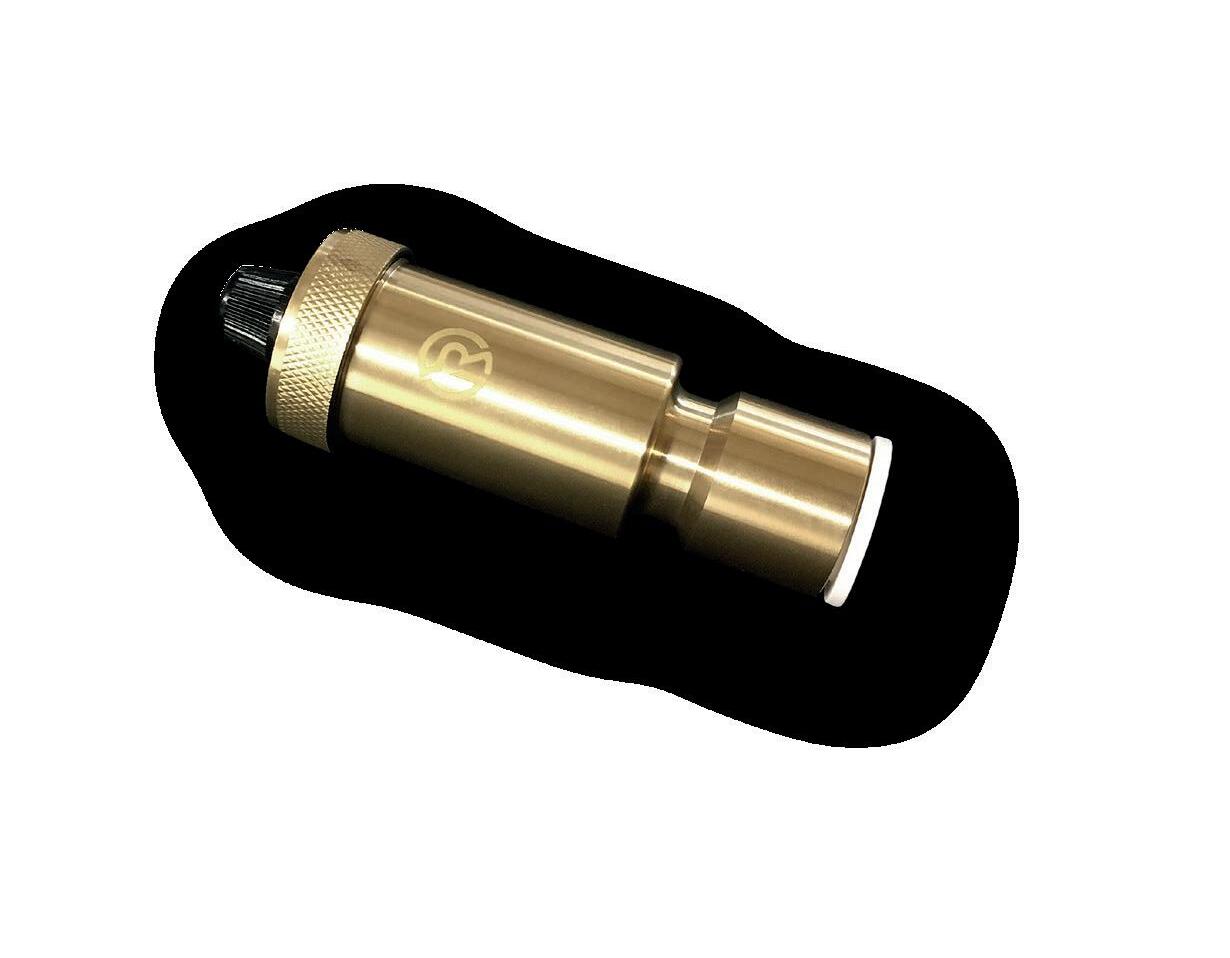






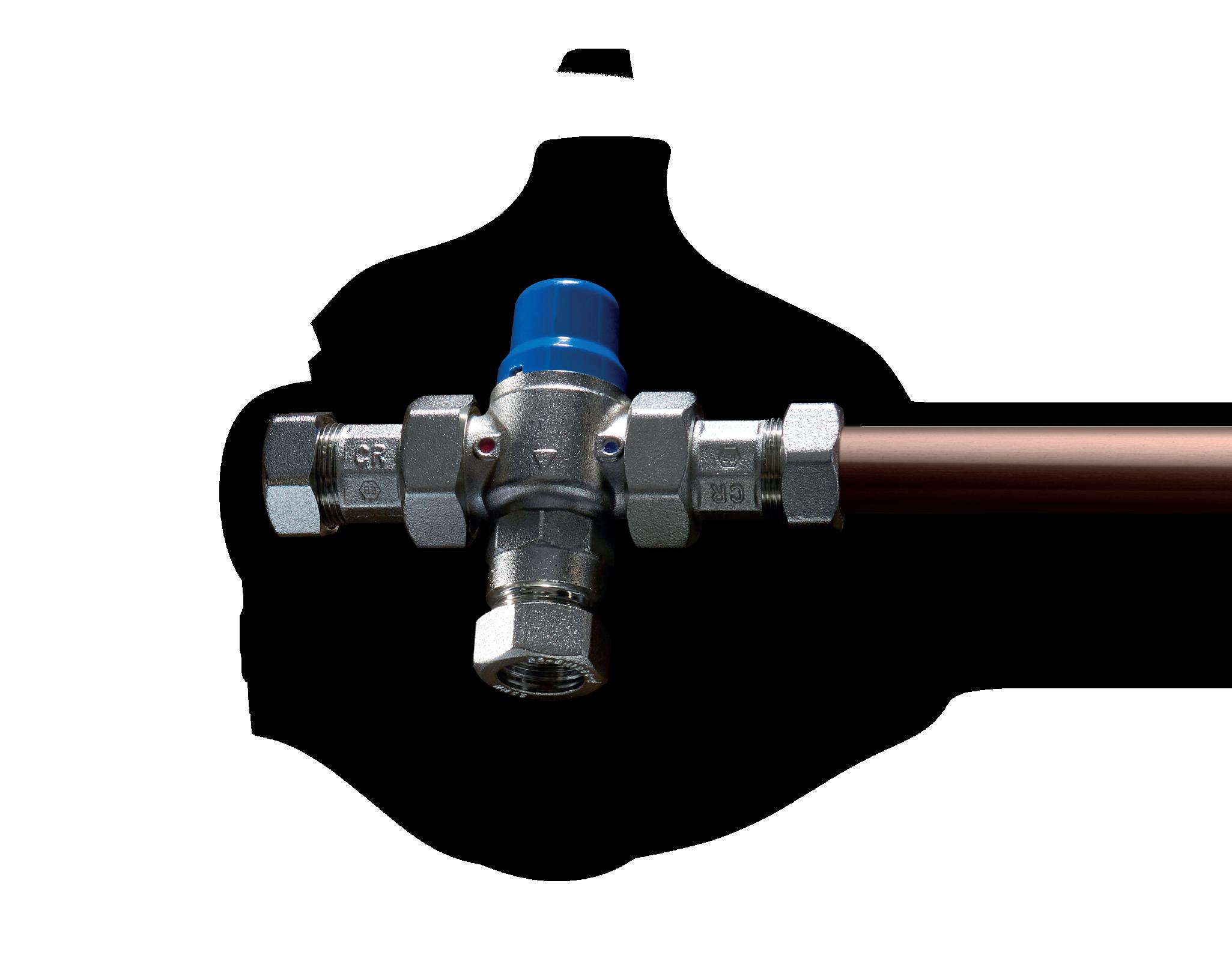



Shown below are some of the most common pipe discharge dimensions that you will come across.
Listed below are the recommended spacings to use between internal fixings when using copper pipe, plastic pipe or low carbon steel pipe (LCS).


Listed below are the most common types of fixing screws you will come across on a day-to-day basis.

5 8 3 6 9 1 4 7





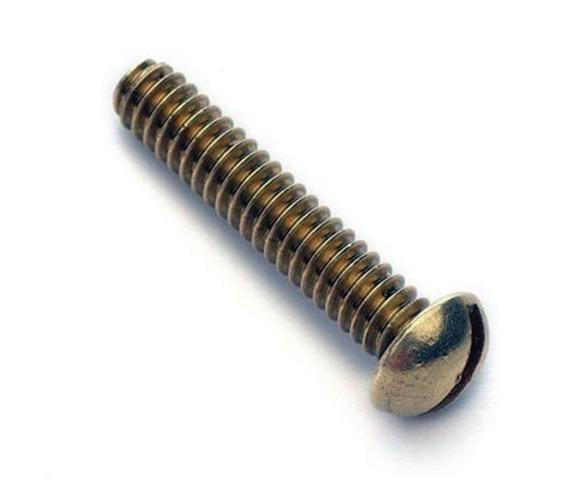

PLASTIC PLUGS: Shown below are common size matches for screws, drill bits and plugs.

Shown below are some of the most common pipework and supply symbols used within the plumbing industry.

When drilling or notching structural timbers it is crucial that the holes / notches are made in a way that does not compromise the integrity of the structure.
1.
Depth (D)
Rules for joist depth up to 250mm. For deeper joists assume D = 250mm
Span (L)
0.25 x L
Max depth of notch = D/8
0.07 x L
Notches should be in this zone
It is essential that structural members are not weakened by indiscriminate notching and boring. In this respect both the size and positioning must be in accordance with fig 1 (above).
> NOTCHES SHOULD BE CUT AS FOLLOWS...
They should be cut no deeper than 1/8 of the depth of the joist. They should not be cut closer to the support than 0.07 times the span, nor further away than 0.25 (1/4) of the span.

Drilled holes should be no greater in diameter than ¼ of the depth of the joist. They should be drilled on a neutral axis and should not be less than 3 diameters apart, measured from centre to centre. Drilled holes should be located in the area between 0.25 and 0.4 times the span of the joist from the support. See fig. 2 (right).
(L)
Holes should be located in this zone and drilled at the neutral axis
of joist (D)
Maximum diameter of a hole = 0.25 x D
Not less than 3 diameters apart centre to centre
Neutral axis of joist
Buildings that incorporate timber ‘I’ joists (Engineering Joists) allow for more flexible drilling of holes for pipe work. ‘I’ joists incorporate 38mm knockouts (dependant upon the manufacturer), and also allow for larger holes to be drilled through the joists.
The same rules apply when drilling through ‘I’ joists as for drilling traditional joists where horizontal measurements between holes are concerned.
However, as the strength of ‘I’ joists is in the flange (see fig. 3), these joists are not suitable for notching, as notching the flange will damage the structure of the joist which will have a detrimental effect on its strength. The size and positioning of holes drilled through ‘I’ Joists must be in accordance with fig. 3 (right).
Not less than 3 diameters apart centre to centre
38mm diameter knockouts are incorporated in TJI joists at approx 300mm centres
Additional holes can be cut but leave minimum 3mm of web at top and bottom
FOR DRILLING HOLES THROUGH
(‘I’) JOISTS
▸ To convert METRIC to IMPERIAL multiply by the conversion factor.
▸ To convert IMPERIAL to METRIC divide by the conversion factor.






With the growing demand for heat pumps, exciting new employment opportunities are opening up for young people.

Imagine putting on a virtual reality headset and stepping into the future as a heat pump engineer. That’s part of the training offered by heat pump manufacturer Mitsubishi Electric.
Well-paid job opportunities are opening up as air source heat pumps roll out across the UK, replacing gas boilers as the go-to solution for home heating and hot water. By training as a heat pump engineer, you’ll be setting yourself up for a bright future in a growing industry.








Our NEW pre-plumbed cylinders with FTC7 controller are now compatible with and outdoor units – providing flexibility and time saving on your next installation.

> WHY THE UK NEEDS HEAT PUMPS?
Why now? Because the UK is moving towards sustainable energy solutions, and heat pumps are emerging as a key technology to decarbonise home heating in the fight against climate change and to help reach the government’s net zero target by 2050. The government is backing this move with:
▸ Financial incentives of up to £7,500 for homeowners to install a heat pump.
▸ The introduction of a Future Homes Standard that will require all new build homes to be built with low carbon heating systems, such as heat pumps, from 2025.
▸ A target to install 600,000 heat pumps per year by 2028.
> WHAT MAKES HEAT PUMPS SPECIAL?
Heat pumps offer an energy-efficient alternative to traditional gas boilers to provide heating. They extract heat from the air outside and transfer it indoors, working even in sub-zero temperatures. By using the ambient air as a heat source, heat pumps reduce reliance on fossil fuels, lowering both energy costs and carbon emissions.
“Heat pumps offer an energy-efficient alternative to traditional gas boilers to provide heating”


“Training to become a heat pump engineer offers a promising and rewarding career”



Harlow College was the first college that Mitsubishi Electric teamed-up with to establish The Renewable Energy Training Centre, a new on-campus project for the next generation of heating engineers to train in using green technologies.
Here students are trained in renewable energy appliances, including heat pumps. Within the centre, workstations allow learners to develop an understanding of how to install and maintain heat pumps.
The college tutors are certified to a minimum of NVQ Level 3 as qualified plumbing and heating engineers and have also undertaken specific Ecodan product installation training at Mitsubishi Electric’s Training Centre in Hatfield, Hertfordshire.
> TRAINING CENTRES ACROSS THE UK
As more heat pumps are installed, the need for skilled engineers to fit and maintain them is increasing. Given the national push towards sustainable technologies, there is a significant shortage of trained professionals in this area. This offers a golden opportunity for young people interested in entering a highly specialised and rewarding career.
Training as a heat pump engineer offers the chance to work at the cutting edge of the green technology revolution. Engineers are responsible for installing the heat pump correctly, as well as maintaining their effective and efficient operation.
Mitsubishi Electric has its own training centres in Hatfield, Manchester and Livingston. The training programmes offered meet the rigorous standards set by the industry and equip participants with the essential skills and knowledge to advance in the growing renewable energy market.
Over 1,000 people per year can be trained as accredited heat pump installers at each of Mitsubishi Electric’s training centres. As well as hands-on training, the company has developed Virtual Reality (VR) training opportunities giving installers a fun and innovative way to learn and understand the workings of heat pumps.
With the sector growing fast, now is the perfect time to step into a future-focused role. This is your chance to get involved as the industry prepares for the widespread use of heat pumps by housing developers and homeowners.

In response to the urgent call to achieve Net Zero by 2050, Mitsubishi Electric and Harlow College have established a partnership, highlighting their commitment to environmental sustainability.

“Air source heat pumps have a positive impact on the environment”
Through our partnership with Harlow College, we’ve launched the Renewable Energy Training Centre, which has become a focal point to upskill the next generation of heating engineers. The centre is teaching students how to install and maintain low carbon technologies, including air source heat pumps, and helping to support the local community in meeting decarbonisation targets.
With attention turning towards changing the way we heat our buildings, demand for low carbon technologies will continue to grow. Training to become a heat pump engineer can enable installers and maintenance engineers to make a long-lasting, positive impact on the environment by supporting the transition to renewable heating.
Together, through strategic partnerships and a focus on education, we’re paving the way for a Net Zero future.




Bathrooms have evolved from purely functional spaces into personal sanctuaries, reflecting style, innovation, and practicality.
With contemporary design trends focusing on clean lines, concealed fixtures, and a minimalist aesthetic, bathrooms are becoming expressions of individuality and comfort. Whether it’s a sleek shower or luxurious finishes, the modern bathroom is all about creating a serene, spa-like experience.
As homeowners and developers aim for both efficiency and elegance, the importance of high-quality products cannot be overstated. Durability, ease of installation, and adaptability are key to ensuring a seamless renovation process and lasting satisfaction for users.
hansgrohe, a global leader in bathroom innovation, stands at the forefront of this transformation. Renowned for combining cutting-edge technology with stunning design, hansgrohe delivers products that enhance both the installer’s experience and the enduser’s enjoyment.
“The importance of installing high-quality products cannot be overstated”
Drawing inspiration from over a century of expertise, hansgrohe’s collections cater to various tastes, offering solutions that integrate effortlessly into modern bathrooms. From their commitment to sustainability to an unwavering focus on precision engineering, hansgrohe embodies quality and reliability. Whether you’re seeking inspiration for a complete renovation or looking for individual components to upgrade your space, hansgrohe provides a benchmark for excellence.



Installing the hansgrohe iBox universal 2 can be done in just six simple steps. Designed with installers in mind, it revolutionises concealed shower installations.
> NEXT GENERATION
Building on the original iBox’s success, the iBox universal 2 offers enhanced features, increased flexibility, and faster installation.

1
> STEP 01
Undo the screws and remove the mounting ring from the iBox universal 2.


> STEP 02
Install the connection fittings and securely clamp the pipe nipple to ensure there is a leak-free fit.
2 3

> STEP 03
Fix the mounting rig to the wall and position the iBox universal 2 securely in place.


> STEP 04
Simply adjust the depth of the unit, align it horizontally and vertically, and fix it securely using the integrated spirit level for precision.

> STEP 05
After fitting the sliding sleeve to size, adhere the fixed waterproof membrane to create a watertight seal.

> STEP 06
Attach the maintenance joint and protective cap, ensuring the iBox universal 2 is ready or tiling.
For more information: 4 5 6
The iBox universal 2 is compatible with all hansgrohe concealed finish sets, offering unmatched flexibility. Whether you prefer manual, thermostatic, push-button, or singlelever controls, it adapts to your needs. Made with recyclable materials, it reflects hansgrohe’s sustainability commitment.
Once installed, hansgrohe finish sets provide sleek, stylish designs for a flawless look. Their adaptability ensures longevity, allowing for easy renovations or upgrades using an adaptor.
Available since September 2023, the iBox universal 2 is the ideal choice for installers and homeowners alike.
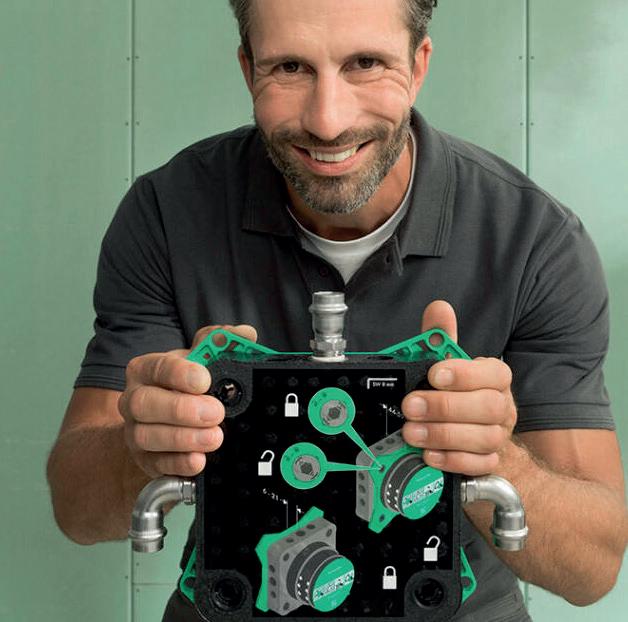

Tim Bridge, owner of Tim Bridge Plumbing and Heating in Yorkshire, has relied on hansgrohe’s original iBox for over 20 years.
As one of the first installers of the new iBox universal 2 in the UK, Tim experienced the latest innovations designed to simplify and improve concealed shower installations.


“I’ve been using hansgrohe’s iBox since I was 17, so it is great to see the next generation coming through”, said Tim. “Ease of installation has kept me returning to this fixing system time and time again as I know it just works”.
Tasks like trimming components and aligning fittings still took extra time with the previous model. However, the iBox universal 2 features a built-in spirit level for precise alignment, pre-mounted seals for watertight
results, and an adjustable sliding sleeve that eliminates the need for trimming.
“Right from taking it out of the box, I spotted the upgrades”, Tim explained.
“The iBox universal 2 is neatly packaged, so it stays together as you lift it out with no chance of losing anything on a busy renovation site. And you only need two tools – a screwdriver and an Allen key – to fit it!”
Reflecting on the updates, Tim added:
“The new version irons out even those aspects that may have taken any time, making it even more straightforward to install and fit correctly”.
For plumbing students, Tim’s experience highlights the importance of learning reliable systems early.
“You only need two tools - a screwdriver and an Allen key - to fit it!”






Getting hold of a specific internal circulator pump can add a significant amount of time and cost to a boiler repair. Simply download the Grundfos GO app to your smartphone or tablet to make choosing a pump replacement quick and easy.



Grundfos GO may be the solution you’re looking for. Designed to make circulator pump replacements as easy as possible, Grundfos GO offers installers a guide to replace pumps in 6 simple steps: TO



SEARCH FOR GRUNDFOS GO APP IN THE APP STORE DOWNLOAD THE APP FROM THE HOME SCREEN, SELECT PRODUCTS AND GO REPLACE FOR CIRCULATORS
SCAN THE FACE PLATE OR ENTER PRODUCT NUMBER
CHECK SUITABLE REPLACEMENTS

You might wonder if a small pump can handle the hot water needs of an entire house. The answer is yes!
The COMFORT range’s small pump is designed to be highly efficient and powerful, ensuring that hot water is available at every tap quickly and reliably. This makes it an excellent choice for residential applications where both space and efficiency are crucial.
The COMFORT range includes three models, each tailored to meet different needs:

> COMFORT TTEMPERATURE CONTROL:
Ideal for homes without a fixed daily schedule, with some energy concerns and a focus on comfort. No manual settings required. The temperature control mode significantly reduces the heat energy consumed by the water heater, saving up to 25% in heat energy compared to a continuously running pump.

> COMFORT TDTTIMER & TEMPERATURE CONTROL:
Best suited for homes with a specific schedule and a strong focus on reducing energy consumption. Requires manual timer settings. The timer and temperature control mode significantly reduces heat energy consumption, saving up to 56% compared to a continuously running pump.
“COMFORT range’s small pump is an excellent choice for residential applications”

> COMFORT TAAUTOADAPT CONTROL:
Perfect for homes where the daily schedule is unpredictable, with a desire to maximise energy savings. Well-suited to holiday homes. No manual settings required. Operates continuously 24/7. The AUTOADAPT control mode reduces heat energy consumption by up to 67% compared to a continuously running pump.
To learn more about the COMFORT range through Grundfos ECADEMY.
[WATCH NOW]
is a perfect fit for stand alone applications or as a spare part for pre-ERP boilers


Easy and efficient pump replacement
Old functioning pumps use significantly more energy than a new Grundfos pump, which means extra energy costs for the consumer. So how do you upgrade them?
With the Grundfos GO app and its database of over 14,000 pump replacements.
Scan, find and replace an old pump. It’s that easy.

Discover more. Visit grundfos.co.uk.

Discover 14,000+ different pump upgrades with the Grundfos GO app

GO 1-2-3 FIND SCAN


Download the Grundfos GO app today
Increase your first-time fix. Save time and money.
Scan to download




Designed specifically to meet the needs of today’s plumbing professionals, this portal offers access to the best tools and information from the Grundfos world to support you in your daily work.
Thousands of your fellow installers have already signed up for Grundfos for Installers. Join them for free and get unlimited access to tools, training and knowledge. You’ll also be among the first to hear about upcoming products as well as exclusive events.
SCAN THE QR CODE TO JOIN TODAY.

The more you know about pumps, the easier you can recommend pumps that give customers even more comfort in the home - not only today, but also in the future! Grundfos Ecademy - free pump courses 24/7. Find your first course today! More pump knowledge = more business.
GRUNDFOS FREE COURSES 24 / 7




The Grundfos for Installers hub is ready to help you to fulfil a wide range of tasks as well as providing you with 24/7 assistance and some great hints and tips, all of which can be accessed from your computer tablet or smartphone.
On top of all these great elements, being part of the Grundfos for Installers club can also offer you some surprising added extras, that are aimed at helping you to maximise your business potential with both on and offline support suggestions and ideas. These practical guides are available as animations and will help you to stand out from other similar organisations.
Next time, you’re unsure about something pump related, visit Grundfos for Installers www.grundfos.co.uk/gfi because we want to share our knowledge with you.


Regulation 4 plays an important role in ensuring the safety and quality of plumbing systems. Here's what you need to know about staying compliant.
The Water Supply (Water Fittings) Regulations 1999, set out the design, maintenance and operating standards required of plumbing systems in all types of premises to protect public health and safeguard supplies by preventing:
▸ Waste
▸ Misuse
▸ Undue Consumption
▸ Contamination

> WHAT IS REGULATION 4?
Regulation 4 sits within these water regulations and specifies requirements for water fittings installed within the water supply inside the boundary of a property. It details the specific requirements for wholesome water fittings, as they must be of an appropriate quality and suited to their intended use.
> LEGALITY & RESPONSIBILITY –WHO IS ACCOUNTABLE?
In the UK, all systems connected to drinking water are required by law to be installed using items that abide with water regulations, specifically Regulation 4. Failure to adhere to the requirements could result in legal repercussions for the installer.
According to the regulations, the responsibility of compliance when installing plumbing fixtures, water fittings, and appliances is the legal obligation of all users, owners, occupiers and installers. Water companies are responsible for ensuring compliance by inspecting installations and enforcing the legislation.

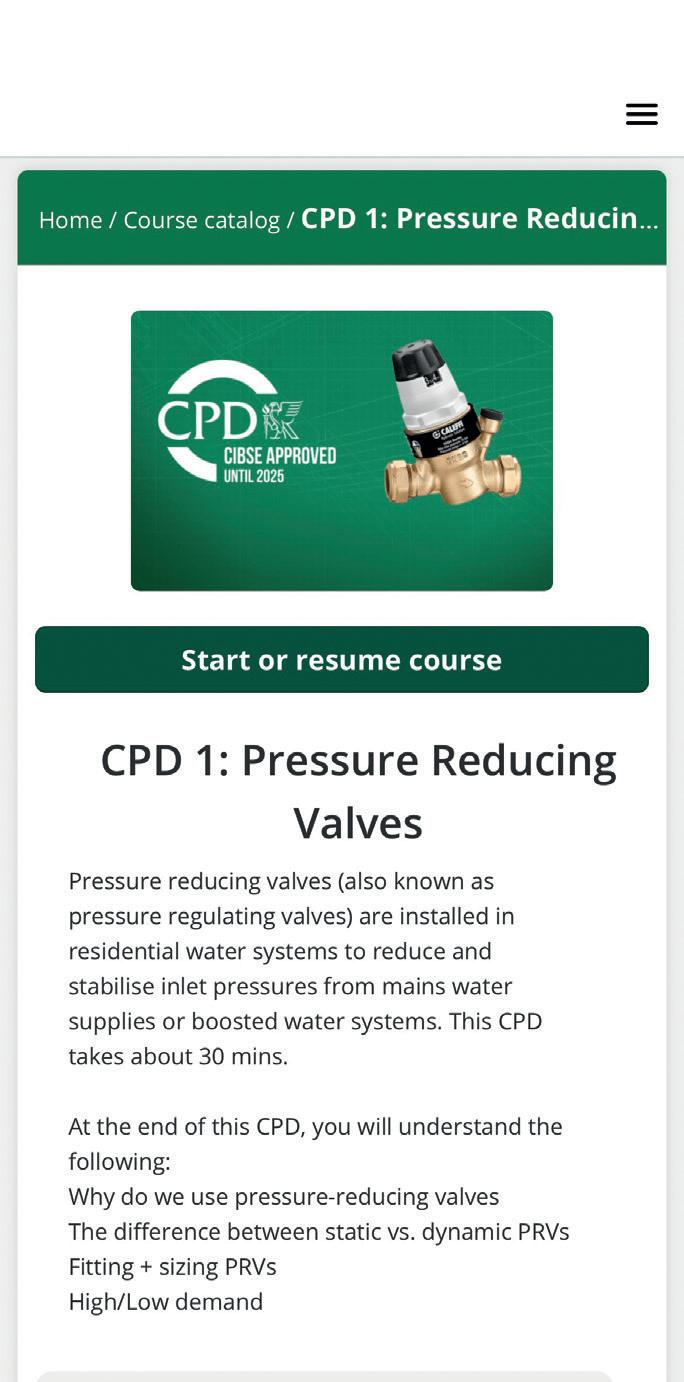


To meet Regulation 4 requirements, there are three main certification schemes in the UK which play a pivotal role in verifying compliance and ensure that water-related products and materials meet public health and safety standards. These are:
▸ WRAS
▸ NSF
▸ KIWA

WRAS helps protect public health by preventing contamination of public water supplies and promoting the efficient use of water. This scheme is highly recognised among installers, manufacturers and specifiers, having been a prominent certification scheme for many decades. However, WRAS is purely a certification scheme, and they do not offer a service to test or verify products, instead they independently validate and review.
In comparison, both KIWA and NSF are classified as functional UKAS test houses.

NSF Reg 4 covers a wide range of mechanical products that come into contact with drinking water, such as valves, backflow prevention devices, taps, mixers, showers and many more. It also certifies non-metallic products such as rubbers, coatings, resins and sealants and offering an equivalent certification scheme to WRAS.


KIWA Reg 4 certification is aimed at manufacturers and distributors of sanitary and plumbing products and components intended for installation in the UK. Recently adding BS 6920 testing to their scope of accreditation, they offer an equivalent certification scheme to WRAS.
Certification from any of these bodies provides manufacturers, specifiers and installers with assurance that the products they make, specify and install comply with regulatory requirements and adhere to industry best practices. This enhances consumer confidence and trust.
“Each certification scheme provides a searchable database of approved products”

PRODUCTS - HOW TO ENSURE AN INSTALLATION IS COMPLIANT?
Each certification scheme provides a searchable database of approved products. Specifiers, installers and end users can search these databases to find approved products. These can be narrowed down or searched using keywords, materials, testing specifications, or product groups.
The database includes important specifications like maximum working pressures and temperatures, as well as a scope and description of the product. Markings that are present on the valve, which is most significant when identifying a valve of fitting on site, are also detailed in the database, as well as a list of the models covered on the approval.
Certified products can also be identified by having approved product logos from the certification scheme on their product packaging, product page on the manufacturer’s website, or in product literature.
As a responsible manufacturer, Altecnic is proud to have a range of relevant products approved by WRAS, NSF and KIWA.
to view our full range of approved products.
With energy bills on the rise, it is important for homeowners to install components to their systems that save energy and reduce costs. The Altecnic Ecocal® TRV range offers this solution.
> WHAT SETS ECOCAL® TRV APART?
The Ecocal® TRV range is TELL (Thermostatic Efficiency Labelling) rated ‘I’, meaning they meet the minimum requirements in line with EN 215 (influence of water temperature, hysteresis, response time and influence of differential pressure). This helps to reassure consumers that by installing an Ecocal® TRV, they are going to be making their heating system more efficient than if they installed a standard radiator valve.

> DESIGN AND INSTALLATION FEATURES

Available in 15mm, 10mm and 8mm versions, these TRVs have been manufactured for both retrofit and new installations, designed with a serrated sliding tailpiece to prevent alterations to pipework during installation.
The models have a reversible body for either vertical or horizontal fit and are suitable for use on either flow or return pipework, providing the installer with ultimate flexibility. Thanks to their positive off position, they even allow for radiators to be removed without needing to be drained.
So, the Ecocal® range of TRVs provide both energy saving for the consumer and make installation and maintenance easier. We think that is pretty heroic!
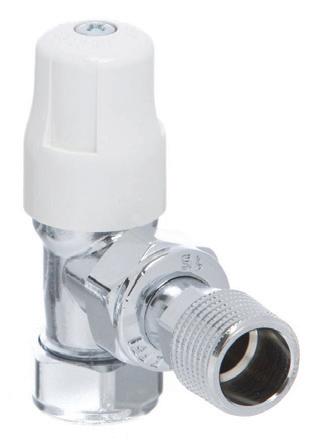
For further information visit: www.altecnic.co.uk


Plastic push-fit plumbing systems for hot and cold water services were developed by Hep²O here in the UK during the late 1970s.
Subsequent years have seen them steadily increase in popularity amongst professional plumbers and installers – largely as a result of a growth in awareness of the obvious benefits they offer.
Plastic plumbing technology started to be taken seriously in the 1990s when availability became more widespread. A significant boost resulted from the uptake in underfloor heating systems which mainly utilise plastic pipework. Another important development in explaining the increased interest in plastic piping was the huge take-up of manufactured joists and I-beams for intermediate floors. In fact, it has been suggested that when it comes to fitting pipework through an I-beam floor, using plastic is around 15 times faster than using rigid metal!
A number of different manufacturers’ systems are now available but they all share a similar operating principle: The pipe is cut to length with an appropriate pipe cutter and a pipe sleeve is inserted into the pipe end. This is an essential part of the technology as it keeps
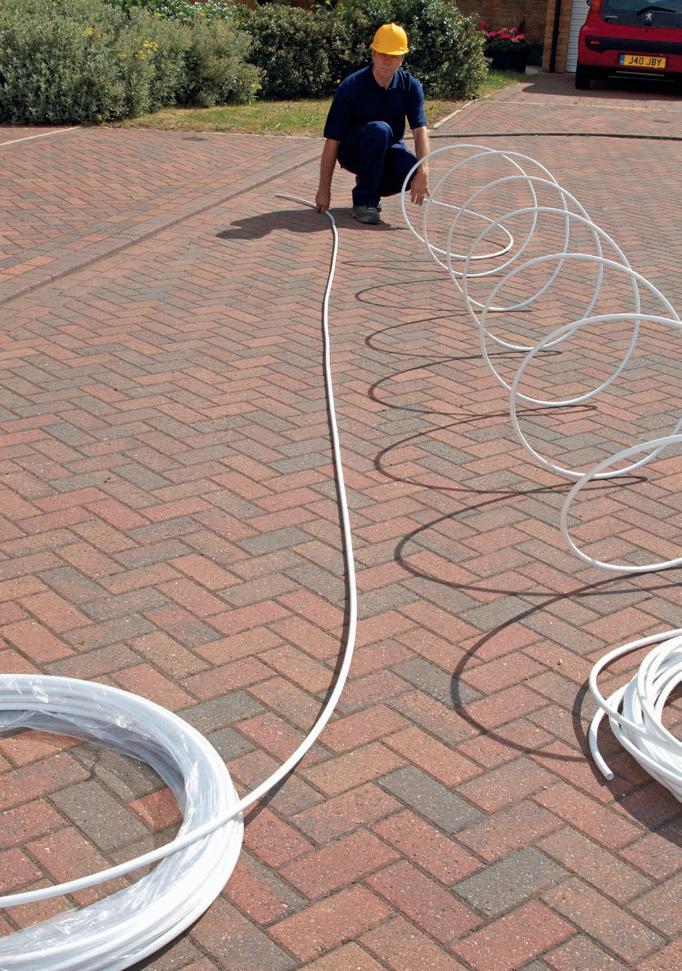
the pipe end rigid and circular. The pipe is then pushed into the fitting, passing through a metal grab-ring and an O-ring. The grab-ring secures the pipe and prevents it ‘blowing out’ under pressure and the O-ring provides the leak-proof seal – and of course modern plastic fittings are equally effective when joining either copper or plastic pipe.
Subsequent demounting is achieved by releasing the grab-ring and withdrawing the pipe.

Plastic push-fit systems are now commonly specified by RMI (repair, maintenance, and improvement) plumbers across a wide range of domestic and commercial applications. Additionally, new build plumbers are also using this type of system. 90% of all new houses constructed in recent years use plastic systems throughout their entire hot and cold water supply and central heating systems.
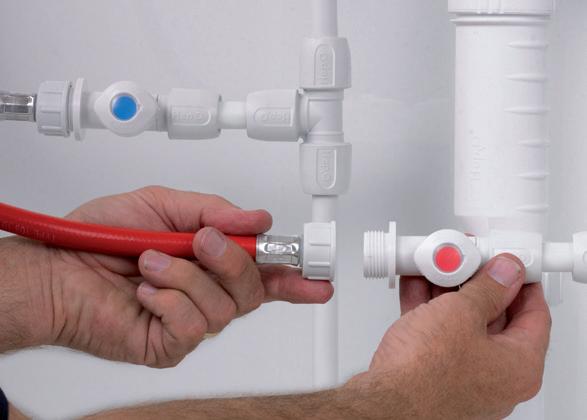
More and more plumbers are recognising that the benefits of plastic push-fit systems lie not in a direct price comparison of components, but in the speed of installation.

Plastic systems are quick to install, whether it’s a complex cabling system or a simple appliance connection.
The reason for the growth in popularity of plastic systems lies in the impressive list of benefits they offer over the more traditional rigid systems:
Plastic pipe is very flexible and can be ‘cabled’ in a similar way to electrical wiring, thus cutting down on the number of joints required
Fewer joints means less risk from leaks
Jointing is quicker which means installation time is dramatically reduced
There is no risk of fire because no open flame is used during installation and no Hot Permit to Work is required
Joints are easily demountable
All connections are made by handno tools are required
No tools means much easier to install in confined spaces
4 3 2 1 5 6 7 8
Most plastic push-fit systems can also be connected to copper pipework.
Research asked 1,059 experienced plumbers to estimate the time required to replace all the plumbing in an average bathroom with copper and then a second estimate using only plastic. The result is a six-hour (28%) time saving in favour of plastic. Therefore a normal 40-hour week for a bathroom installer using copper would reduce to 29 hours using plastic.
Providing basic manufacturers’ rules are followed, plastic push-fit fittings are the easiest, quickest and most cost effective of all plumbing fittings to use.
The only tool required to make joints is a specialist cutter for plastic pipe or a pipe slice for copper pipe. A hacksaw should never be used as any burrs on the pipe ends may damage the O-ring inside the fitting. They are also just as easy to demount – while different manufacturers have different demounting methods, they all share a common simplicity.

1,059 plumbers estimated that an average bathroom would take six hours less to renovate if plastic fittings were used instead of copper.

Plastic push-fit fittings are equally effective whether jointing plastic or copper pipe
With the appropriate pipe sleeve arrangement, only required for plastic, plastic push-fit fittings can be used on copper or plastic pipe as the chrome surface is too hard. To join chrome plated pipes, compression joints should be used.
The most significant development in plastic push-fit technology in recent years is Hep²O’s ‘Next Generation’ range of fittings, which features a number of new developments:
The new fittings are slimmer in size and have a much sleeker and more stylish design, which means they now look a lot neater and less intrusive when placed in visible locations.
Clearly, push-fit technology is continuing to move forward, largely driven by the same company that was so heavily involved in its original development back in the late 1970s.
For enquiries or to place an order contact 0800 038 0088, email info@hep2o.co.uk or visit hep2o.co.uk

Hep²O is the UK’s premier flexible push-fit plastic plumbing system for domestic hot and cold water supply, including potable water and central heating.
The Hep²O system is designed solely for professional users and is currently the most widely specified system in use here in the UK.
The system comprises flexible plastic ‘straight coil’ polybutylene pipework connected to fittings that incorporate an integral push-fit mechanism, making jointing quick and simple. And now offers 2 systems.
Unlike other similar types of coiled plastic pipe, Hep²O pipe utilises ‘straight coil’ technology, which means the pipe does not return to its coiled state when uncoiled from the SmartPackTM dispensers.
Instead, it remains straight but with no loss of flexibility, which makes it much easier to handle and ‘cable’ into position.
The result is a lot fewer joints and a significantly faster, safer and more cost-effective installation when compared to rigid plumbing pipe systems, such as copper.
For a series of ‘how to’ installation videos, scan this QR code.
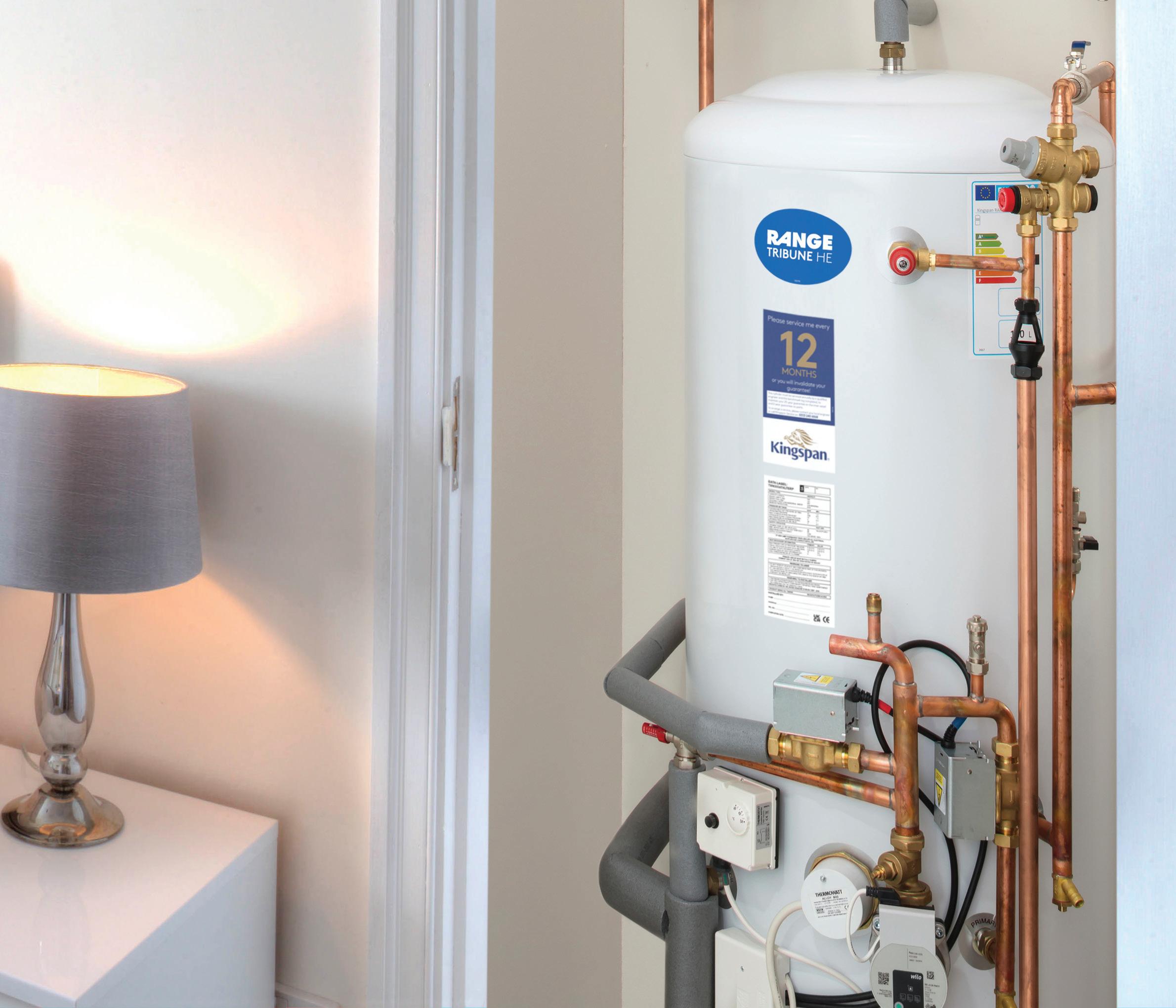
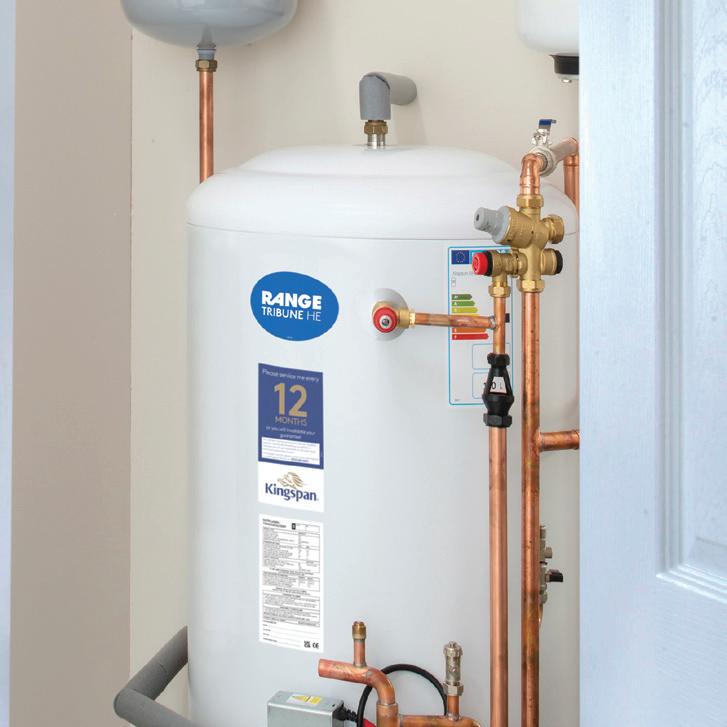
As the UK embarks on the largest home heating shift since the 1960s switch from town gas to natural gas, tomorrow’s plumbing and heating engineers will need a wider range of skills than ever before. Knowledge of both traditional systems – like combi boilers and vented cylinders –and renewable systems, such as heat pumps and solar, will be essential for a successful plumbing business.
“Hot water cylinders are essential to installing renewable home energy systems”
Being G3 qualified, and MCS registered, for plumbers and installers will give you a strong foundation. But what about your future customers? While some might be keen on having a renewable system, it might not be feasible for them right now. For instance, their roof could be facing the wrong way for solar, or heat pump options may not fit their budget.
Hot water cylinders are essential to installing renewable home energy systems. Even if they’re not yet ready to go fully renewable, customers can be prompted to consider a heat pump hot water cylinder, as its larger coils are also compatible with fossil fuel boilers. This means customers can enjoy the hot water storage benefits now and be renewable-ready for the future.
Turn over to learn more about different hot water cylinders and the types of systems with which they can be used.



STEP 1:
UNDERSTANDING CYLINDER TYPES:
VENTED OR UNVENTED?
> VENTED CYLINDERS
Vented cylinders were the traditional way to supply hot water in most British homes from the 1940s to the 1990s. A vented cylinder gets its cold water feed from a header tank and then uses gravity to feed the cylinder with its water supply.
Relatively speaking, vented cylinders offer poor performance in terms of water pressure.
> UNVENTED CYLINDERS
Unvented cylinders use the mains cold water supply. This allows them to provide high flow rates and mains pressure hot water (regulated up to 3 bar) and there’s no cold water tank in the loft.
They’re ideal for homes with multiple bathrooms, utility rooms and the like, as they can support multiple hot water outlets simultaneously. Modern unvented cylinders are very well insulated for minimum heat loss and come in a protective casing. Some have built-in thermal expansion (known as a ‘bubbletop’ cylinder); those that don’t, require a separate expansion vessel. Installers need a G3 qualification to


“Installers need a G3 qualification to fit unvented cylinders”
STEP 2:
> ELECTRIC IMMERSION HEATER
If the only option for the property is to heat the cylinder electrically through an immersion heater, you need to select a ‘direct’ cylinder.
When your customer has a conventional boiler as a heat source, select a standard ‘indirect’ cylinder.
However, if the customer is considering renewables in the future, a ‘heat pump’ or ‘solar indirect’ cylinder is also a good option – this could reduce installation costs in the long term.
When the property has renewable heat sources, select either a ‘solar indirect’ or ‘heat pump’ cylinder. A standard ‘indirect’ cylinder won’t work with a heat pump or solar – the coils in a heat pump cylinder are larger than in a regular cylinder.
The good news is that heat pump cylinders with flow regulators are designed to work with any of the leading heat pumps. If you’re specifying, that means you can split out the heat pump specification from that of the heat pump cylinder.
To install heat pumps, Microgeneration Certification Scheme (MCS) registration is essential. It’s an NHBC insurance requirement for installing zero and low carbon heating systems in new builds, and it’s also necessary to apply for the Boiler Upgrade Scheme grant.
When dealing with any unregulated heat source – like a solid fuel wood burner - or when there are multiple heat sources available, a ‘thermal store’ can provide the best solution.
“Heat pump cylinders with flow regulators are designed to work with any of the leading heat pumps”
Insulation will always be a winner for energy efficiency: in the loft, under the floor, on the hot water cylinder itself. Then there are regular or smart digital thermostatic radiator valves (TRVs) to help customers control heat room-by-room.
A well-insulated heat pump system requires the heat pump itself, a heat pump hot water cylinder, a buffer tank and space for installation.
Filters protect the heat pump and flow regulators allow the cylinder to be used with a wide range of heat pumps.
A buffer tank adds system capacity to improve efficiency of a heat pump, helping protect the compressor from overwork and costly failure. If a buffer tank is left out from a heat pump system, additional radiators might be necessary.
As heat pumps operate at lower temperatures than traditional systems, you may need to specify double-panel radiators instead of single-panel. However, fan convectors can provide a larger heat output for a smaller wall area.
Underfloor Heating (UFH) is another option and is ideally suited to heat pump systems.
Solar thermal systems need the solar collectors (roof panels) and a solar indirect cylinder. This is usually a twin coil cylinder, to allow connection to a back-up heat source for days when there’s not enough heat from the sun.
When choosing the cylinder capacity for your customers’ home, consider their future needs, such as planning to add an en-suite, or switching to renewables later.
When specifying any hot water system, there are trade-offs to be made between the amount or volume of water used, the amount of energy used and the time it takes to heat. In practical terms, if you use half the energy input to heat the water, it takes twice as long to heat.
Hot water in a cylinder is usually stored at about 60°C but is mixed with cold water down to a usable temperature. A bath using 100 litres of hot water at 40°C only equates to 60 litres stored at 60°C.
The Hot Water Association has used these insights and average water consumption to calculate the following guidelines:
▸ Low consumption = 20-30 litres per person per day
▸ Average consumption = 30-50 litres per person per day
▸ High consumption = 50-70 litres per person per day
“A bath using 100 litres of hot water at 40°C only equates
> SLIMLINE AND HORIZONTAL CYLINDERS
Slimline cylinders can fit through narrow loft hatches or into tight airing cupboards. Horizontal cylinders can overcome height restrictions. In both cases you’ll be compromising slightly on the cylinder’s energy efficiency, with a slightly higher heat loss.
Cylinders with built-in internal thermal expansion (known as 'bubble-top' cylinders) mean there's no need for a separate external expansion vessel.
With a large proportion of the plumbing work already done at the factory, a pre-plumbed cylinder can reduce on-site installation time by up to 70%.
Many customers might not realise that a hot water cylinder operates differently from a combi boiler. It's always a good idea to show customers how to use a cylinder in the context of their own heating system, and show them how to programme its heating cycle to meet their household needs. A quick tutorial from their trusted installer will equip them with the knowledge to get the best out of their heating system.

SCAN HERE
For more information.





“Nearly 40% of tradespeople say they would take on apprentices again”
If you're already on your apprenticeship journey, you're playing an important role in addressing the skills gap within the construction industry.
The 2023 UK Trade Skills Index reported that 937,000 new tradespeople will be needed by 2032 – that’s 2,170 new entrants every week! Your contribution is more essential than ever.
> POSITIVE OUTCOMES FOR APPRENTICES
In 2024, a survey by On The Tools found that 91% of UK tradespeople who completed an apprenticeship had a positive experience. Many have since gone on to mentor apprentices, creating a cycle of growth and learning. You’re not just building your career –you’re also helping others do the same.
While many apprentices have had great experiences, it’s important to be aware of your rights. Did you know that 40% of apprentices are unaware they’re entitled to 20 days of paid holiday each year, in addition to bank holidays? Make sure you're getting everything you’re entitled to.
If you need unrivalled advice from a trusted plumbing store or bathroom showroom, look out for The IPG.
With our national network of locations, you’ll find a great range of stock, and trusted advice to support you every step of the way. Your basket will likely be cheaper, too! It’s a win-win! Find your nearest store using the


“Demand for apprenticeships remains strong, with nearly 70% of learners considering a career in the construction industry”
Nearly 40% of tradespeople say they would take on apprentices again, demonstrating the long-term value of apprenticeship programmes. By sticking with your apprenticeship, you’re gaining invaluable hands-on experience, helping to close the skills gap, and setting yourself up for a fulfilling career.
Independent plumbing stores and bathroom showrooms, like those supported by The IPG, are key to the success of apprenticeships. Many of The IPG’s members offer support to apprentices through guidance, advice, and even opening new trade accounts to help you on your journey. This network of stores and showrooms can be invaluable as you progress. Keep pushing forward - you’re part of a movement that’s shaping the future of the trade industry.
* All statistics are from the Closing the Gap Report 2024 by On The Tools


“By sticking with your apprenticeship, you’re gaining invaluable hands-on experience”

When you’re new to the industry, it can be daunting to decide which merchant to choose. The IPG member stores offer expert advice, friendly support, and a wide range of trusted and upcoming brands.
Friendly service paired with expert knowledge
Nothing beats talking to an expert in an environment where you’re welcomed and encouraged to explore products firsthand. Dan, Director of Local Plumbing Supplies, said: “We pride ourselves on building lasting relationships with our customers. We want them to feel comfortable asking those ‘silly’ questions rather than struggling to find the answers on their own.”
Independent stores go the extra mile to source the most efficient and cost-effective products with quick turnaround times. A customer of IPG member The Plumbers M8 remarked: “I've never come into store and they didn't have what I needed.” Most independents have easy access to necessary products, ensuring a broader selection is always available for immediate collection or speedy delivery.
In a world increasingly dominated by large chains, independent businesses bring individuality and personal service to the high street. Marcus, Store Manager at Gas & Plumb Bits, said: “We will go the extra mile to provide customer service that’s unmatched anywhere in the industry.” Every sale is valued, and customers receive personalised attention that sets independents apart.

“We want them to feel comfortable asking those ‘silly’ questions rather than struggling”

The IPG is a membership group dedicated to strengthening the presence of independent plumbing stores and bathroom showrooms across the UK.
By supporting members with enhanced buying power, marketing materials, and digital strategies, The IPG enables these stores to collectively compete with larger mechants in the industry.

Many of The IPG members provide additional support and services tailored specifically for apprentices. From exclusive pricing and product tutorials to introductions to experienced plumbers and installers, group members are committed to helping the next generation thrive.
“It’s important for apprentices to have access to credit accounts, which we can provide”
“We work closely with our local college, offering students hands-on product experience”
Nick, Manager of G&M Plumbing & Heating, shares: “We work closely with our local college, offering students handson product experience in our store. We feel it’s important to start building those relationships early, giving them access to valuable advice and special discounts on tools as they build their kits.”
Starting a career in the industry can be challenging, and The IPG members understand the obstacles apprentices face. Steve, Owner of Newline Plumbing & Heating Supplies, adds: “It’s important for apprentices to have access to credit accounts, which we can provide – especially when many larger corporations won’t.”
To find your nearest store or showroom:




In the world of plumbing, heating, and renewable energy, working with reputable companies is essential.
Choosing to work with a trusted name in the industry can make a significant difference in the quality of your projects and in maintaining your professional reputation. Reputable brands can support you right at the start of your career, providing the tools, knowledge, and backing you need to excel.
For over 50 years, CORGI Services has been a cornerstone of safety and compliance within the heating, plumbing, and renewables industries.
Our commitment to upholding the highest standards ensures that tradespeople, homeowners, and businesses can operate with confidence.
In today’s rapidly evolving energy landscape, it’s crucial to stay informed about traditional safety protocols and advancements in renewable energy solutions, such as solar heating and heat pumps. By understanding the latest regulations and adapting to new trends, tradespeople can contribute to a safer, more efficient future.
▸ Safety and Compliance:
Ensuring that all aspects of plumbing and heating meet industry regulations.
▸ Renewable Energy:
Supporting tradespeople to stay ahead of emerging technologies like solar heating and heat pumps.
▸ Continuous Education:
Offering training to master gas safety and stay compliant with regulations such as electrical, asbestos, and fire safety.
At CORGI, we provide comprehensive support through our family of services, ensuring you have access to the expertise and resources needed to succeed.

“Reputable brands can support you right at the start of your career”

CORGI offers a range of specialist products and services to meet the needs of the plumbing and heating industry, each designed to elevate safety, quality, and efficiency. Here’s an overview of the key members of the CORGI family:
With over 40 years’ experience, CORGI Controls specialises in the manufacture and distribution of heating products. Their range of heating controls is designed for ease of installation, backed by one of the UK’s leading manufacturers.
Operating in the gas industry for more than four decades, CORGI Technical Services works with the government, manufacturers, and industry experts to improve gas safety in the UK. Their highly experienced team provides total gas safety solutions.
CORGI DIRECT:
Supporting professional tradespeople for many years, CORGI Direct supplies Gas Safe licensed forms and labels, along with tools and workwear. They also partner with City and Guilds to provide students with CORGI technical manuals for gas engineering courses.

“Trust CORGI to deliver the highest standards in safety, quality, and innovation”









This scheme brings together qualifications, certified operatives, and companies in the fenestration industry, including manufacturers and installers of windows, doors, and other glazing products. CORGI Fenestration ensures safety and quality standards throughout the supply chain.
Specialising in the installation and servicing of home heating systems, including boilers and central heating, CORGI HomeHeat aims to provide efficient and environmentally friendly heating solutions to homeowners.
A home maintenance plan service offering coverage for boiler repairs, plumbing, electrical services, and home emergencies. CORGI HomePlan provides peace of mind with reliable home services.
A vehicle leasing service catering specifically to tradespeople, offering a wide range of commercial vans. CORGI Vans negotiates special deals with manufacturers to bring the best selection at competitive prices.
CORGI PAY:
This financial services arm offers payment solutions to simplify financial transactions for small businesses and tradespeople. CORGI Pay helps streamline financial management for professionals working in the heating and plumbing industries.




By working with CORGI, you’ll benefit from decades of experience and a trusted reputation across multiple sectors within the heating, plumbing, and renewables industries. Whether it’s gas safety, renewable energy, or vehicle leasing, CORGI is dedicated to supporting tradespeople at every stage of their professional journey.
Let CORGI help you maintain the highest standards of safety, quality, and innovation in your work.


“CORGI is a brand that the trades and public have come to know and trust”



SCAN HERE
For more information about how CORGI can help you.




As an apprentice or newly qualified plumber - or any professional tradesperson for that matter - your formative years will be spent learning the skills and techniques that will shape your career.
Developing a reputation for quality, long-lasting repairs can help build trust with both clients and supervisors. Whether you're fixing leaks under sinks or mastering the ins and outs of heating systems, every task demands precision, efficiency, and the right tools.
While much of the focus might be on wrenches, pipe benders and screwdrivers, there’s another key tool that’s often overlooked but can make a significant difference, especially when time is of the essence. We are, of course, referring to WD-40 Specialist® products.
“Nothing's
worse for a tradesperson than a tool that lets them down in the middle of a job”

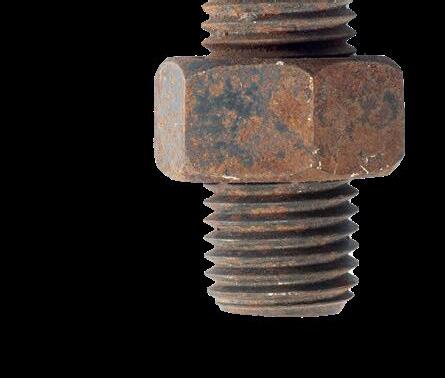











WD-40® is a brand that needs little introduction. Their iconic Multi-Use Product is renowned for its versatility in lubricating, protecting, and displacing water and moisture. However, their Specialist range offers seven products specifically developed for professionals and industrial use: White Lithium Grease, Spray Grease, Silicone, Contact Cleaner, Penetrant, Degreaser, and Cutting Oil.
Whether faced with threading pipes or removing fixtures for access, friction can be a big enemy. Rusty screws or tight fittings can slow down a repair job. In the worstcase scenario, a broken bolt can bring the entire process to a halt. This is where WD-40 Specialist Penetrant proves invaluable. With its extremely low surface tension, it cuts through rust, seams, and tightly bonded threads, allowing it to easily saturate and lubricate - freeing up the problem effortlessly.
For any electrical tasks, such as working on circuit boards or thermostats, WD-40 Specialist Contact Cleaner is essential. This fast-drying, non-conductive spray is suitable for even the most delicate electrical components, switches, and connections. It quickly removes dirt, dust, condensation, and flux residue, ensuring smooth electrical performance.
In plumbing, especially in older buildings, corroded pipe fittings can present challenges. A quick spray of Penetrant can break the bond caused by years of rust and corrosion build-up, making disassembly much easier.

All Specialist products come with the WD-40 Smart Straw® applicator, giving you two ways to get the job done. Flip the straw up to precisely target hard-to-reach areas, or flip it down for a wider spray to cover larger surfaces.


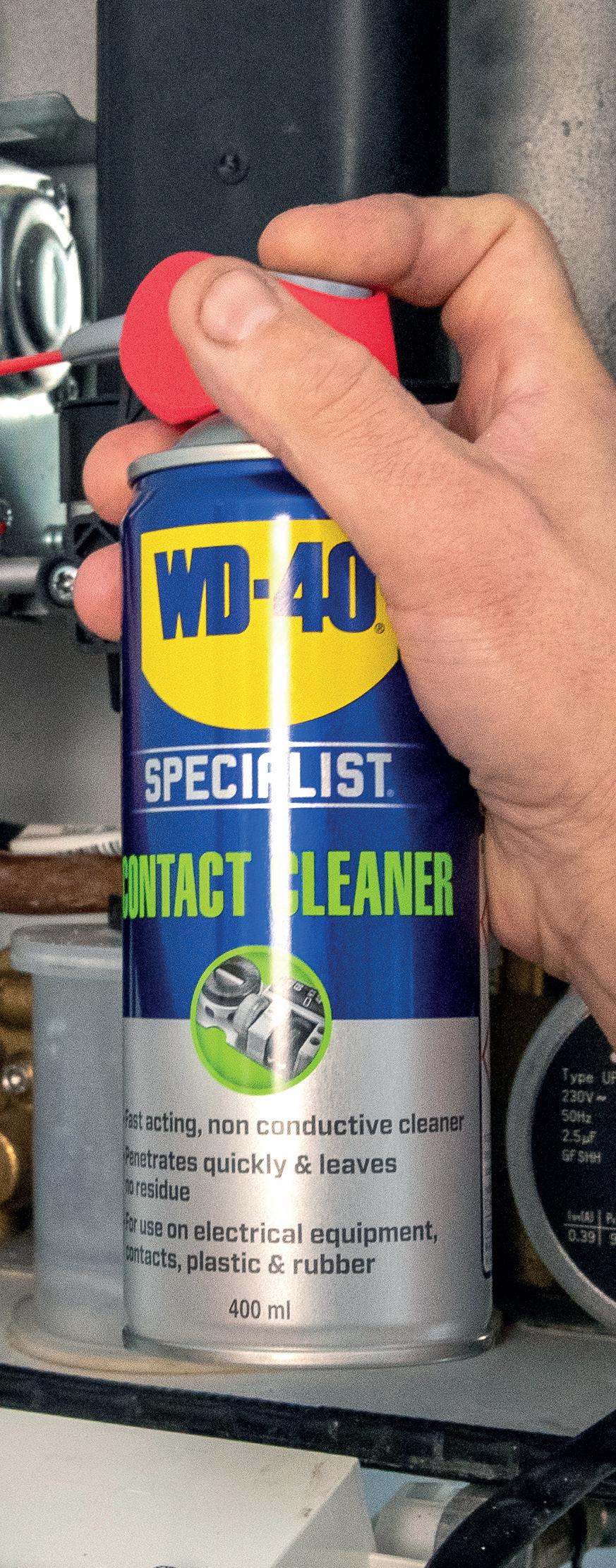
WD-40 Specialist products offer added protection during installations, services, or repairs, ensuring that your work stands the test of time.
▸ Specialist White Lithium Grease provides robust protection for heavyduty, metal-to-metal applications. This thick, water-resistant formula sticks securely to surfaces, delivering long-lasting lubrication.
▸ Specialist Spray Grease offers a non-drip formula, providing long-lasting lubrication and corrosion protection on all metals, including vertical surfaces. It combines the classic WD-40 MultiUse Product base with enhanced adhesion properties, making it highly water-resistant.
▸ Specialist Silicone is a highperforming silicone spray lubricant ideal for high-pressure equipment. It's perfect for rubber parts like pipes and plumbing fittings, repelling dirt, oil, and general grime to keep parts clean and functioning longer.
▸ Specialist Cutting Oil is designed to vastly improve the performance and extend the life of all cutting and drilling tools. Whether cutting through wood, stainless steel, or titanium, it prevents pitting, metal seizures, and reduces heat damage caused by friction.



More homeowners are turning to advanced technology to micro-manage their heating, especially with the ever-rising and unpredictable energy prices. Smart heating systems allow owners to precisely control their heating, particularly when paired with electronic temperature control valves. Being able to adjust the temperature of each room from your smart device is undoubtedly the future of heating management.
While these systems are often marketed as simple to install, it’s always advisable to consult a professional.
Swapping the individual radiator units is made easier with the help of WD-40 Specialist® White Lithium Grease which ensures that the essential 'pin-like' plunger in the valve moves freely.
>
1 2 3 4
Unscrew the cap covering the valve.
Spray a dab of White Lithium Grease onto the plunger.
Depress the ‘pin’ several times.
Replace the cap with the correct adapter provided, then screw the replacement valve head into place.
> CONCLUSION: TRUST IN THE RIGHT TOOLS
WD-40 Specialist® products offer reliability, precision, and protection, making them indispensable in a tradesperson's toolkit. Whether you're tackling stubborn fittings, delicate electronics, or installing smart heating systems, these products ensure your work is efficient and long-lasting.
“This high performance White Lithium Grease spray provides great protection for heavy-duty, metal-to-metal applications”
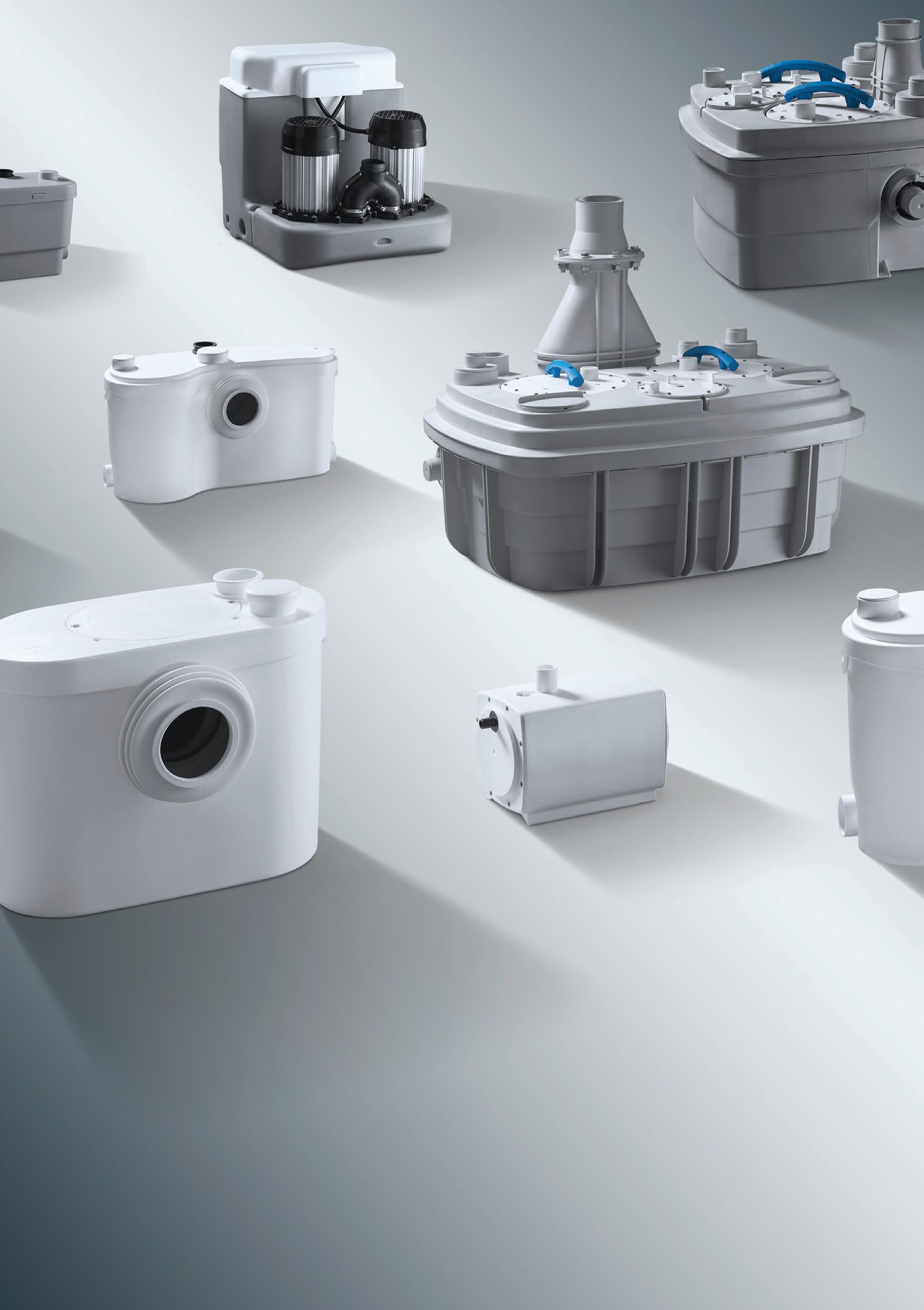
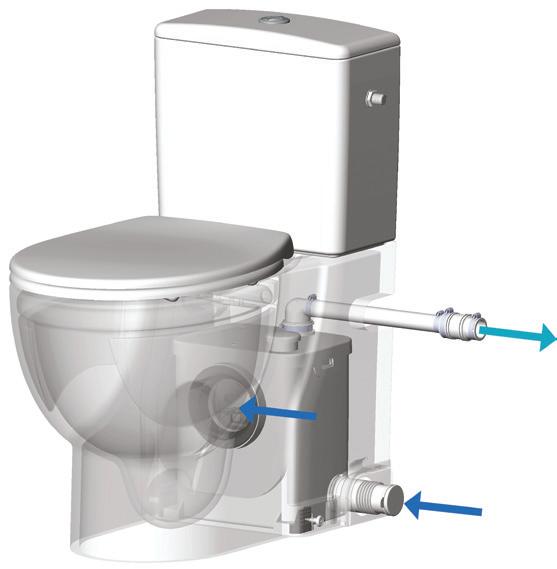
The macerator was pioneered by Saniflo over 60 years ago and introduced into the UK over four decades ago. The range has grown from a single product to over 80 pumps and lifting stations, each designed to discharge waste from situations where gravity can't. Whether it is a domestic or commercial space, an outbuilding, garage, loft or basement, there is always a solution from Saniflo.
Macerator is a pump featuring a cutting blade that grinds up solid waste into a pulp for discharge through small bore pipework to a drain pipe. Macerators generally fit to the back of a toilet pan or behind a wall panel and, dependant on model, can take waste from either a single WC or a combination of WC, basin, bidet and shower depending on the nature of the installation.
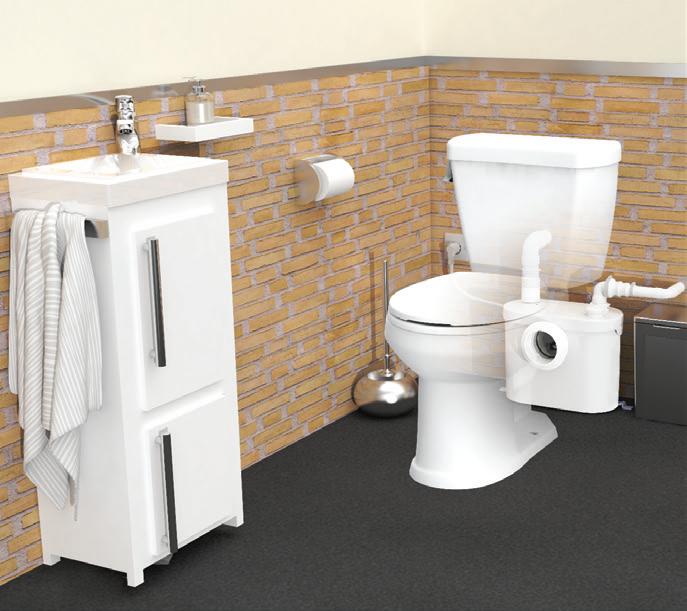
Units that pump grey wastewater from sinks, dishwashers, showers, washing machines, wine coolers, ice machines etc, through small bore pipework.

Lifting stations are pumps that are used when waste needs to travel upwards – i.e. lifted away. They can be used for grey or black waste and can be specified with either macerator blades or a vortex system. Lifting stations can be floor standing or underground.

Caveat: Terminology can vary by manufacturer. Always check the product description and specification when deciding which product to use.

Over 60 years experience


Tight fitting toilets
40+ range


Basement bliss
Up to 5 years warranty

Loos into lofts, dishwashers downstairs, bathrooms in basements – they’re all impossibly easy with Saniflo.
Our macerators and pumps open up more opportunities and help you make the most of every space.
1
According to UK Building Regulations, Part G4, macerators may only be used in a dwelling where there is access to a gravity discharging toilet. This is in case there is a power failure to the building, as the macerators will not work and the regulations say that a toilet must still be available.
2
Due to back-flow issues, the UK Water Byelaws dictate that if you have a complete bathroom that needs pumping, including a bath, shower, toilet and wash basin, the bath must be pumped separately using a grey water pump and the toilet, wash basin and shower must be connected separately to a macerator.
Macerators, pumps and lifting stations are used when the nearest soil stack, drain, water treatment plant or septic tank cannot be reached by gravity. Sometimes access to the mains drains is simply too difficult, complicated or costly and a pump provides the most efficient solution. In general gravity drainage requires black water waste pipes that are a minimum of 100mm diameter installed on a 1 in 40 fall; allowing solids unrestricted flow to a manhole.
If this criteria cannot be met, a pumped solution can enable waste to be discharged through small diameter pipework installed vertically and horizontally to lift waste up and along to the nearest soil stack, drain or waste treatment plant. Today there is a huge choice of products on the market so that every job – whether in a domestic or commercial setting – can be matched to the most effective solution.
“when correctly installed macerators and pumps are no louder than a toilet flushing”

Follow this simple guide for the perfect Saniflo installation.

Saniflo offer a complete range of pumps and macerators for all applications.
Macerators may only be used in a dwelling where there is access to a gravity discharging WC (Building Regs G4)
Saniflo has developed one of the most comprehensive ranges of pumps on the market to ensure there is a solution for every type and size of project.
Saniflo is well known for its range of domestic macerators and grey water pumps that have been helping to add extra facilities in properties up and down the UK since 1979. From the original Saniflo macerator, that enables the connection of a single WC, to the Sanibest which can discharge waste from a WC, basin and shower, there are also models for wall hung sanitaryware and for bathroom furniture installation. Grey water pumps including Sanifloor+, Sanishower+ and Sanivite+ discharge grey water waste from showers and kitchens respectively.

For light and heavy-duty commercial applications Saniflo solutions include the Sanicubic, Sanifos and Zehnder pump range to provide whole property waste solutions, as well as a range of condensate pumps for boiler and aircon system waste removal and submersible pumps to clear flood and rainwater.

Saniflo continuously develops its range and one of the latest developments is the introduction of brushless technology for models in the Sanicubic range of lifting stations. This advanced technology improves motor lifespan, product efficiency and reliability by eliminating the electrical connection to the spinning motor which can create heat, friction and noise. It further offers an energy saving of up to 30%, better grinding quality thanks to high torque and lower noise.

The latest developments in Saniflo’s commercial product range include the introduction of the largest floor-standing lifting station – the Sanicubic 2VX – and the Sanifos range, which is designed to be sited outside and underground.
Is available in single and three-phase versions and features a vortex pump. It is ideal for commercial premises and has an alarm plus two easily removable motors for servicing.
Offers the option of a macerator or a vortex system and is used where drainage is too low for a sewer or surface-mounted pumping station. Both single and three phase options are available and these units can be used to pump residential and industrial waste.
For more information visit www.saniflo.co.uk

OFTEC is one of the leading competent person registration scheme. It’s the name customers look for when selecting a technician, making registration with OFTEC the best way to demonstrate your competence and win new business.
You can register with OFTEC for:
• Liquid fuel • Solid fuel • Solar thermal • Heat pumps
• Biomass • Non-operative • Electrical (Part P)
Registration includes a range of benefits:
• Searchable online listing of registered businesses.
• Self-certification of installation work*.
• Free technical support by phone or email.
• Access to exclusive 'technician hub'.
• PAS2030 • TrustMark •MCS getApprentices one technicianyear’s registration FREE
• Discounts with selected partners.
*In



















Choosing the right merchant can be a nerve-racking experience, especially for those new to the industry. Below are the key benefits of choosing a reputable plumbing and heating merchant.

Plumb Centre’s trade counters have served customers throughout the generations, and many of our younger customers who use us today do so through recommendation. Our unique position as a key supplier of all mainstream manufacturers, along with our specialist-trained branch staff who are ideally placed to provide guidance and advice on products and installations, means that for many of our customers, we are an extension of their office and their knowledge. We play an integral role in their businesses, and our aim is simple: to help customers run more profitable businesses.

“Staff are ideally placed to provide guidance and advice”























Product availability is one of the main reasons customers do business with merchants. At Plumb Centre, we constantly analyse the market and the requirements at a national, regional, and local level to get the stock profile of each branch right, at competitive prices. This ensures customers always find the product they need, and with our website fully stocked, we are never far away.
2 3
Not only do merchants offer the chance to purchase all necessary products under one roof, but by using a merchant, installers can make sure they are only purchasing genuine parts from reputable manufacturers. It is not always easy to tell if a product is non-genuine, especially when buying online. While it can be tempting to consider a low-cost alternative from an unfamiliar supplier, the use of nongenuine parts can present a serious risk, not only to the customer’s safety but also to an installer’s reputation.
The best way to ensure the quality of the products is to use only reputable merchants who stock directly from manufacturers.





For installers, time spent travelling to get the parts and materials they need is time that can’t be spent on the job, earning them money. That’s why choosing a merchant that offers services that suit the way you want to shop is key. From same-day delivery, click and collect within 60 minutes, and delivery tracking, a good merchant will provide all these services and deliver direct to site or to a customer’s home if required, saving the installer valuable time collecting the products from store.
“While it can be tempting to consider a low-cost alternative from an unfamiliar supplier, the use of non-genuine parts can present a serious risk”
Merchants can be especially valuable to an installer with regards to their product knowledge and are happy to provide support, expertise, and advice to installers. Plumb Centre works in partnership with its suppliers to ensure its staff are trained across all product ranges.
It is also vital that installers keep up-tospeed with current legislation, technological advancements, and best practices. For installers looking for assistance in any of these areas, a merchant is an ideal place to start. Free manufacturer courses and product training are also available to keep their knowledge up to date. As well as product ranges, training can cover current trends and market drivers, such as renewable technology and smart controls.
6

Finding new and better ways to do business is a challenge for installers. That’s why choosing a merchant with a strong digital offering can make the difference when managing your business on the go, or at the end of a long workday. Plumb Centre’s digital development has been a key investment area, and we have sectorleading support tools such as ‘Manage My Account Online,’ ‘My Most Ordered,’ ‘Order Status,’ and ‘Quote Creation,’ which can all help installers save time and hassle by working more efficiently, having the right information when needed, and reducing manual processes, in turn helping installers offer better service levels to their customers.
7
Where merchants have on-site showrooms, installers can make use of these facilities to introduce their customers to the products on offer. With full inhouse bathroom design services and 3D CAD drawings available to installers, customers can envisage their bathroom plan easily, making your business look very professional.

“We have introduced a team of Digital Experts in Plumb Centre to offer support to installers on how to make best use of our digital services”
For new installers, it is important to remember the advantages of using a specialist merchant. From support and advice to ensuring work completed is compliant and products are fit for purpose, merchants offer a unique and valuable resource to the industry.
Our promise is to be your No.1 choice by offering all the products, parts, and specialist services needed, whilst helping you run profitable and sustainable businesses of the future.
For further information.






The UK Government has set a target of achieving net-zero carbon emissions by 2050. One way to achieve this is by introducing carbonfree heating to 25 million existing homes that need upgrading.
As future trusted tradespeople, your customers will look to you for expert advice. So, with this in mind, why are water-based overfloor heating systems becoming so popular?
> WHAT IS OVERFLOOR HEATING?
Unlike underfloor heating (UFH), where heating elements are buried in screed, overfloor heating sits between a building’s structural base and the floor finish. This offers homeowners all the benefits of a water-based UFH system, without the need to dig up floors. It’s ideal for both renovation projects and new builds where rapid heat-up is desirable.

> KEY BENEFITS:
▸ Operates at low water temperatures (30-45°C).
▸ Cuts energy usage by 25% vs. radiators, 60% vs. electric UFH.
▸ Maximises efficiency with all heat sources.
▸ Ideal for heat pumps and future CO2free heating.
▸ Frees up 15% more space by removing radiators.
▸ Warms up quickly and are easy to control, unlike screed systems.
▸ Installs quickly with no screed drying or floor joins.


Many think larger radiators are the only option for introducing carbonfree heating to existing buildings, but this isn’t always practical for homeowners with limited space.
Overfloor systems provide a comfortable, efficient, and futureready alternative, aligning with the UK’s net-zero goals. Unlike radiators, which circulate heat up to the ceiling and around the room, they gently release heat from the floor, evenly warming rooms at lower water temperatures.
Although primarily used in renovation projects, overfloor systems are also gaining popularity in new builds for their faster heatup times.



Overfloor systems typically include pipes, fixings, manifolds, and controls. High-density panels are commonly used to hold pipes in place, distribute heat, and provide a base for floor finishes. Insulating panels prevent downward heat loss and should include a conductive layer on top (e.g., a thick aluminium cover). Conductive panels (e.g., cement, gypsum) spread heat but require insulation beneath - increasing floor height, time and cost.
Some systems use castellated panels with a thin screed, but this adds time, cost, and weight on suspended floors without significant benefits unless extra insulation is added.
When comparing systems, consider cost, ease of installation, performance, and the availability of ongoing supplier support.

“Overfloor heating can reduce energy use by 25% compared to radiators”

Wunda Group PLC has been manufacturing and supplying underfloor heating systems since 2006 and pioneered overfloor heating in the UK over a decade ago.
Renowned for quality and support, Wunda is the go-to choice for tradespeople who want reliable systems, smart controls, and the assurance that their customers are in safe hands for years to come.

> RAPID RESPONSE SYSTEM
Wunda’s Rapid Response system is particularly popular. The panels are lightweight yet robust, made of highdensity EPS and coated with a thick aluminium layer. This makes them easy to handle, cut, and suitable for any floor finish, with approvals from Mapei, Ultra, and Norcross for direct tiling.

PREPARE THE AREA: Ensure the subfloor is clean, flat, dry, level, stable, and structurally sound. Remove doors and skirting boards.

LAY THE PANELS according to your layout plan and bond them using quickdrying adhesive.


ROUTE ANY NEEDED CHANNELS

RUN THE PIPES in the channels according to your bespoke layout plan.

ASSEMBLE AND FIX THE MANIFOLD to the wall.
“Wunda is the go-to choice for tradespeople who want reliable systems”
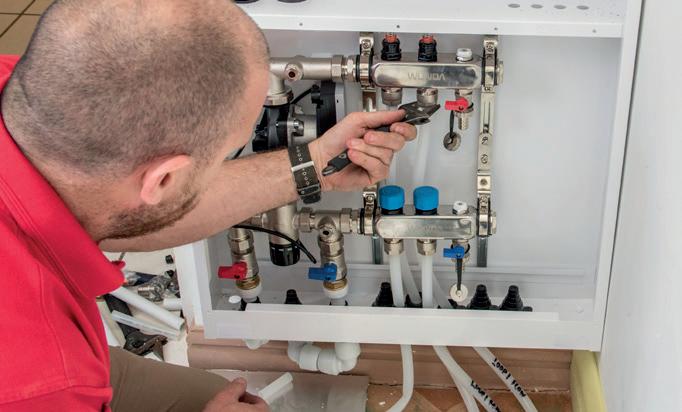
ATTACH THE PIPES and perform a pressure test. Typically, 50m² ground floor is ready for the floor finish in just two days.
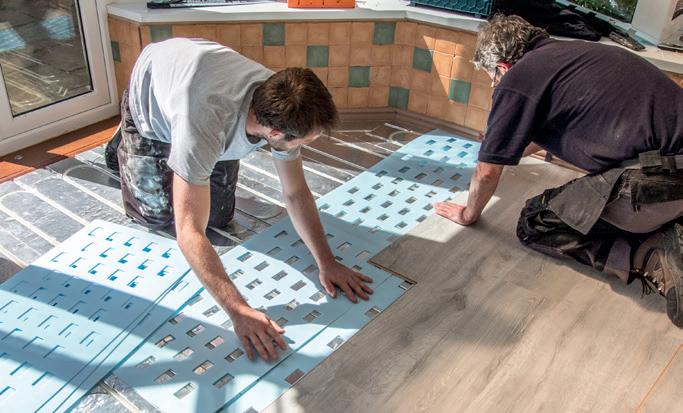
LAY THE FLOOR FINISH according to the instructions.

COMMISSION THE MANIFOLD to the heat source and connect final electrics.
SCAN HERE For further information.
HEATING SPECIALISTS SINCE 2006
Wunda is the go-to UK manufacturer & supplier for professionals looking for:
Easy to use, hassle free service & systems
Peace of mind - premium, reliable components
Bespoke system designs
Long term guarantees and unbeatable, quick customer support

I would say that Wunda’s components are on the commercial end…They’re a very good product for the money.
- Patrick Whitehouse, Heating & Plumbing Engineer

Our bespoke, high-performance systems are designed for effortless installation and premium, hassle-free use. With a dedicated UK-based support team available six days a week, Wunda is your reliable partner, supporting you and your customers for years to come. Choose Wunda for unparalleled ease, performance, and ongoing support.






Major updates to Part L came into force in 2022 as part of a plan to increase the energy efficiency of our homes and, in turn, decrease the carbon emissions they produce.
The changes covered numerous elements of a heating installation - such as the heat source, emitters, insulation, and more - with an overall aim to reduce a home’s carbon emissions by 31%.
Achieving this goal will play a significant role in reducing the sector’s impact on the environment while also enabling residents to benefit from lower energy bills due to less reliance on imported fossil fuels.
The regulations outlined in Part L are intended to act as a precursor - or stepping stone - to the Future Homes Standard (FHS), which is set to come into force in 2025.
The FHS represents a major step forward for the residential market in helping the UK achieve its net-zero targets. It has been designed to ensure that, on average, new homes produce at least 75% fewer CO2 emissions than homes built to previous energy efficiency requirements.

“Future Homes Standard (FHS) is set to come into force in 2025”



The most significant change within Part L is that any new heating system - in either a retrofit project or a new buildneeds to be designed with a maximum flow temperature of 55°C or lower. It is important to note that, while previous versions of the Building Regulations applied only to new builds, the 2022 updates also cover existing homes.
All newly installed or fully replaced wet heating systems in existing homes must be designed to meet a maximum flow temperature of 55°C, or at least achieve the lowest flow temperature possible while still meeting the heating needs of the property.
To achieve this lower temperature, installers need to carefully consider the options. For example, some radiators will need to significantly increase in size to emit enough heat at a lower temperature, which may cause space and aesthetic issues.
A practical solution is to opt for alternative emitters that are designed to run efficiently at the lower temperatures specified in the new regulations. Underfloor heating is an obvious option, as it covers a greater surface area, allowing it to operate at lower temperatures between 3355°C instead of the usual 75°C. This means that the demand underfloor heating places on energy sources is significantly less, making it ideal for use with low-temperature heat sources and renewables, such as heat pumps.


“All newly installed or replaced wet heating systems must meet a max flow temp of 55°C”



Compliance with the new legislation will help to decarbonise our housing stock and will also reduce wasted heat and improve the efficiency of our heating and hot water systems. This will benefit not only the environment but homeowners' wallets too. However, it goes without saying that many aspects of the new regulations will have a significant impact on how engineers design and install systems in both new build and retrofit projects.
In the long term, there is no doubt that we will all reap the benefits of more sustainable methods of heating our homes. For now, the key thing installers need to do is familiarise themselves with the recent changes to regulations and explore new methods of heating that will help reduce the carbon emissions of homes across the UK before the FHS becomes mandatory in 2025.
“The new regulations will have a significant impact on how engineers design and install systems”
SCAN HERE
For more information.
The PolyPlumb® push-fit range, a trusted staple in residential plumbing for over 25 years, has been relaunched with design upgrades and enhanced features, including patented In-Cert® technology.
> ENHANCED COMPATIBILITY
The updated range from Polypipe Building Products is compatible with both Polypipe Plumbing & Heating pipes as well as copper pipes, making it suitable for most hot and cold water supply and heating applications.
> IMPROVED JOINTING WITH IN-CERT® TECHNOLOGY
PolyPlumb® Enhanced now includes our patented In-Cert® technology, providing installers with greater jointing assurance through haptic feedback. The 360º wave feature within the In-Cert® head engages with projections inside the socket to align and centralise the pipe.
The distinctive haptic click ensures confidence - simply push the pipe home, twist, and know the job is done: push, twist, know

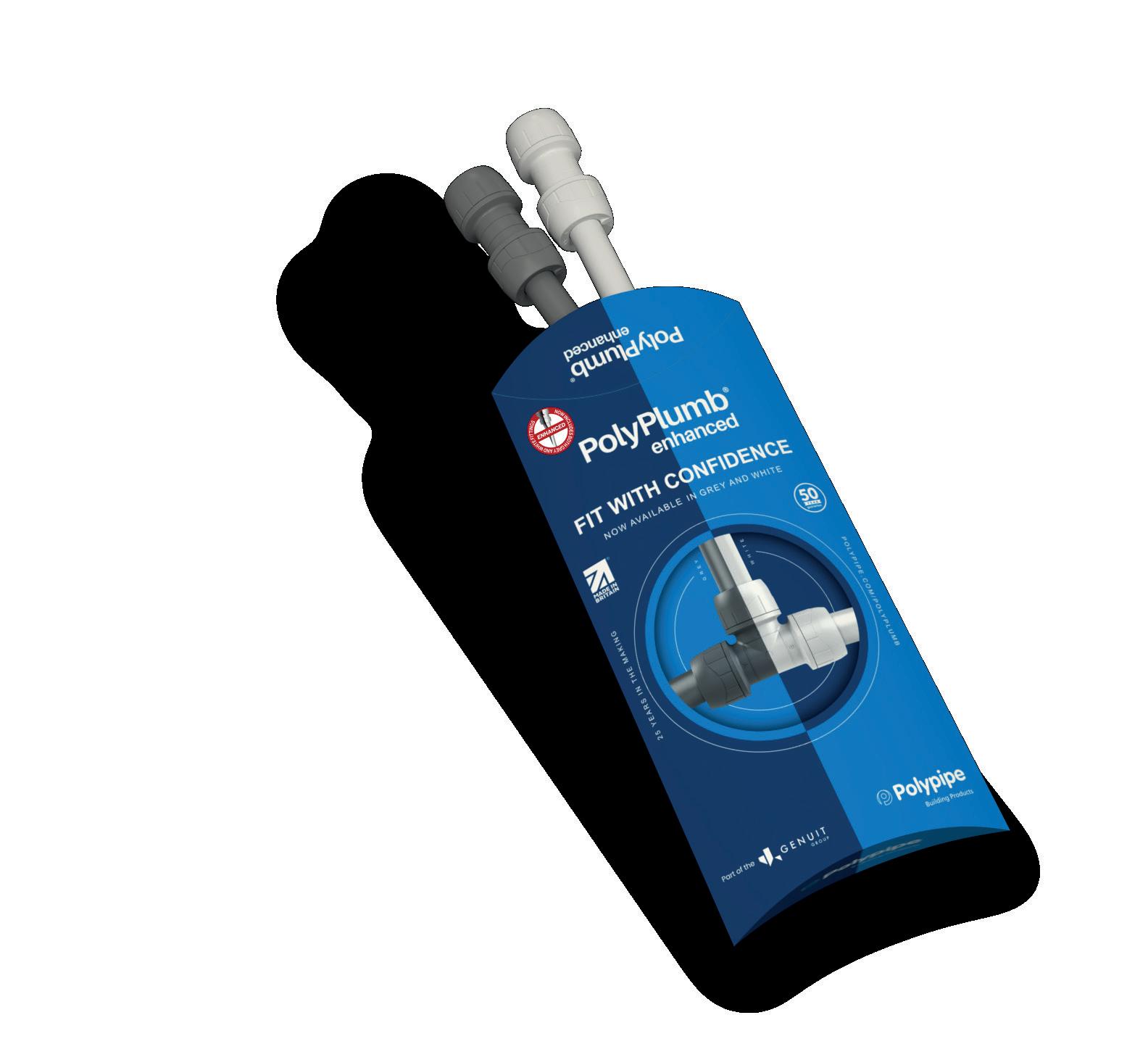
To request a free sample pack.


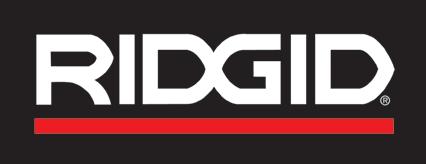

Having a reliable pipe inspection system on the van is an essential part of any plumber’s toolkit. To help you choose the right system, taking some time to research and consider all the options is vital, and could save you money in the long-run.
> PRICE V’S ROI
Price and ROI (Return On Investment) are often the first things taken into consideration. Price is certainly an important factor, but typically less expensive reels are smaller and meant only for smaller-sized pipes. Taking some time upfront to think about the job sites you mostly visit, and the size of pipes typically found there can go a long way in preventing unnecessary repairs and will help you maximise ROI.
> PIPE TYPE & SIZE
What are the pipe types and sizes you most frequently see on the job site? By answering this question, you will already know if most of the work takes you to “residential” type systems or “industrial” ones.
▸ Residential systems are smaller in size, have more bends, and usually start from 32mm up to 150 or 200mm. In this range of pipe sizes, RIDGID offers two system types for different pipe capacities and with different cable flexibilities.
▸ If you mostly work in laterals with multiple bends, you probably want a moderately flexible push cable to negotiate those bends, yet able to push far enough so you can have the entire pipe inspected.
▸ If you mostly work in larger diameters with longer straight runs, you probably better opt for a larger system equipped with a stiffer push cable.
Working with a cable too flexible for the pipe size you’re inspecting, may cause the camera to turn on itself and kink, or when it has a smaller camera head, you may not be able to see the entire inside of the pipe, which leaves you unsatisfied with the performance of your equipment.
“A reliable pipe inspection tool is an essential part of any plumber’s toolkit”

SeeSnake NANOreel Inspection Camera

RIDGID revolutionized the global market by introducing press technology in 1999. Since then, our range of press solutions has expanded to an IMPRESSIVE offering of battery hydraulic tools and compatible jaws.

Durability is an important factor to consider when you’re selecting the right pipe inspection system for the job. For demanding job sites need a specific camera that is built for that jobthe RIDGID SeeSnake equipment is designed to be used in the underground environment.
Originally designed for deep-sea applications, the RIDGID camera heads are built from hardened stainless steel casing for longterm durability. The lenses are multi-element sapphire crystal, a material that is highly resistant to scratching and impact. This unique design provides a superior clarity in-pipe. The camera heads are compactly built and in line with the spring to allow passing in bends and fittings and limit the risk of getting stuck.
One of the other big advancements in recent years has been the ability to share content more easily through various data transfer methods. Recording to a USB drive is still common on many systems, but the challenge is getting the device into the hands of the decision-maker (home/ business owner, supervisor, inspector, insurance).
RIDGID SeeSnake systems take it even a step further and make it possible to live stream data on additional connected devices. This way, your job colleague can follow from a distance away from where you are inspecting the line. That enables your colleague to guide you or perform some additional diagnostics like tracing the cable or locating the camera head.
“Durability is an important factor to consider when selecting the right pipe inspection system for the job”
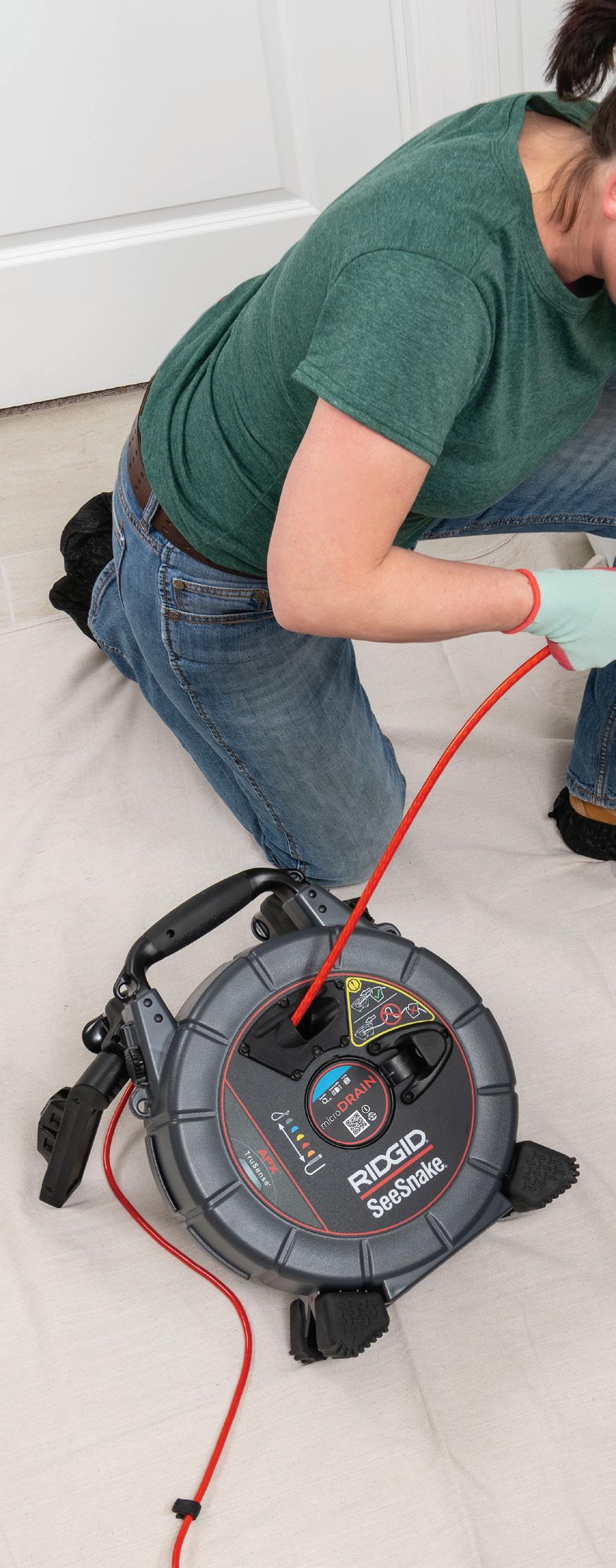

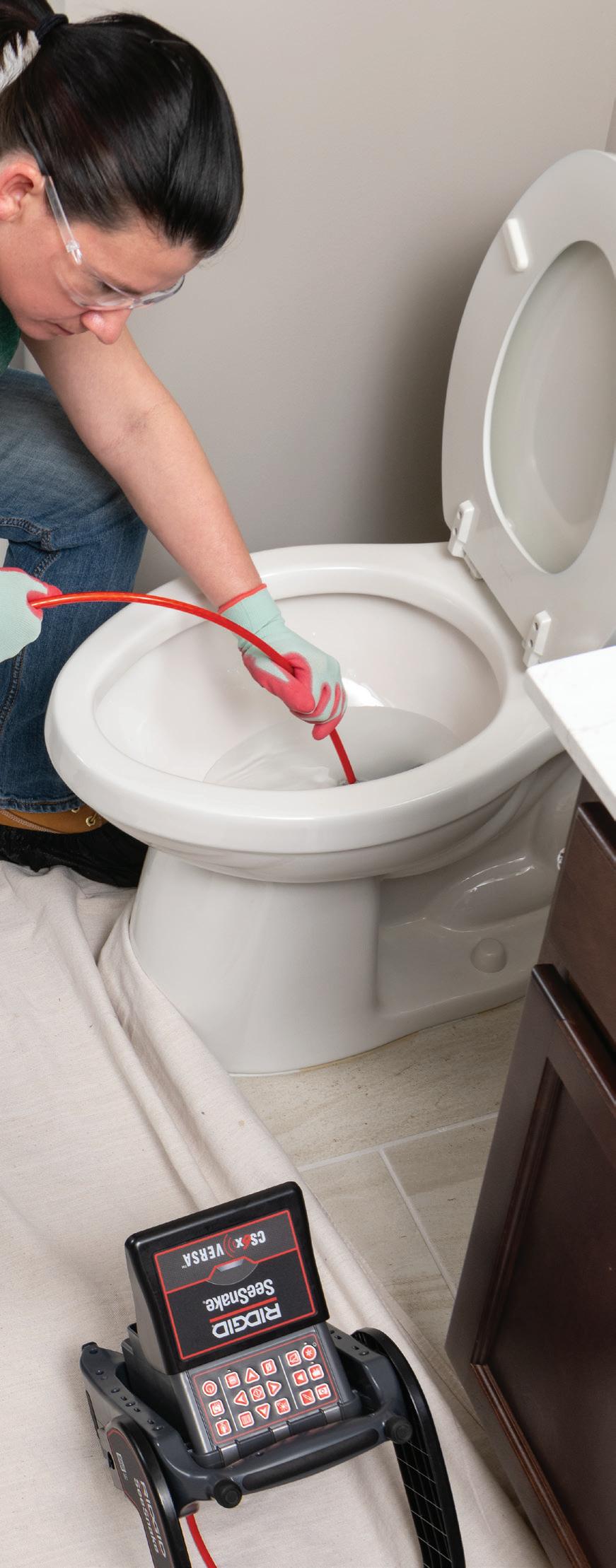
Many plumbers initially start with purchasing only the reel and monitor. Investing in a locator should also be on the list, to have a complete system. The reel and monitor will let you view and show customers any issues you find, while the locator lets you know where and how deep to dig. Systems from the same brand are designed to work seamlessly together and offer you additional job site efficiency.
“The reel and monitor will let you view and show customers any issues you find”

NaviTrack Scout Locator


When you are a plumber, your working days are usually busy and filled with challenges. To tackle all the jobs efficiently, you need a well-organised toolkit you can always rely on.
Here’s what a plumber’s toolkit should include:

Whether you operate in commercial or residential business, you need wrenches which come in different sizes and materials. RIDGID offers more than 15 models of wrenches (sizes 6”- 60”), which cover multiple applications, including accessing pipework in tight spaces.

> PRESS TOOLS
Press tools are a must-have, as their flameless technology eliminates welding, sweating, brazing and grooving. The full line of RIDGID press tools guarantees secure wet or dry press connections, on press copper, stainless steel and PEX, on existing or brand-new HVAC systems.

> PIPE CUTTERS
Whether you cut, install or replace piping, you need a pipe cutter suitable for the job. If you are looking for an all-in-one solution, the RIDGID PC116 Tubing Cutter is the go-to tool.
> PRESSURE TEST PUMPS

Pressure test pumps are perfect for use in heating, compressed air, refrigeration systems, sprinkler systems and other small bore pipe installations. The RIDGID 1450 Pump tests
hydraulically for leaks in installations that are required to be leak proof.

> GAS DETECTORS
Gas leaks can cause dizziness, kill houseplants, increase utility bills or even lead to destructive explosions and other serious problems. The RIDGID CD-100 Gas Detector allows a quick, precise leak locating even at the lowest gas concentration levels.

> TOOLS FOR CLOGS
Good plumbers know their way around a stubborn clog and which tools they need to use to keep drains uncongested and running smoothly.
The K9-12 FlexShaft Machine is RIDGID’s latest drain cleaning solution. It allows you to remove light residential blockages and restore your pipes to full flow capacity as efficiently as possible.
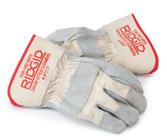
> PPE EQUIPMENT
No matter what, safety comes always first. Therefore, make sure to include a helmet, glasses and protective gloves in your toolkit.
SCAN HERE for more information.




Keeping heating systems efficient, clean, and blockage-free is vital for their performance, lifespan, and energy savings - while also protecting boiler and ASHP warranties.
> THE IMPACT OF INEFFICIENT SYSTEMS
Over time, sludge, rust, and debris accumulate in heating systems, leading to higher energy bills, poor performance, and potential breakdowns. This inefficiency wastes energy, increases carbon footprints, and can cause irreparable damage to equipment.
Power flushing solves these issues by thoroughly cleaning systems. It creates turbulence and agitation using reversible flow technology to remove sludge and restore efficiency.
> A REQUIREMENT, NOT AN OPTION
Power flushing removes blockages, corrosion, and debris, ensuring proper heat circulation. Compliance with regulations like BS7593 and Part L mandates system cleaning and treatment. For plumbers, this improves energy efficiency, lowers maintenance costs, and satisfies legal requirements.

“Power flushing solves these issues by thoroughly cleaning systems”



Power flushing equipment can connect to systems via:
▸ Radiator valves.
▸ Pump head adaptors (ideal for sealed systems).
▸ Filling loops (used if radiator valves or pump heads are inaccessible).
▸ Flushing points (added under boilers).
For best results, pair a Kamco Flushing Machine with a power flushing filter, such as CombiMag, to enhance magnetite removal.

“Treating the system with an inhibitor after flushing is essential”

The power flushing process can use specialised cleaning chemicals tailored to different challenges:
Tailored chemicals aid the flushing process:
▸ Sludge Mobilisers: Break down sludge and rust (e.g., Kamco FX2).
▸ pH-Neutral Solutions: Safe for older systems and aluminium components (e.g., Hyper-Flush).
▸ Neutralising Crystals: Balance pH after acidic cleaners.
▸ Biocides: Prevent microbial growth, especially in underfloor systems.
Treating the system with an inhibitor after flushing is essential. Building Regulations also require installers to use certified inhibitors, such as those bearing the NSF/Buildcert mark.


Here are some quick answers to common questions, giving you key information at a glance.
Q: How long does it take to power flush a system thoroughly?
A: Around 5+ hours for a three-bed house with a vented system; less for sealed systems. Results can be increased by pairing with a power flushing magnetic filter.
Q: Do I need to drain the system first?
A: Not fully. Lower the water level in vented systems; sealed systems require no draining.
Q: Can sealed systems be flushed?
A: Yes, all systems being flushed must be temporarily sealed.
Q: What is reversable flow technology?
A: Kamco Power Flushing Machines can reverse the flow on any power flush, creating turbulence and agitation thus removing all debris.
Q: How do I calculate water volume for chemicals?
A: Multiply the boiler output (kW) by 12, or estimate 100 litres for 10 radiators.
Q: What’s the best chemical for old systems?
A: Use pH-neutral products like Hyper-Flush to minimise the risk of damage.
Q: Do systems need flushing regularly?
A: A properly treated system shouldn’t need flushing for at least five years, often longer.
Q: Can I add inhibitors using the pump?
A: Yes. Add the inhibitor to the pump’s tank, circulate it for 10 minutes, and then disconnect. Glycol or heat transfer fluid can be added for ASHP systems.
Q: What happens if I use too little chemical?
A: Under-dosing reduces cleaning effectiveness, so it’s better to add slightly more than too little.
“Under-dosing reduces cleaning effectiveness, so it’s better to add slightly more than too little”


Kamco has been at the forefront of power flushing technology for decades, offering reliable and innovative solutions for heating professionals.
> INTRODUCING CLEARFLOW CF20 COMPACT
Kamco’s Clearflow CF20 Compact offers a new level of convenience in power flushing technology. Designed for ease of use, this lightweight and portable pump is perfect for domestic systems.
KEY FEATURES INCLUDE:
▸ A 20-litre translucent HDPE tank for clear visibility during operation.
▸ Instant flow direction reverser to improve debris removal efficiency.
▸ Acid-resistant construction for long-lasting durability.
▸ An integral handle, making it easy to transport.
▸ Dual Purpose use for ASHP systems, making it a real differential in product offering.
The CF20 Compact is an ideal choice for professionals looking for a handheld solution that combines portability with powerful performance.


> CLEANING CHEMICALS
Kamco’s chemical range supports effective power flushing with products such as:
▸ Power Flush FX2: A powerful solution for dissolving sludge, scale and corrosion deposits quickly. No other proven chemical cleaner is available on the market with the levels of citric/phosphoric acid.
▸ Hyper-Flush: A pH-neutral cleaner, ideal for older systems or those with delicate components.
With over 40 years of experience, Kamco supports professionals with high-quality products and free training to enhance expertise.
For further information.




Installers are increasingly turning to press-fit as a far cleaner, quicker, and safer method of jointing compared to brazing, which requires a ‘hot-works’ permit.
Here’s why press-fit is a smart choice for many plumbing applications:
One of the primary benefits of press-fit fittings is the speed of installation. Compared to traditional methods like soldering or brazing, press-fit systems are often up to three times faster, reducing labour costs and project time. This ease of installation is particularly good for projects with tight deadlines or in environments where prolonged installation times are impractical.
> SAFETY BENEFITS
As press-fit fittings do not require heat or open flames, they eliminate the need for ‘hot works’ permits, reducing the risks associated with fire hazards. This makes them ideal for installations in roof spaces and sensitive environments such as hospitals, schools, and airports.
Press-fit fittings offer a reliable, leak-free solution. The press mechanism ensures a strong, durable joint that can withstand high pressures and temperatures, with many

“Press-fit fittings provide a fast, safe, and reliable alternative to traditional jointing methods”


3. Inspect the fitting and O-rings


2. Deburr tube internally and externally

4. Assemble and mark the tube insertion depth

Mark the completed joint
Complete the joint with the press tool A permanent FLAME-FREE connection in 5 seconds!







“Press-fit systems are often up to three times faster, reducing labour
costs and project time”
These fittings are highly versatile, being compatible with a variety of materials such as copper and stainless steel. They are suitable for both water and gas applications, making them a flexible choice for a range of projects.
>B< Press copper fittings from Conex Bänninger offer a range of reliable solutions. The fittings ensure a permanent, secure, leakfree joint, with sizes 12-54mm compatible with a range of press tools, including M profile jaws. Key benefits include being quick and easy to install – up to three times faster than brazing, a 3-point press safety feature (12mm to 54mm only), and an un-pressed joint indicator to help identify any unpressed joints.

A ‘lead-in’ edge aids installation and helps protect the O-ring from damage. When the fitting is pressed, the O-ring compresses, filling the gaps and creating a leak-free joint.
Corrosion-resistant, >B< Press has a design life of 50 years and comes with a 25year warranty covering any faults arising from defective manufacture.
Press-fit is ideal for installations where flammable materials could be stored, such as in hospitals and airports. >B< Press is a great solution for water, heating, and ventilation applications.
To find out more about >B< Press, go to:

Winning awards is a big deal, and for Paul Clark, it’s helped him become a leading figure in the plumbing world.

> AMBASSADOR
Paul’s open and honest posts on Instagram have made him stand out, and he’s all about promoting good practices in the industry. This led Conex Bänninger to choose him as their ambassador, thanks to his great track record and positive influence.
> PAUL SAYS:
“I am a third-generation plumber and proud of it! With my father and grandfather having been in the trade, it’s in my blood.”
“I believe Conex Bänninger fittings are the best, and I’m not just saying that as their ambassador. I would continue to use them even if I were no longer an ambassador!”
“I’ve been using >B< Press fittings for many years – they’re far quicker than soldering, and there’s no need for hot works. The 3-point press system gives you the confidence that joints are securely and correctly pressed.”
“>B< Press fittings also look neater than soldered joints, and you don’t have to worry about flushing out flux or solder from the system. Plus, not needing hot works significantly reduces insurance premiums and provides a safer working environment.”
“The 3-point press system gives you the confidence that joints are securely and correctly pressed”
SCAN HERE for more information:




Learn how push-fit pipe fittings offer an easy, tool-free solution for quick plumbing connections.
> WHAT ARE PUSH-FIT PIPE FITTINGS?
Push-fit pipe fittings are plumbing connectors that join pipes without the need for soldering, adhesives, clamps, or specialised tools. These fittings consist of a metal body with an internal mechanism that grips the pipe when it is inserted into the fitting. The connection is secure and watertight without requiring any special tools, making pushfit fittings particularly user-friendly.
The pre-lubricated EPDM O-Ring ensures a watertight seal between the tube and the fitting.
The high-performance stainless steel Grab Ring provides a secure mechanical grip on various tube materials. Its grip-first design prevents full bore failure once engaged.
Push-fit fittings use a combination of O-rings and gripping teeth to create secure pipe connections. Here's how the mechanism works:
INSERTION: A pipe is simply pushed and twisted into the fitting until it reaches the internal stop. No force or twisting is required.
SEALING: Inside the fitting, a rubber O-ring creates a watertight seal around the outside of the pipe, preventing leakage.
1 2 3
GRIPPING: Stainless steel teeth inside the fitting grip the outer surface of the pipe, holding it securely in place and preventing it from being pulled out.
DISCONNECTION: In most cases, pushfit fittings can be easily disconnected by pressing a release collar or using a special disassembly tool, allowing the pipe to be
4 VSH TECTITE FLEXIBLE

METAL BODY
The DZR brass body offers a strong, durable, and reliable joint with minimal expansion.
DEMOUNTABLE
Many push-fit fittings are fully demountable, allowing for system alterations, servicing, or repairs. To release, depress the polymer collar using the demounting clip or tongs.

The Pegler Terrier






VSH Tectite, from Aalberts IPS, offers a comprehensive range of copper, stainless steel, and brass push-fit fittings, valves, and accessories. These fittings are suitable for drinking water, heating, cooling, and compressed air installations. Once installed, the fittings can still be rotated for easy alignment, making them perfect for use with prefabricated assemblies and sections of pipework. Their slim, sleek design also allows them to remain visible where necessary and be easily insulated.
> KEY FEATURES:
▸ Quick, tool-free assembly
▸ Ideal for small or hard-to-reach spaces
▸ Stress-free installation with re-alignable pipes
▸ Available in sizes from 10mm to 54mm
▸ Suitable for copper, stainless steel, and brass pipe
▸ Available in both demountable and non-dismountable versions
▸ Compatible with other systems



“Push-fit fittings reduce installation time by around 40-50%”



> DISADVANTAGES
COST: Push-fit fittings are generally more expensive than traditional fittings. While they do save time, the initial cost of the fittings themselves can be higher.
> ADVANTAGES
EASE OF INSTALLATION: No special tools, soldering, or glue required, making them accessible to professionals and DIYers alike.
TIME-SAVING: Push-fit fittings reduce installation time by 4050% on average, eliminating the need for time-consuming soldering.
VERSATILITY: Compatible with various pipe materials, including copper, PEX, CPVC, and PVC, push-fit fittings are ideal for a range of plumbing applications.
RELIABILITY: These fittings provide durable, leak-proof connections that can handle pressure and temperature changes.
REUSABLE: Many push-fit fittings are reusable, making them cost-effective over time.
ACCESSIBILITY: Ideal for tight or hard-to-reach spaces where traditional methods would be difficult. 1 2 3 4 5 6
“Ideal for tight or hard-to-reach spaces where traditional methods would be difficult”
COMPATIBILITY: Although pushfit fittings are versatile, not all types are compatible with every material. It is essential to ensure the fitting you choose matches the pipe material and size you are using.
> COMMON APPLICATIONS
▸ RESIDENTIAL PLUMBING:
Ideal for water supply and heating systems in homes, especially for quick repairs or upgrades.

▸ COMMERCIAL INSTALLATIONS:
Widely used in commercial and industrial buildings, reducing labour costs and downtime.
▸ TEMPORARY INSTALLATIONS: Often used for temporary setups or repairs, as they can be easily disconnected and reused. 1 2
SCAN HERE
Find out more by visiting:

Learn how to push-fit pipe fittings with these easy step-by-step installation instructions.

Cut the VSH Tectite tube with a hand tool. Use good quality cutters, ensuring the blade is sharp and the cut is square. Make sure the tube is clean and free from damage.

Use the VSH Tectite calibrating tools to provide a clean, square pipe and with chamfered edges. Calibration re-rounds the tube after cutting to prepare it for jointing. Other plastic pipe deburring tools can be used, ensure correct size.

Push the TectSEAL 3PS into the tube until the flange meets the chamfered end. Make sure all swarf is removed from the tube before fitting TectSEAL. Please note: Manufacturer suitable liners should be used with other tubes. No liner is required for copper fittings.


Mark the insertion depth clearly on the tube. Using a line and an A aids visibility after insertion. VSH Tectite calibration tools and VSH Tectite debur, mark and scribe tools can help. Depth gauges are available in the range.
Push the tube firmly into the fitting until the insertion depth mark reaches the demounting collar. Pushing with a twist will ease insertion.

Pull back on the pipe to check the joint is secure. VSH Tectite fittings allow the tube to rotate after jointing.
“Push-fit fittings are compatible with various pipe materials, including copper, PEX, CPVS, PVS and MLCP, making them ideal for a wide range of plumbing applications”





Hey future plumbing pros!
Ready to make a splash in the world of shower pumps?
Let's talk about Grundfos Shower Pumps – your go-to for turning ordinary showers into extraordinary experiences. And remember, even though they are called ‘shower pumps’ they can also be installed to boost hot and/or cold water to other outlets such as bath taps, basin taps, sink taps.
> WHY GRUNDFOS?
Grundfos is a name you can trust. Known for our top-notch quality and innovative designs, Grundfos Shower Pumps are all about delivering powerful, consistent water pressure. No more dribbly showers – just a refreshing, invigorating experience every time.
> THE MAGIC BEHIND THE PUMPS
So, what's the secret ingredient?
Grundfos Shower Pumps are designed with cutting-edge technology to ensure optimal performance. They come in various models to suit different needs, whether you're working on a single shower setup or a more complex system. Plus, they're super easy to install and maintain.
> ECO-FRIENDLY AND EFFICIENT
Worried about the environment?
Grundfos has got you covered. Our pumps are not only efficient but also eco-friendly, helping to reduce water and energy consumption. It's a win-win for you and the planet!
> EXPLORING THE RANGE
Grundfos offers a variety of shower pumps, each tailored to different requirements:
1. GRUNDFOS AMAZON PUMPS:
These are robust and reliable pumps designed for high performance. They are perfect for homes with multiple bathrooms, ensuring consistent water pressure throughout.
2. GRUNDFOS STR2 PUMPS:
These pumps are compact and efficient, ideal for smaller homes or single shower setups. They provide a powerful boost to water pressure, making every shower a delight. STR2-2.0 C
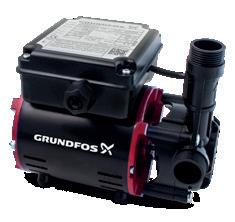



“Make sure to install the pump in a well-ventilated area to prevent overheating”
> NEGATIVE VS. POSITIVE HEAD PUMPS
You might have heard terms like "negative head" and "positive head" when talking about shower pumps. Here's what they mean:
• POSITIVE HEAD PUMPS:
These pumps are used when the water tank is positioned above the shower or tap. They rely on gravity to feed water into the pump, which then boosts the pressure. Positive head pumps are ideal for most standard installations.
• NEGATIVE HEAD PUMPS:
These pumps are used when the water tank is positioned below or the same level as the shower, tap or highest part of outlet pipework. Negative head pumps are perfect for more challenging installations where the water flow needs a bit of extra help.

> TIPS FOR INSTALLATION
Here are a few pro tips to keep in mind:
TIP 1 LOCATION, LOCATION, LOCATION: Make sure to install the pump in a well-ventilated area to prevent overheating. The optimal position to install a shower pump is at the base of the hot water cylinder.
TIP 2 PIPEWORK PERFECTION:
Use the right size and type of pipes to ensure smooth water flow. Using a Surrey Flange will minimise the amount of air in the pipework
TIP 3 SOUNDPROOFING:
Grundfos pumps are quiet, but adding a bit of soundproofing can make them virtually silent.

> JOIN THE GRUNDFOS REVOLUTION
By choosing Grundfos, you're not just installing a pump – you're joining a community of professionals dedicated to excellence. So, get ready to impress your clients and make every shower a luxurious experience!

SCAN HERE
to view our shower pumps range


When selecting a shower pump, it is important to consider if the system is positive or negative head and what pressure is desired.
> SHOWER PUMP BASICS
NEGATIVE HEAD SYSTEM
A negative head condition exists where the flow from the outlet is less than 0.5 litre/min. This is usually when there is insufficient pressure, under gravity, to provide a flow at the outlet.
POSITIVE HEAD SYSTEM
A positive head condition exists where the flow from the outlet is more than 0.5 litre/min. This is usually when there is sufficient pressure, under gravity, to provide a flow at the outlet.
PUMP PRESSURE (MEASURED IN BAR)
In pump performance, 1.0 Bar is generally considered low pressure, 1.5-2.0 Bar medium pressure and ≥3.0 Bar high pressure, eg. to run multiple showers/heads.
> SHOWER BOOSTER APPLICATIONS GUIDE






Boost Whole House Hot and ColdGravity fed, Positive Head


PUMP OPTIONS:
AMAZON (STP)
Boost Whole House Hot and ColdGravity fed, Negative Head


PUMP OPTIONS:
AMAZON Universal Twin (STN)
Boost Whole House – Unvented Cylinder Cold water boost to unvented hot water cylinder



PUMP OPTIONS: MQ, CMBE, Max-e Boost, , SCALA1, SCALA2 With Integral Water Tank: HOME BOOSTER
Boost Hot/Cold Multi Outlet


PUMP OPTIONS:
SCALA2*, AMAZON Universal Single (SSN)
TMV/Thermostatic shower valve protection required. * Max temperature of up to 45˚C
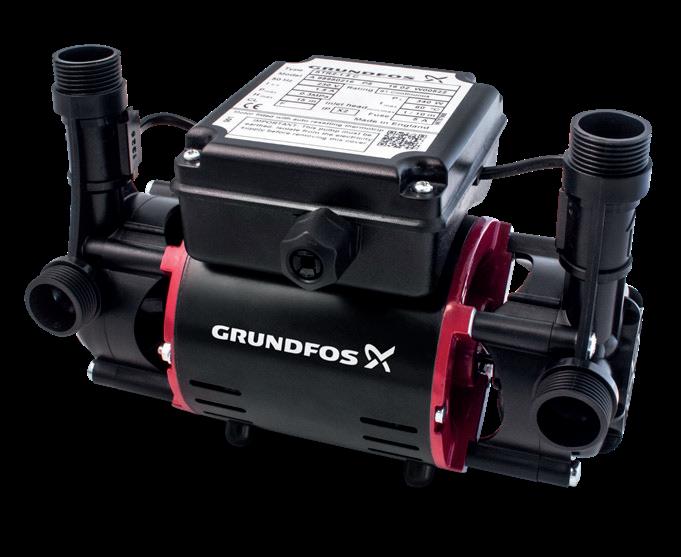
Whether it’s to address inadequate water pressure or simply to create a more exhilarating shower experience, Grundfos has a pump for you.
All Grundfos shower pumps conform to both European and UK standards, including WRAS product approval, are backed by a comprehensive manufacturer’s warranty and are supported by a Customer Service Department and Technical Helpline that are second to none.






With energy prices rising, householders are looking to save wherever they can. Smart heating systems are the tried and tested solution!
Smart heating can help your customers cut energy waste and save money on their bills, which is also a great way to boost your business in a sector that’s only set to grow.
Here’s what smart heating systems can do for your customers and your business:
1
Helping customers heat their homes more efficiently and in line with their habits has a host of benefits – chief amongst them cost. There’s no need to heat when nobody is at home, or to keep the whole house warm when only some rooms are in use.
Smart thermostats and heat pump optimisers are the easiest way to schedule the heating with maximum efficiency, or make adjustments on the go. All it takes is a few taps in a user-friendly app. Your customers save while always staying comfortable, and you build a reputation for delivering value.



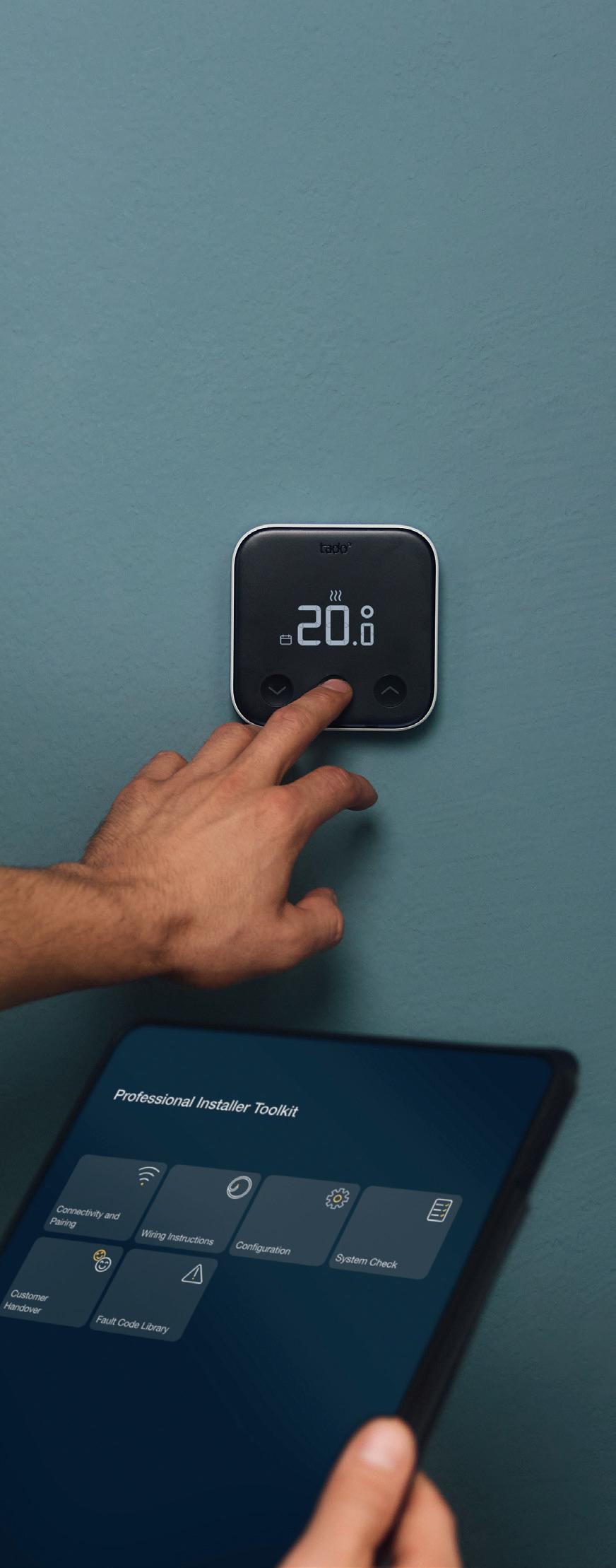
Using less energy is a growing priority for customers, too. Home heating is responsible for around 14% of the UK’s entire carbon emissions (Source: Energy Systems Catapult). That makes smart energy-saving systems the obvious choice for eco-conscious homeowners, and for businesses looking to improve their environmental impact.
Delivering better efficiency and immediate savings is a sure-fire way to build trust and strengthen your relationship with customers. Of course, it’s crucial to do your research and offer products from best-inclass suppliers who can support you all the way from installation to long-term care.
With tado° X for Professionals, you can offer up to ten years’ warranty on the latest in smart heating technology. Your customers can rest easy knowing their products will serve them well into the future.
4
Getting up to speed on the latest advances in smart home technology is also a good way to demonstrate that you can provide expert advice on the ideal solutions for your customers. More tech-savvy homeowners may already be familiar with concepts such as Matter and Thread, which are becoming standard in smart home integration.
Matter is a new, open standard that allows different smart devices, no matter the brand, to work together seamlessly. Thread is a lowpower, wireless technology that helps smart devices communicate quickly and securely across the home. Knowing about these technologies can boost your credibility and build trust and confidence with customers.
“Smart thermostats and heat pump optimisers are the easiest way to schedule the heating with maximum efficiency”

Heating efficiency is a vital part of the UK government’s net-zero strategy. As a result, there’s now a bundle of initiatives to promote smart heating installations.
Homeowners can now get grants for adding smart heating controls under the ECO4 scheme. The Boiler Plus standard also requires adding energy efficiency measures, such as smart controls with automation and optimisation functions, when installing a gas combi boiler.
Only a small fraction of UK households have smart thermostats installed. That means the market is set to grow significantly over the coming years as more and more consumers switch to smart heating – a great opportunity to expand your installer business.
Smart heating systems can also be a first step in the journey to broader smart home integration, offering ample space for additional services from electric vehicle charging to smart lighting and more.

“Smart heating systems can also be a first step in the journey to broader smart home integration”
Take the first step to boost your business with smart heating and sign up for tado° X for Professionals today.

tado.com/professional

Intuitive, simple and smart.

The all-new tado° X for Professionals range offers the best in smart home energy management, services and after-sales care.
Whatever your customers are looking for, tado° X has you covered:
▸ Wired Smart Thermostat X
▸ Wireless Smart Thermostat X
▸ Smart Radiator Thermostat X
▸ Heat Pump Optimizer X
▸ Bridge X (Thread border router)
All products are powered by Matter and Thread, and are compatible with voice assistants from Amazon, Google and Apple.
tado° also offers you a 10-year warranty on all tado° X devices because durability and reliability are very important to us. You can be sure that you are investing in quality.

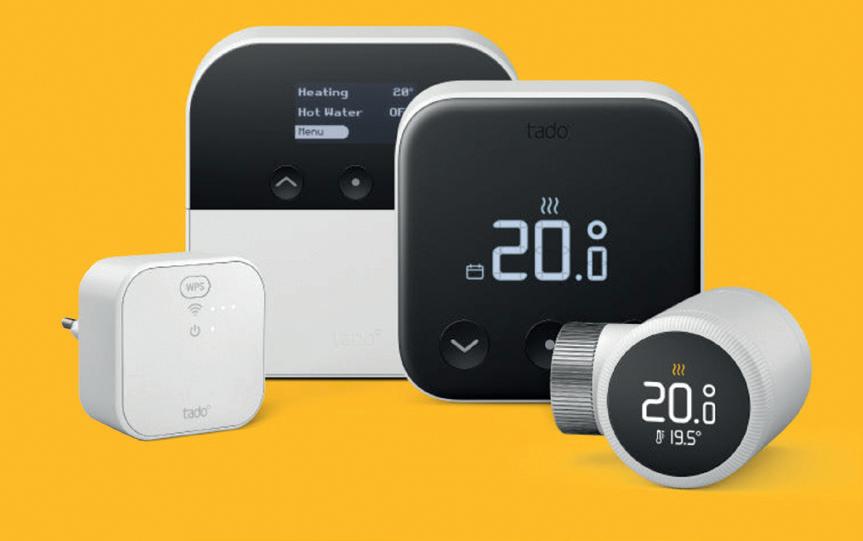
Registered installers get a host of extra benefits, including an online platform with expert training and dedicated real-time phone support. Members can also collect and redeem points for a host of rewards, from tech gadgets to luxury items, or load them onto a personalised credit card to spend the cash equivalent.
At tado°, we’re committed to helping you sustainably grow your business – one smart thermostat at a time.
“I like a manufacturer looking after the installer. It helps that I like and use the products in my own house”
Nick, Electrician in Northampton
SCAN HERE For more information.




Although commonly used in plumbing and construction, plastic and synthetic materials are a cause for concern.
Areport from Safe Piping Matters revealed the devastating effects of microplastics and nanoplastics on human health.
The use of safe piping materials is critical in all buildings, particularly in those where the most water is consumed, such as houses and hospitals.
> HOW DO MICROPLASTICS ENTER THE WATER CYCLE?
Dangerous chemicals often enter the water cycle through plastic pipes. Their properties mean they are susceptible to degradation over time, a process that is sped up when interacting with cleaning chemicals.
Polyvinyl chloride (PVC) pipes are known to experience fragmentation, which releases microplastics and nanoplastics into the water supply and increases human exposure to plastic pollution.

> WHAT ARE THE IMPACTS ON OUR BODIES?
Through the consumption of contaminated drinking water, it is estimated that the average person ingests 4,000 particles per year.
Microplastics and nanoplastics particles can harm the body through:
▸ Destabilising the gut microbiome, leading to conditions such as cancer and diabetes.
▸ Damaging lung tissue and cell DNA, exacerbating risks associated with lung conditions.
▸ Deteriorating brain health, increasing vulnerability to disorders like Alzheimer’s, Parkinson’s, and Huntington’s.
▸ Declining reproductive health in males and females.
Safer plumbing systems are a necessity. Alternative materials like copper ensure safe drinking water, thanks to their corrosion resistance and antimicrobial properties, which reduce the risk of contamination.
“Safer plumbing systems are a necessity”


A recent study by the Chartered Institute of Building found that almost a third of people would describe new builds as ‘poor quality’.
So, how do the construction materials used in new builds really compare to those of older housing?
Today, tradespeople are more likely to use plastic in plumbing and fittings for pipes, seals, windows, doors, cables, and insulation, due to the low cost of the material. Not long ago, copper was the most commonly used material for piping because of its resilience and durability.
With plastic being used in all areas of the home, the impact on the reduced longevity of modern homes cannot be overlooked. Plastic is not only less durable than traditional materials like copper - with common issues in new builds including cosmetic defects, cracks, and poor insulation - but it is also highly flammable.
With evidence showing the poor quality of new builds, residents are likely to move house more often to avoid maintenance costs, which generates more waste and increases the carbon footprint, creating a negative environmental impact.
Despite some incentives offered by new homes, such as energy efficiency, there remain lessons to be learnt from the past - such as prioritising quality and longevity over short-term cost

“Copper is infinitely recyclable and will last for hundreds of years”
They are usually made from some sort of plastic like polyethylene (PEX) and other materials which simply cannot be recycled
As the plastic does degrade, it breaks down into microplastics, which pose severe risks to wildlife and human health

Its plastic takes hundreds of years to decompose and pollutes our environment
The production of MLCPs uses a significant amount of energy and resources that contribute to the ongoing issue of air pollution

Copper has been at the forefront of the plumbing industry for centuries, but in the last two decades, materials such as multilayer composite pipe (MLCP) have emerged as an alternative.
When selecting plumbing materials, efficiency, safety, sustainability, and durability are key considerations. As the use of resources continues to impact our environment, plumbers need to become more aware of the environmental footprint of their materials.

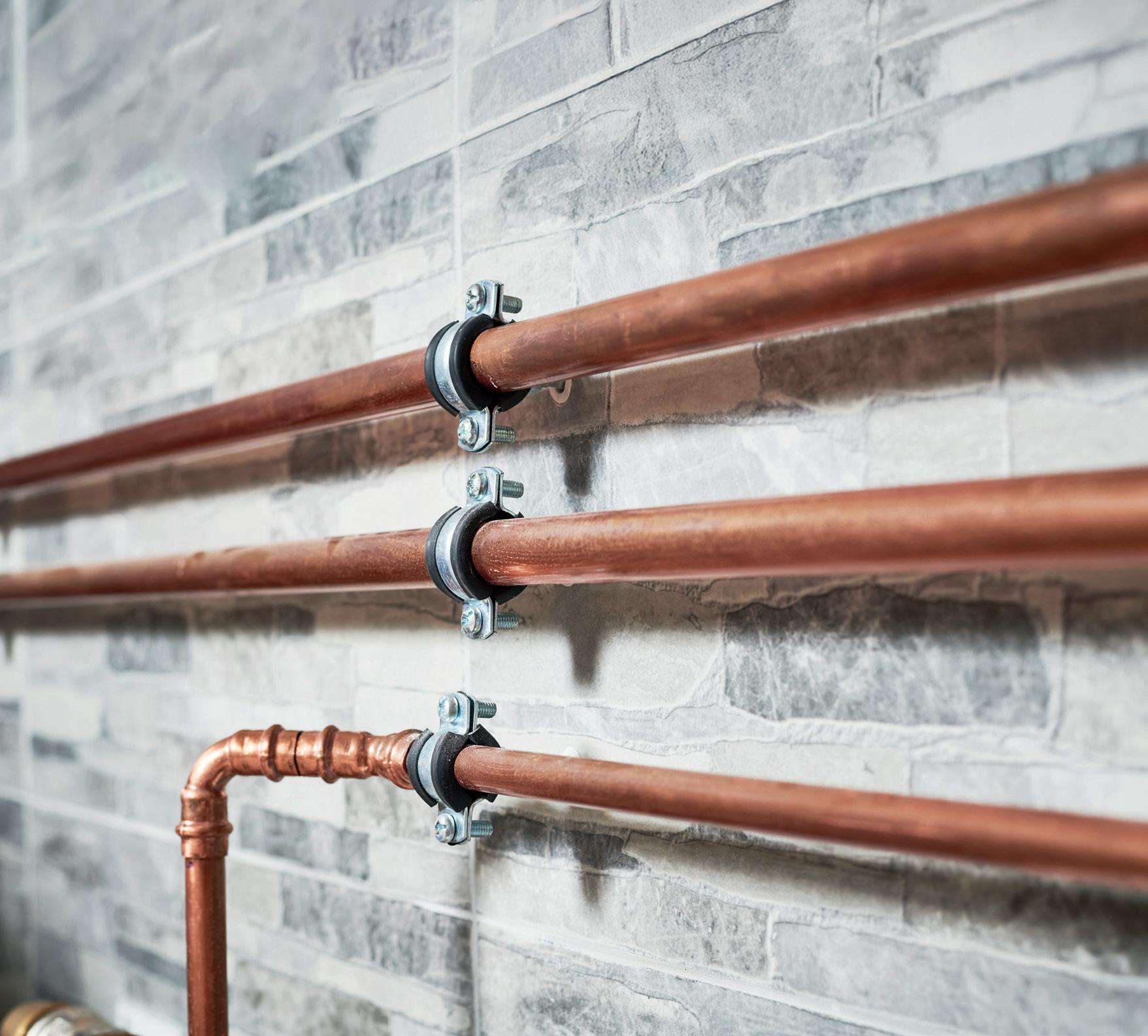
> WHAT IS MLCP?
MLCP is marketed as a fully recyclable product, but its multiple layers of plastic and aluminium glued together actually make it virtually impossible to recycle, with a degradation process lasting over 450 years.
During this time, MLCP breaks down into microplastics, which are harmful to human health.
It is also susceptible to warping, damage, and leakage when exposed to higher temperatures or used in outdoor areas.
> COPPER’S STRENGTHS IN PLUMBING
Copper is a 100% recyclable material, with over two-thirds of the copper used since 1900 still in circulation. As a durable material lasting close to 80 years before needing to be recycled, it has a long lifespan and a much lower carbon footprint than MLCP.
The thermal conductivity of copper also means it uses less energy in transferring heat than MLCP. Due to its antimicrobial properties, drinking water from copper pipes is much safer too, as chemicals from MLCP can leach into water.
With the increasing stress we put on our planet, simple changes - such as choosing sustainable piping materialscan make a significant difference to our environment.
“Copper
is a 100% recyclable material, with over two-thirds of the copper used since 1900 still in circulation!”


The UK needs to build 1.5 million homes by 2029 to meet demand.
As a result, housebuilders are likely to use low-cost and easy-toinstall materials to get the job done.
However, this puts the safety of future homeowners at risk, as they are more likely to be exposed to cheap materials that deteriorate quickly. How can plumbers make a difference?
> FIRE SAFETY IN NEW BUILD HOMES
Due to the low cost of plastic, it is often the material chosen for new projects. However, most plastics are flammable and will burn when exposed to an open flame, releasing toxic gases that can fuel a fire further.
Polyvinyl chloride (PVC), used widely in pipes, cables, roofing, and flooring, will ignite in the event of a fire. Polyethylene (PEX) and polypropylene (PP) have low melting points and catch fire at temperatures of 400 degrees Celsius or less - a lower ignition point than the temperature of an average building fire.
While progress has been made to ban flammable cladding and insulation in recent years, there is still a lack of control over the materials used in construction.
“Plumbers must turn their attention to non-flammable materials like copper”
> WHAT NEEDS TO CHANGE?
Plumbers must turn their attention to non-flammable materials like copper, which has a very high melting point of over 1,000 degrees celsius and can withstand extreme temperatures, UV exposure, and pressure without altering its natural state.
By choosing copper for pipes in construction, progress can be made to build a more sustainable and safer future for all.





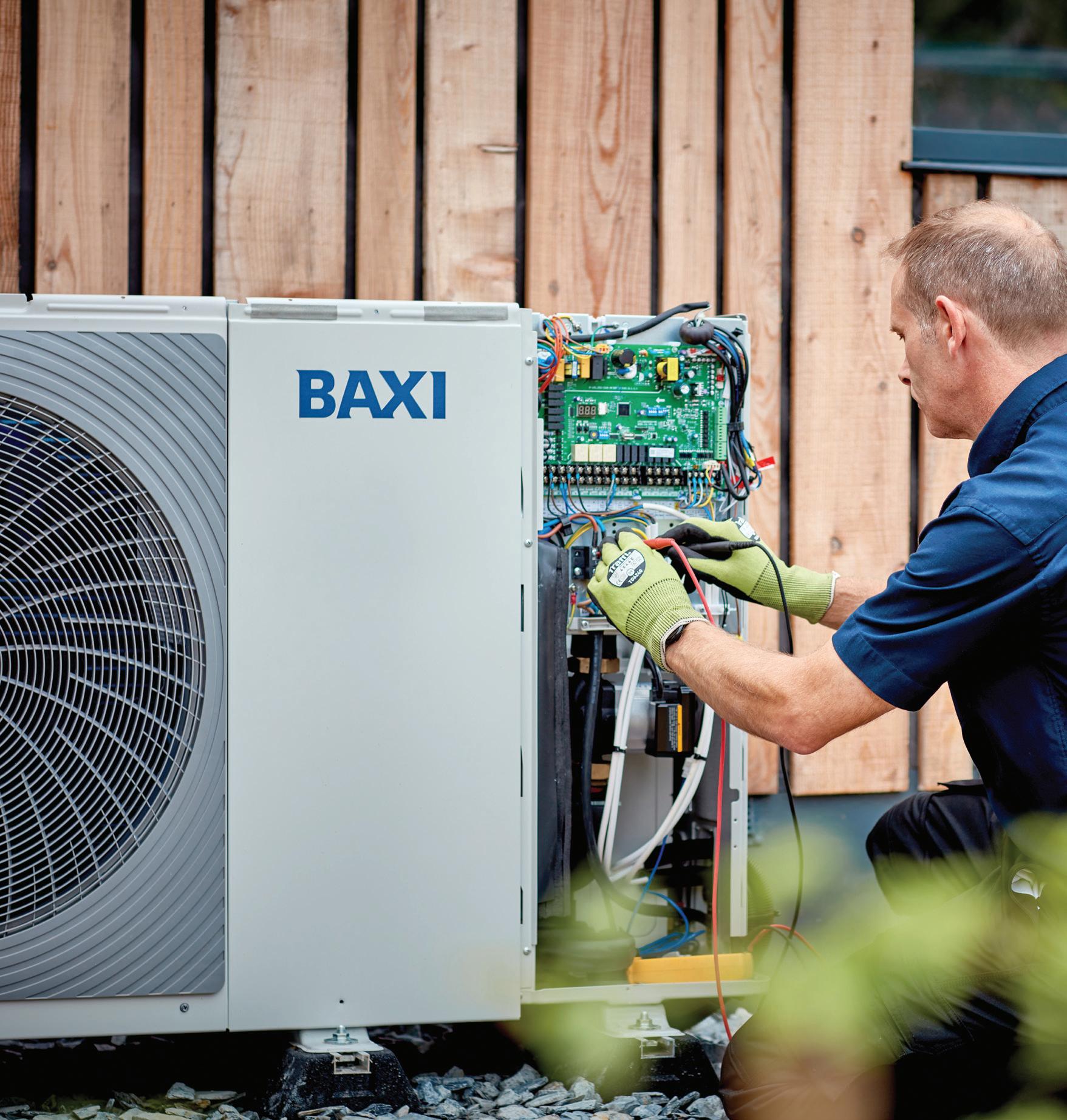
As the UK transitions to greener energy, bridging the skills gap is essential. Attracting diverse talent, especially from underrepresented groups like women, can help shape the workforce needed to drive decarbonisation.
> MEETING THE DEMAND FOR HEAT PUMPS
Ian Trott, Head of UK Training Solutions at Baxi, shares why developing your skills in low-carbon tech could put you at the forefront of this vital industry shift.
Latest industry figures show that in 2023 around 60,000 heat pumps were installed in the UK. To meet its ambition of 600,000 installations per year by 2028, ¹ DESNZ has set a target of 12,000 trained heat pump installers, with 7,000 installers trained so far. ²
But this falls short of the Heat Pump Association’s ³ forecast that a minimum of 33,70 trained installers will be needed to meet demand. As with the emergence of any gap, there’s an opportunity to fill it.
> SUPPORTING LOW-CARBON LEARNING OPPORTUNITIES
With a lack of skilled engineers undoubtedly slowing down this progress, government and industry have an important role to play to encourage more individuals to embrace low carbon technology and provide suitable courses.
“Developing your skills in low-carbon tech could put you at the forefront of the industry”
¹ https://researchbriefings.files.parliament.uk/documents/POST-PN-0699/POST-PN-0699.pdf
² https://publications.parliament.uk/pa/cm5804/cmselect/cmpubacc/653/report.html
³ https://www.heatpumps.org.uk/wp-content/uploads/2023/12/HPA-Unlocking-WidescaleHeat-Pump-Deployment-in-the-UK.pdf


There is a critical need for more apprentices and underrepresented groups in the heating industry, particularly to meet the growing demand for air source heat pump installations – a key component of the UK's transition to Net Zero carbon emissions by 2050.

Findings from a recent report revealed women account for just 2% of the heating industry workforce. ⁴
Many of those women may be held back from entering the workforce because of a misconception that the construction industry is male-centric, or roles are not suitable for women. This is why it is imperative that both manufacturers and government provide accessible training courses that focus on the wide variety of heating solutions available on the market.
“Women account for just 2% of the heating industry workforce”
4 https://www.oftec.org/news-blog/2022/02/10/more-heating-
“I have had the opportunity to install ASHPs in some of the Baxi training centres which has given me great insight into the installation and commissioning of the units. Heat pumps have an important part to play in the energy transition, and we need more people to install and maintain them. I would encourage anyone, of any gender, to consider a career in the heat pump industry”
Rachel Griffiths, Training Officer at
Baxi.


There is clearly a need to increase training capacity as well as encourage more people into the industry. This means that the sector must look to invest in training and collaborate to get more engineers qualified.
> PREPARING FOR FUTURE TECHNOLOGIES
A solutions approach to training will prepare engineers for all technologies needed in the energy transition. This includes heat pumps, heat networks, and hybrids.
> FLEXIBLE TRAINING OPTIONS FOR ENGINEERS
Additionally, by using a mix of in-person and online training engineers receive the hands-on experience with solutions they want to explore and the capacity for flexible learning is increased. This allows engineers to fit training around busy schedules and suits the needs of installers who may favour online learning environments.

> A FUTURE OF OPPORTUNITY
Decarbonisation provides an incredible opportunity for individuals to join the industry, develop new skills, grow future business, and be perfectly placed to meet growing customer demand.
“Decarbonisation provides an incredible opportunity for individuals to join the industry”
These investments will go a long way in improving access to training for all heating engineers, regardless of any barriers that may have previously prevented them.
If you would like to attend an upcoming Baxi training programme.

The UK’s energy transition means heating and plumbing students and apprentices stand at the forefront of the heat pump revolution.

> TRAIN FOR TOMORROW’S HEATING NEEDS
Why not get ahead now by training to become a qualified air source heat pump (ASHP) installer with Baxi? To reap the rewards of the growing ASHP opportunity, you can take advantage of Baxi’s extensive range of advanced training opportunities and ensure you’re perfectly placed to meet growing customer demand.
> COMPREHENSIVE HEAT PUMP TRAINING
Baxi’s training covers everything about heat pump technology, from the basics to ongoing maintenance. Through Baxi’s flagship Solutions Academy and flexible eLearning options, installers can qualify with a balance of inperson and online training to fit any schedule.
> ONGOING SUPPORT FOR QUALIFIED INSTALLERS
Once qualified, Baxi’s support continues with a range of benefits, including:
▸ Free assisted commissioning for first installs.
▸ Access to the MCS umbrella scheme, Abode Heat, to aid grant funding applications.
▸ Industry-leading product support and ongoing training.
> FUNDING AND CASHBACK OPPORTUNITIES
Qualified installers can also access government funding such as the Boiler Upgrade Scheme (BUS).
SCAN HERE For more information about Air Source Heat Pumps training.




Underfloor Heating (UFH) using piped warm water is a modern and energy-efficient option for heating homes and other buildings. UFH also delivers comfortable warmth for occupants, as well as other practical benefits.
With UFH, the floor is gently heated by piped warm water (or alternatively by electric cable) and the heating energy is emitted from the floor by natural radiation. This heat is absorbed by other surfaces in the room which then also emit warmth.
The result is an all-round, more even warmth than is typically achieved by other space heating techniques. Radiators, for example, use room air to transfer the heat, mostly by convection. This reliance on the convection of air to heat the room results in
uneven warmth and higher temperatures at ceiling height compared with floor level.
As radiators intrude on the usable space within a room, there is a general desire to keep them as compact as possible. As a consequence of this, the piped water has to be hotter than for UFH in order to achieve the same level of comfort for the occupants.
Plumbed UFH uses piped warmed water from any primary heat source. This may be from a conventional domestic boiler that is also supplying domestic hot water. In some situations, the boiler may be supplying heated water for radiators as well as for UFH. Alternative sources of warmed water may be heat pumps or solar water heating. UFH is especially suited for such renewable heat sources because it requires water at lower temperatures than traditional heating techniques.


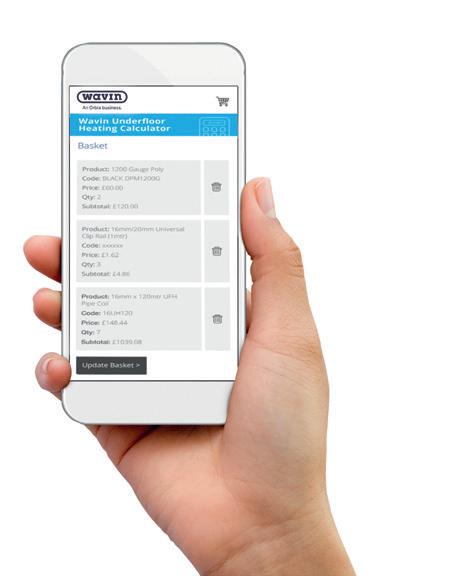



Underfloor heating offers many benefits to the homeowner.
▸ 10-20% savings in heat demand vs. radiators from a reduced set point, as the UFH set point better reflects the desired temperature.
▸ More even room temperature ensures all round comfortable warmth
▸ Silent running – no expansion creaking or water flow noise
▸ Unhindered room layout - because there are no wall-mounted radiators
▸ Safer environment - no hot surfaces or sharp, hard edges, with the added health benefits of reduced dust and allergens.
▸ Decreased irritants - as the warm floor inhibits the breeding of dust mites and fungi
▸ Low maintenance - no radiators to redecorate or renew, or to be ‘dropped’ to allow room redecoration.
Plumbed UFH comprises three key elements that work together to deliver the required heating performance and effect:
1. Floor products incorporating UFH pipe: to create the pipework circuits within the floor that will emit heat. Many floor products help to hold the pipe at the correct spacing to ensure even distribution of heat across the floor surface above.
2. Manifold: to provide flow and return circulation of warm water at the correct temperature and flow rate to ensure an even, comfortable temperature across the whole floor surface.
3. Controls: to monitor water and air temperature and signal the heat source. In effect, the nerve centre of the installed system.
The careful selection of each of these is critical to the efficient operational performance of the entire installation. Let’s look at these in more detail.
The choice of floor product is influenced by several factors:
▸ Whether the floor is being newly constructed or already exists
▸ Its type of construction: solid / screeded or dry / timber
▸ The size and shape of the space to be heated
▸ The type of floor finish that will be installed over the UFH.
A solution to suit any combination of these factors can be found within the Comfia underfloor heating product range.

A manifold is required wherever UFH is to be installed to serve two or more plumbed circuits from the same primary heat source. When UFH is being connected to a high temperature heat source which also controls hot water or other heat emitters, a mixing unit is connected to the manifold to mix the water to the required temperature for the system.

The Comfia underfloor heating range includes manifold solutions that can be tailored to each situation. The composite manifold can be sized to serve the exact number of individual UFH circuits up to a maximum of Max 12 circuits. Single circuit installations which require water temperature control will be connected to their heat source via a mixing unit, but will not require a full manifold.
As with any type of heating, UFH operation requires time and temperature control. The choice of controls will initially be based on these key factors:

▸ Whether wired or wireless installation is practical or preferred
▸ Requirement for programmed or nonprogrammed operation
▸ Number of individual circuits – and whether these are to be controlled separately or linked.
In addition, special operational features and functions may be included to enhance convenience (e.g. remote operation) or operational safeguards for householders (e.g. frost settings, child / interface lock). Many controls are now web enabled and can be controlled by apps.
Wavin Sentio controls provide a comprehensive choice of solutions tailored to the specific needs of each installation - and the preferences of the householders.
All UFH installations are overlaid with a final floor finish. This may be: carpet; resilient vinyl; linoleum (or equivalent); stone; ceramics; timber or laminate. As with different types of floor construction, the thermal resistance of each floor finish option varies.
This can affect heat output. Allowance should be made for the thermal resistance of the floor finish, in combination with that of the floor construction, to ensure this will not prevent efficient heating performance.
When laying out the pipe there are several patterns that can be used. This will depend on the size and shape of the room and installer preference.
There are two typical patterns for laying UFH pipe:
1. Spiral: this follows room shape in a spiral to the middle and is then reversed out. This pattern is possible with two Comfia underfloor heating systems – Staples and System Plates.
2. Serpentine: pipe is laid in parallel runs up and down room length, with loop turns at each end. For systems that use pre-drilled channels e.g. Comfia low build system, this is the pattern which is used.
Most manufacturers will offer advice and online tools to help you select the correct system, calculate the heat losses, determine what products are required for the job, and give advice on installation. Wavin has an online calculator which will work out what you need for a specific project and give you a bill of materials needed for your project. It also has a range of product and installation guides with detailed guidance on each system. These can all be found at

More and more homeowners are seeing the advantages of installing underfloor heating in their properties.
Whether it’s an extension, conservatory or a retro fit to an existing room, UFH means more wall space, greater comfort and controllability and often cheaper heating bills. It also adds a touch of luxury at an affordable price. To help you make the most of the opportunities, Wavin Comfia underfloor heating offers a range of systems for both screeded and dry floor constructions. The range includes staple systems and system plates which allow easy spacing of pipes, and a range of panel products so you can choose the right product for your project. Wavin Comfia also has a range of single room packs which contain
“Wavin Comfia underfloor heating offers a range of systems for both screeded and dry floor constructions”
As a leading plumbing brand in the UK you can be sure that the products will perform, and all system components have been quality tested to the highest standards and come complete with manufacturer’s guarantees.

Fitting UFH is much easier than many installers realise. Wavin Comfia provides a range of support for installation. Scan the QR code to find all this information.
Wavin Comfia underfloor heating can be used with other Hep2O plumbing products with adapters available. Room packs are now available to accomodate all sizes and are widely available from plumbers’ and builders’ merchants nationwide.
For more information visit wavin.co.uk or follow Wavin UK on Facebook or LinkedIn.




As a plumbing student or apprentice, you're entering a field where wall-hung toilets are transforming modern bathrooms. Mastering their installation could significantly boost your career prospects.
Let’s explore these innovative fixtures, focusing on Geberit’s solutions, to understand how they’re changing the game for plumbers and installers.
Wall-hung toilets are gaining significant popularity in homes and commercial buildings across the UK. More people are viewing their bathrooms as design statements rather than just functional spaces. These toilets offer a sleek, floating appearance that maximises space while providing practical benefits. The option to install the pan at any height makes them ideal for users of all ages and abilities, while the floor-free design allows for easier cleaning.
“When making plumbing connections, consider future maintenance”
> UNDERSTANDING GEBERIT’S SOLUTIONS
Geberit's wall-hung toilet systems exemplify modern bathroom technology, combining style, functionality, and reliability. Key components include:
▸ Duofix frame:
A robust steel frame supporting weights of up to 400kg
▸ Concealed cistern:
A one-piece, blow-moulded unit that’s factory-tested for water-tightness
▸ Sound insulation: Built-in features minimising noise transmission
▸ Easy maintenance access: Through the flush plate
▸ Flexible height adjustment: During installation
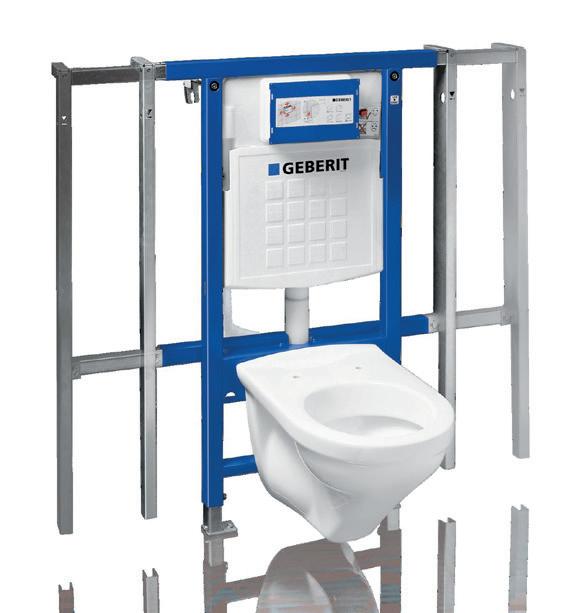
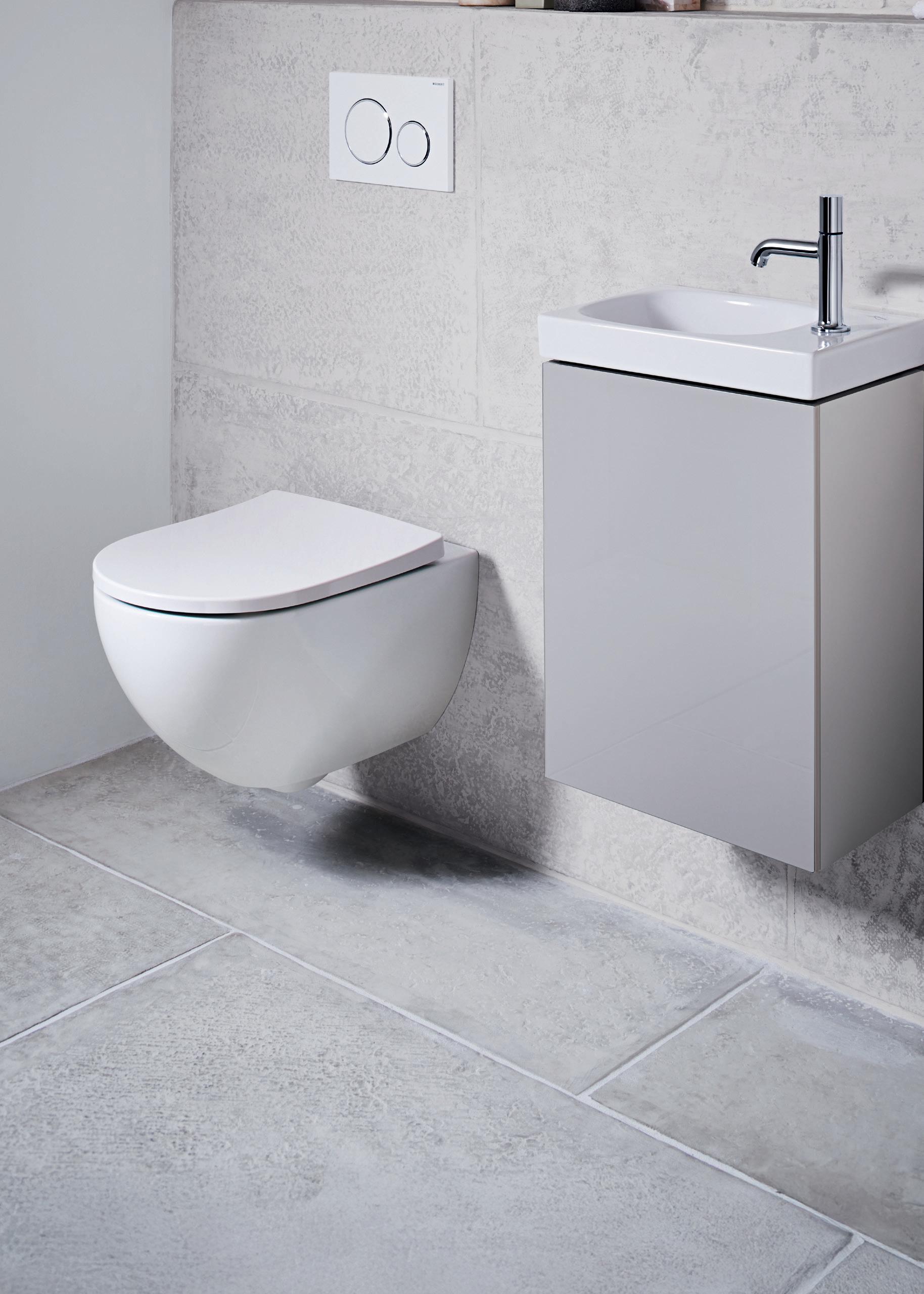
www.geberit.co.uk/wallhung

STEP-BY-STEP GUIDE
Installing wall-hung toilets requires precision and a methodical approach. Follow these steps to ensure a successful installation:
▸ Begin with a thorough assessment of the installation space. Verify all measurements to ensure accuracy.
▸ Ensure the wall structure can adequately support the frame system, as these units will bear significant weight.
STEP 3:
▸ Accurately mark the frame’s location on both the wall and floor.
▸ Carefully level the frame, making sure it is perfectly aligned both vertically and horizontally to ensure the toilet pan will be correctly positioned.
STEP
▸ When making plumbing connections, consider future maintenance.
▸ Install easily accessible isolation valves and ensure the drainage connection is aligned precisely in terms of height and angle.
▸ Use moisture-resistant boarding to support the frame, especially in wet areas.
▸ Pay special attention to waterproofing around the frame for added durability.


“Each installation showcases your expertise and can lead to valuable referrals”

▸ In the final stages, protect the ceramic surface during pan mounting.
▸ Ensure perfect alignment of the flush plate, as it is often the most visible component.
▸ Before closing the wall, check all plumbing connections.
▸ Test flush performance, pan stability, and seal integrity to ensure everything functions correctly.
By following these steps, you’ll ensure a secure, efficient, and professional wallhung toilet installation.
Concealed cisterns represent intelligent engineering that users rely on daily. Geberit’s Sigma cisterns showcase sophisticated dual-flush technology that prioritises water conservation. Despite being hidden, maintenance access is straightforward through the flush plate, eliminating the need for destructive work.
These systems offer remarkable versatility in design through a range of compatible flush plates, from minimalist styles to bold statements. Geberit’s commitment to long-term support, with spare parts availability extending decades into the future, ensures system longevity.
To stay competitive in this evolving field:
▸ Participate in manufacturer training programmes
▸ Stay up to date with building regulations
▸ Understand water-efficiency ratings
▸ Maintain strong supplier relationships
By mastering wall-hung toilet installation and related technologies, you’ll be wellpositioned to meet the growing demand for modern bathrooms. Each installation showcases your expertise and can lead to valuable referrals. Embrace these innovations, and watch your plumbing career reach new heights.


SCAN HERE
For further information.


“The company has grown into an international powerhouse!”
In 2024, Geberit celebrated its remarkable 150-year journey as a global leader in bathroom manufacturing and sanitary technology. From its humble beginnings as a one-man operation in Rapperswil, Switzerland, the company has grown into an international powerhouse, employing over 10,000 people across 26 sites worldwide.
Geberit’s legacy of innovation began with Albert Gebert’s pioneering design of a leadlined wooden cistern in 1904. This spirit of innovation continued with the introduction of the first plastic cistern in 1952, followed by the revolutionary concealed cistern in 1964 - an invention that transformed bathroom design globally.
Today, Geberit’s product ranges encompass everything from behind-the-wall plumbing systems to designer bathroom collections. Its concealed cisterns have become an industry standard, renowned for reliability, water efficiency, and ease of maintenance. Geberit’s commitment to quality is reflected in its rigorous testing processes, with every cistern individually tested for water-tightness before leaving the factory.
The secret to Geberit’s success lies in its dedication to engineering excellence, sustainable practices, and a deep understanding of both installer and end-user needs. Whether it’s wall-hung toilets, shower toilets, or sophisticated flush systems, Geberit continues to shape the future of bathroom technology while maintaining the high standards established over its century-and-a-half history.
For further information.


The water fittings regulations, or byelaws in Scotland, are national requirements for the design, installation and maintenance of plumbing systems, water fittings and water-using appliances. Their purpose is to prevent misuse, waste, undue consumption or erroneous measurement of water and, most importantly, to prevent contamination of drinking water
Remember if you are the installer, you need to ensure your work complies - but from time to time we all need a bit of help...
One place to try is Water Regs UK, who have guidance on all kinds of topics whether installing or maintaining fittings. Their guidance has been created in collaboration with water companies responsible for enforcing the regulations and byelaws. The guidance is regularly updated so you should make sure you keep up to date.
Joining WaterSafe is a great way to show customers you are a trusted professional. WIAPS offers free student membership to help start your journey towards being a trusted WaterSafe member.
There are a range of topics covered here is a small selection:
The regulations and byelaws are provided for easy reference.
▸ Advanced notification is needed, in most cases, so it is important to know when and with what information is needed.
▸ Water companies have 10 working days to respond to valid notifications, which may include conditions that must be followed.
▸ Remember proposed work should not start until after the 10 working days is up.
There is help for selected elements of plumbing installations, including storage cisterns, servicing valves, drain taps and pipes. There are also helpful check lists, guidance booklets and information leaflets.
It is important to protect users from potential contamination. All protection devices are not the same – so it is vital to confirm which devices are appropriate for use, to keep users safe.
Firstly, visit the Water Regs UK website. If you are at all unsure about any aspect touching base with the local water company can prove helpful – you can find their contact details on Water Regs UK's website.
THE WATER REGULATIONS GUIDE HAS BEEN REPLACED BY ONLINE GUIDANCE ON THE WATER REGS UK WEBSITE.
KEY FEATURES:
■ FREE to access

■ Backed by water companies
■ Regularly updated
■ Options to print pages
■ Ability to give feedback and rate
“THE BIGGEST CHANGE IN GUIDANCE IN OVER TWENTY YEARS…”
WaterSafe is the UK register of approved drinking water contractors. It provides an online directory of qualified, professional plumbers, water supply pipe installers and other water services specialists trained to work safely with customers’ drinking water.
WaterSafe is supported by all the UK water companies, installer associations, as well as the drinking water inspectorates, Citizens Advice and the Department of Health.
Being a WaterSafe-approved contractor shows potential customers you have specific training in the Water Supply (Water Fittings) Regulations or Scottish Byelaws, which are designed to maintain safe and wholesome water supplies and avoid the risk of contamination.
By joining the national accreditation scheme for approved drinking water contractors you will:
▸ Reach more customers – WaterSafe’s online directory is one of the largest in the UK
▸ Enjoy support from your local water company – who refer their customers to WaterSafe for approved contractors and can support you with advice
▸ Benefit from promotion and a stamp of approval for your business – members can display WaterSafe branding on their vehicles, stationery, websites and social media
▸ Have access to the latest Water Regulations and Byelaws information – to keep you up-to-date with changes
▸ Be able to issue a Certificate of Compliance – to give customers confidence, reassurance and legal protection
▸ Give reassurance to customers looking for a qualified, competent drinking water contractor.
> HOW CAN I BECOME A MEMBER OF WATERSAFE?
To join WaterSafe, you firstly need to complete your training and gain a water fittings regulations certificate. Once qualified, you can join one of the following Approved Contractors Schemes in the UK. Some of these schemes are free to join, while others require you to pay a membership fee for which you get extra benefits. Once signed up, you can join WaterSafe at no extra cost.
▸ The Association of Plumbing & Heating Contractors (APHC) operates across England and Wales
▸ The Chartered Institute of Plumbing & Heating Engineering (CIPHE) operates across the UK
▸ The Scottish & Northern Ireland Plumbing Employers’ Federation (SNIPEF) operates across Northern Ireland and Scotland
▸ Anglian Water (APLUS scheme) and Severn Trent Water (WaterMark Scheme) operate in the areas supplied by these water companies
▸ The Water Industry Approved Plumbers’ Scheme (WIAPS) operates on behalf of 15 water companies in England and Wales.
To join, you need a recognised plumbing qualification (minimum of NVQ Level 2 or equivalent), a water fittings regulations certificate, public liability insurance and employers’ liability cover if needed. On joining, you’ll get free vehicle stickers and your scheme will provide updates on the regulations.
“Belonging to WaterSafe means you can demonstrate to customers you are competent in your role which means they can have confidence in you. I hope to join WaterSafe when I qualify to further demonstrate my competence to customers and other trades.”

TOM DALEY, Apprentice
WaterSafe-approved plumbers have the authority to self-certify to water companies for certain types of plumbing work (e.g. extending or altering systems in existing buildings and ascending spray/flexible hose bidets) – avoiding notification delays, reducing paperwork and making you more attractive to your customers.

DAISY TURNER, HIP Learner of the Year 2024 and HIP Female Skills Competition 2024 winner and Apprentice
“To be WaterSafe approved means a lot for the business I’m working with and provides reassurance to the client. For me, it’s great to know my future is in the right hands.”






Fernox tackles some of the most frequently asked questions about heating system protection, water treatment chemicals, and in-line filters.
> HOW OFTEN SHOULD A HEATING SYSTEM BE TREATED?
As per the requirements of BS 7593, inhibitor should be added to the system when it is first installed or any time the system is drained or flushed. The inhibitor levels should also be tested annually as part of the boiler service and re-dosed if needed. Every five years the system should be either re-dosed with inhibitor or a full laboratory analysis of the system water conducted. If the test shows insufficient inhibitor levels, the system should be re-dosed with inhibitor.
> CAN INHIBITOR BE OVERDOSED?
It is essential that the system is dosed with a sufficient level of inhibitor and that this is maintained throughout the life of the system and a fresh dose added after five years. If in doubt, it is always best to round up to the next full bottle rather than risk under-dosing the system. Overdosing will not cause any detriment to the system.


“Cleaner should be thoroughly removed to prevent residues causing corrosion and continuing to lift debris”
> DOES ALL CLEANER PRODUCT NEED TO BE REMOVED? ISN’T IT JUST NEUTRALISED BY THE INHIBITOR?
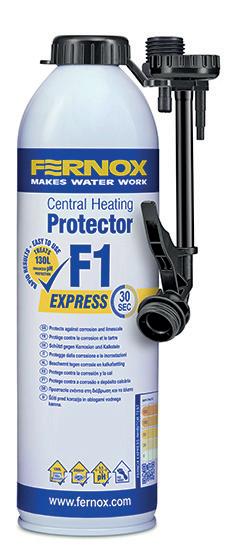

The inhibitor does not neutralise chemical cleaner products. Cleaner should be thoroughly removed to prevent residues causing corrosion and continuing to lift debris. We strongly recommend that a Total Dissolved Solids (TDS) Meter is used during the flushing process to ensure all cleaner is removed. The flush water reading for each radiator should be checked and measured against the incoming mains. When the reading is within 10% of the mains water reading, move on to the next radiator and repeat the process.

> SHOULD I KEEP PARTLY USED BOTTLES OF PRODUCTS FOR LATER USE?
Opened bottles of inhibitor, cleaner and biocides should not be kept and used on future jobs.
> HOW CAN THE CONCENTRATIONS OF HEAT TRANSFER FLUID FOR HEAT PUMPS BE CALCULATED?
The product choice and concentration are based on the frost protection required and the system volume. Underdosing the product means that there will be too little inhibitor and biocide as well as insufficient frost protection.
For example, Fernox HP-5C is suitable for frost protection between -5°C and -14°C. To achieve these levels, different in-use concentrations are required:
▸ For -5ºC – 10% product to 90% system water
▸ For -9ºC – 20% product to 80% system water
▸ For -14ºC – 30% product to 70% system water
However, it is recommended that the heat transfer fluid is mixed with mains water before it is added to the system. When you know what volume of product required based on the volume of the system, you then need to mix this with at least 50% mains water before adding it to the system.


“We strongly recommend that a Total Dissolved Solids (TDS) Meter is used during the flushing process”


“Getting system protection right is essential for the long-term performance of the heating system”
The filter body should always be upright or at a maximum of a 45° tilt angle, depending on the manufacturer’s recommendation. However, the inlet and outlet port can often be fitted on horizontal or vertical pipework. It is important to ensure the inlet and outlet port on the filter is oriented so the moulded arrow on it points in the direction of the water flow. It is also essential to leave enough space around the filter to remove the magnet and to allow the filter to be drained and cleaned easily.
Where space is restricted around a boiler, it is worth looking for a specially designed compact or under-boiler filter that will allow installation in much tighter spaces, as well as ensuring easier servicing.

Getting system protection right is essential for the long-term health and performance of the heating system. Fernox has a range of resources to help ensure best practice, as well as a friendly team happy to answer technical queries.
To find out more about Fernox products.


The last six decades have seen leading water treatment manufacturer Fernox consistently lead the way in the heating industry, with products designed specifically for today’s and tomorrow’s installers.
INNOVATIVE
One of Fernox’s latest innovations is the ultra-compact TF1 Sigma Mini, an ideal filter solution for social housing, new build properties, and smaller volume heating systems with restricted space. Requiring only a 106mm pipework footprint for installation, it can be fitted in under two minutes thanks to its slip socket manifold design.

> HIGH EFFICIENCY AND CONVENIENCE

The TF1 Sigma Mini offers one of the highest kV values among similarly sized filters on the market and also doubles as a convenient dosing point for Fernox’s range of chemical water treatments. For quick and controlled cleaning or draining, installers can simply use the unique drain port without needing to disassemble the filter.
Fernox has also introduced a 265ml variation of its Cleaner F3 (for removing sludge, flux, and debris) and Protector F1 (to guard against corrosion and limescale). These proven formulations have treated over half a million homes. With just one bottle, installers can treat most heating systems up to 100 litres (approximately 12 radiators or 180m² of underfloor heating), keeping waste to a minimum.

For further information.




Ever thought of a merchant as a career path?
Plumb Centre is part of the Wolseley Group and wherever you live in the UK, there’s a Wolseley team near to you. And, because we’re growing our business every day, we need more and more people to join us – as a specialist merchant we are always on the lookout for people with a passion for heating, plumbing and renewables, it’s what we live and breathe and we are super passionate about it!
With Support Centres in Warwick and Ripon, three distribution centres, and around 420 branches, our operation is huge. It involves one of the country’s largest fleets of specialist commercial vehicles and is backed by cutting-edge warehousing and customerfocused supply chain.
Through our award-winning Talent Guild, the business takes an approach to identify, support and develop employees. With everything from apprenticeships to Talent Boosters development programmes, right through to more technical qualifications and higher education programmes, Plumb Centre has it covered.

> APPRENTICESHIPS
Wolseley offers fantastic opportunities to take on new challenges and achieve a nationally recognised qualification which is known as a modern apprenticeship. The business provides early career opportunities by recruiting apprentices into different roles as well as providing similar apprenticeship opportunities to its existing employees, whether that’s continuing your learning with us or starting a new pathway we have lots of opportunities to grow your knowledge and build a career path.


“Wolseley is always on the lookout for talent to join its business”
Wolseley’s Talent Booster career development programmes support employees to build confidence and expertise in their roles, providing a career pathway to maximise and develop their potential whilst boosting their knowledge and skills.
We are always on the lookout for talent to join its business to help its customers succeed, whether you’re in a branch, one of its distribution centres or support centres.


SCAN HERE to learn more about how we bring people into our business.

Your local Plumb Centre branch is an ideal place to get all the advice you need, when it comes to providing the best experience for you and your customers. Here are some tips from our experienced team for those just starting out.
Open a trade account with a specialist merchant to access an array of benefits:
▸ 30 days payment term
▸ Preferential terms on the products you buy
▸ Regular special offers
▸ Access to Reward and Loyalty schemes
▸ Services to help you run your business once you register your account online.
It is essential to ensure that you are equipped with the appropriate Personal Protection Equipment (PPE). Goggles, ear defenders, safety gloves and respiratory protective equipment should be included in your day-to-day PPE kit.
1 2 3
Join membership schemes that will reward you every time you spend money with a merchant. PlumbPro provides access to a range of benefits and members can maximise their trade account with cashback on key brands all year round, enjoy rewards and perks.
4
Newly qualified installers will undoubtedly be bombarded with potential training courses from manufacturers and organisations; merchants can advise on the most valuable courses, and many will run free events in local branches for installers to attend.
5
When it comes to boiler parts, don’t be fooled with cheap spares. In all likelihood they won’t be genuine, and you could encounter problems with long-term performance as well as endangering your customer, any warranties from the original equipment manufacturer and ultimately your reputation.
for further guidance on legislation, product news as well as how-to videos and guides visit.























Now that you have completed your course, let's look at the next steps to help you create a fantastic career!
Your employer has invested four years in helping you complete your apprenticeship. What better place to spend the next stages of your career. It’s likely that you will be given more responsibility too, which will help you gain confidence and respect.
To be a professional installer, you will need to gain as much experience as you can and practice, practice, practice! In addition to your day job, you can also gain vital experience from doing simple tasks for family and friends.
1 2 3
College has provided you with a fantastic foundation to build upon. There are plenty of online learning resources which will help you continue learning and gain additional skills.

“Invest in yourself! More training leads to more qualifications, which will place you a cut above the rest”


Invest in yourself! More training leads to more qualifications, which will place you a cut above the rest. Consider pursuing additional certifications such as Gas Safe, G3 HW and WaterSafe.
Trade shows are a great place to meet up with fellow installers, manufacturers and industry professionals. You’ll not only learn about new products but also make some great contacts who will be able to support you in the early stages of your career.
4 5 6
To gain a better understanding of the applications and workings of different products and appliances, consider attending manufacturer’s courses. They are invaluable and are often free to attend.
Remember, there are many advantages to working for a plumbing business for a number of years before you start your own. You can watch and learn (and take notes!). Plus, there’s the regular income, which you’re unlikely to get when you first set out on your own.
SCAN HERE
For free advice and support.

Balancing
the
books may not be the reason you became a plumber, but looking after the financial side of things is an important part of running your own business.
If you are just starting out you will need to set up a credit account with a plumbing merchant. They will make an assessment on how much credit they are willing to offer you.
At first they may want you to pay upfront for goods, until you become established. After that, you will usually be given 30 days to pay for the goods you have ordered.
Be prompt with your payments and in time, your credit rating will rise.
Make sure you keep an accurate account of all earnings and expenditure. You don’t want to find yourself in trouble with the tax man.
The ability to price up a job is something that will probably develop over time and with experience, but here are a few tips to help when you’re starting out.


▸ When pricing work for customers, the first thing to establish is whether the customer requires a quote or an estimate. Remember a quote is a firm price, while an estimate is your best guess and may vary from the initial price.

▸ If you provide a quotation you should not invoice the customer for anything extra unless they have asked you to do extra work. If the customer asks for extra work to be carried out during the installation you should re-price the work and present a variation order for the customer to sign.
▸ Sometimes you will have to do extra work you couldn’t have reasonably known about when you quoted. You may be able to add this to the invoice but you should let the customer know as soon as possible.
▸ Make a thorough list of the materials you’ll need to complete the job. If it’s a big list, get prices from two or three different merchants. It’s worth spending that extra time making sure that your materials are priced right.
▸ If a job takes longer than you thought all you’ve lost is your time, but if you’ve underpriced the materials it will come out of your pocket. Charge the customer list price for all materials. Any reductions you receive from the list price should be marked as profit margin.
▸ For labour costings, allow time for travelling to and from jobs, and also for the time you’ll spend collecting materials. Work out an hourly rate and how long you think the job will take. If you’re not sure how much to charge customers per hour, you could call other plumbing companies in your area to learn their hourly rates.
“Make a thorough list of the materials you'll need to complete the job. For big jobs get prices from different merchants”
With experience, you’ll learn how long most jobs will take and allow for any problems. When starting out, predict how long an individual job will take and write it down, then compare it with how long the job actually took. It will help to price jobs more accurately.
Also allow for any time you have been out to look at a job beforehand, and if it’s a larger job you may want to allow for coming back and snagging.

Even in the age of Google and social media, one of the best ways to gain customers is through word-of-mouth. Being professional is a simple way to impress your customers and earn that all-important recommendation. Here are our top tips.

> TURN UP ON TIME
1
Being punctual shows that you’re reliable. Showing up late is not going to endear you to a customer who has potentially waited in all morning for you to arrive. If you’re stuck in traffic or running late through no fault of your own, call ahead to let your customer know you’ve been delayed.
> LOOK AFTER PEOPLE’S PROPERTY
2
Show your respect for people’s property by taking off your shoes when you enter their home. If you need to wear shoes for the job, wear shoe covers. And remember to put down dust covers wherever you work and use heat mats when necessary.
> LOOK THE PART
3
Dressing smartly suggests professionalism from the outset. A polo shirt with your company logo on it is much better than a tatty old T-shirt.
> MANNERS COST NOTHING
4
Something as simple as saying ‘please’ and ‘thank you’ can make a real difference to how a customer sees you. Listen to your customer and be sympathetic to their concerns, no matter how trivial they may seem to you.
> TAKE EXTRA CARE WITH VULNERABLE CUSTOMERS
5
You may need to be more patient with elderly customers, for example.


Although word-of-mouth is still a vital way of generating new business, Google is the most trusted review platform across all industries.
According to BrightLocal's 2023 Consumer Review Survey, a whopping 98% of people read online reviews for local businesses, and Google sits at the top!
This is good news for a local businessespecially for those who take the time to have a strong presence online, and in growing their review profiles.
That’s why it’s important to have a website that works for you. When people in your local area search online for a plumber, you want it to be your name they find.
Start by building a basic website - at the start of your business, you want to keep your costs down as much as possible so we'd suggest using Wix.com or a similar online platform which are either free or fairly inexpensive.


“When
people in your local area search online for a plumber, you want it to be your name they find”


If you’re keeping it simple, stick to three pages for your website – a homepage, a services page listing everything you offer, and a contact page.
> HOMEPAGE
This has to grab people’s attention but avoid being tacky. Describe what you do and use images that reflect your business.
> SERVICES PAGE
List every service you offer as part of your business, including those that may seem obvious or mundane to you, like installing washing machines and dishwashers or replacing taps. Think about what people will type into Google when looking for a plumber.
> CONTACT PAGE
Include your full business address, contact numbers, an email address and links to your social media accounts. Make it easy for people to get in touch with you.
You could also add an ‘about’ page, so people can find out more about you. And if you can put in more time, it might be beneficial to create individual pages for the different services you offer. For example, a ‘boiler’ section on your website could contain separate pages for installations, repairs, servicing and emergency call-outs.
Other things you can do to boost your website:
▸ Create a Google Business Listing (go to google.com/business)
▸ Encourage your customers to leave reviews
▸ Register with business listings websites like Yell, Gumtree or Checkatrade.

Social media can be brilliant for promoting your business - plus it's free! The different platforms each have their own strengths.
As of November 2024, the leading social media platforms by monthly active users (MAU) are:
Facebook: Approximately 3.15 billion MAU. Instagram: Surpassed 2 billion MAU.
TikTok: Exceeded 1.5 billion MAU.
X (formerly Twitter): Around 570 million MAU.
YouTube: Over 2.5 billion MAU.
Make sure you have social media accounts for your business so you can showcase your best work and impress those potential customers.
Although you may not use Facebook, many of your customers will, so it's a great place to promote your business. Create a personal account and set up a separate one for your business. This should have links to your website and any other social media accounts you have linked to your company. Post photos of installations you’ve carried out and make your comments friendly and chatty. Update it as often as possible.
Many plumbers have accounts on Instagram as it's a great place to showcase their best work, with the selection of grid posts, stories and reels. Again, it's free advertising and great for building a following.

“Social
media is about creating a conversation, so share other people’s relevant content and try to respond as soon as possible to people who post on your page or send you messages”
Social media works both ways. If you provide a great service, you’ll reap the benefits. Personal recommendations are priceless. However, if you upset a customer, it could damage your reputation for a long time, especially if you lose your cool online.


Source: Statista, 2023
> TIKTOK

TikTok is a unique platform where you can share helpful videos, such as what customers can do to reduce energy bills, for example, which can give you respect in the industry. Fantastic for engaging with potential customers.
> X
The plumbing community on X is full of people sharing images of their work and learning from one another. You can easily add your website to your message and grow your following.
> YOUTUBE
Coming in as the second most popular social media platform, consider starting your own channel. It's a great way to share ideas. Even if you don't have your own channel, it's a great place to pick up hints and tips from other plumbers, manufacturers and merchants.
This is a great platform for plumbers to network with other professionals in the trade. You can easily create a company page, where you can include your website and all your social media accounts.


Confusing insurance jargon has been baffling plumbers for years. But this handy guide has you covered.

Mark Herbert at ConstructionInsure.co.uk compiled this jargon-busting list to help plumbers understand complex insurance issues in simple terms. He said:
“When people begin to understand these frequently used terms, and realise it is not as complex as it sounds, insurance becomes a much simpler matter”
1 ASSURANCE
Insurance cover against an eventuality, for example - the death of a person being covered under a life insurance policy.
2 ADDENDUM
An additional piece of policy information.
3 WARRANTY
A written guarantee or a commitment issued to the purchaser to repair or replace the article purchased if necessary, within a specified period.
4 PREMIUM
The cost of the policy which includes taxes and broker/insurer fees.
5 RATE
The risk calculation used to arrive at the premium, minus broker and insurer fees.
6 COVER
The amount of risk or liability that is covered for an individual or object by insurance services.
7 CLAIM
A formal request to an insurance company for coverage or compensation for a covered loss. Claims are made in the event of loss or damage.
8 LOSS
The injury or damage sustained by the insured.

A document that has been put together with an insured (the first party) to
Sections of a policy which state
A middle man acting between a client and an insurer. They have a legal duty to help you obtain appropriate coverage at a reasonable price.
A document presented to a client before the parties agree to go ahead. It details an estimate of a rate with a potential insurance carrier.
A
All risk cover insures all losses arising from
or
Is the first amount payable by a policy holder in the event of
A person or company’s legal responsibility for an act of negligence, or a circumstance in connection to their business, causing loss or damage to a third party.
A failure to act in a way that a reasonable person would when faced with certain situations or circumstances. For example, if water is coming into your home due to a burst pipe, your insurance policy will require you act to prevent further damage. If you do not, you may be considered negligent.
19 NO CLAIMS BONUS
A discount given for being claim free.
20 NON-DISCLOSURE
Holding back information that would bear an effect on a policy.
21 RISK
The exposures covered within a policy. 22
The lead name on an insurance document, a person whose name an insurance policy is held in.
23 REINSTATEMENT
The rebuild value of a property.
Re-application of insurance after the existing policy has expired. 25 STATEMENT OF FACT
A document which contains all information given by a policyholder. 26 THIRD
Insurance is purchased by an insured (the first party) from an insurer (the second party) for protection against the claims of another (the third party). 27 UNDERLYING
The basic or primary layer of coverage, the initial policy that will respond to the covered loss.

A big part of your job will be maintaining the correct Health and Safety procedures every working day. It is crucial you are aware of the hazards that exist wherever you are working and that you take the necessary precautions so you are prepared in case the worst happens.

The Health and Safety at Work Act (HASAWA) 1974 legislation should be followed to ensure your own safety and that of anyone you work with, and you are legally obliged to follow its rules and regulations.

> KEY HASAWA RESPONSIBILITES
▸ As a plumber working on domestic premises, the health, safety and welfare of the occupant becomes your responsibility because it is your place of work.
▸ You have a responsibility to both yourself and to others to keep the workplace hazard-free.
▸ While your employer has a duty to ensure that the safety equipment provided is kept in good condition, you still need to maintain your own safety as they cannot cater for human error or negligence.

> HERE ARE SOME OF THE HEALTH AND SAFETY RISKS A PLUMBER MIGHT FACE:
Working in attics and at internal and external high points on buildings puts you at risk of falling. Make sure the surface you’re putting the majority of your weight on is secure and has been inspected where this is relevant. Never stand on a surface unless you’re 100% sure it is safe.

Tools and machinery can create more decibels of sound than the human ear can safely be exposed to, so use ear plugs or ear defenders at all times when working in a noisy environment, as part of your PPE.

Lead, asbestos, raw sewage and mould are just some of the hazardous substances you are at risk of being exposed to as a plumber. These can cause serious illnesses such as Tetanus and Hepatitis A, B or C.
Make sure you apply barrier cream before starting a job, wash your hands whenever you take a break and always wear the correct PPE (gloves, eye protection etc). Clean your equipment properly after use and maintain good ventilation where you are working at all times.
The COSHH (Control of Substances Hazardous to Health) regulations must be adhered to at all times. Substances that fall under COSHH will often be labelled as dangerous (i.e. toxic, very toxic, harmful, irritant or corrosive) and control measures must be applied when handling such substances. Always follow the manufacturer’s instructions of use.



If you suspect someone has a broken bone, keep them still until the injured part is secured and supported. If the person is in immediate danger, then of course they should be moved away from the hazard – but do not put yourself at risk and always call emergency services immediately.

Always make sure to maintain any tools and equipment that you use and cut away from your face and body when using sharp objects. If the task at hand requires a lot of concentration or if you are in an awkward position whilst performing the task, take frequent breaks to eliminate the chance of error and adjust your position regularly to avoid cramping and muscle injury.
Don’t underestimate the damage that can be caused by hot water and steam. If you are scalded, flood the burn with plenty of cold water immediately and do not remove anything that may be sticking to the burn – this may cause further damage and introduce infection. Always call 999/112 for emergency help.
The load generally accepted as the maximum for a fit person to lift is 20kg
If you would like more information, here are some websites which may be useful to you.
▸ hse.gov.uk/coshh
▸ hse.gov.uk/legislation
▸ www.redcross.org.uk/about-us/ what-we-do



T: 01302 855 656 I E: info@aalberts-ips.com
Aalberts IPS develops the advanced integrated piping systems for distribution and control of liquids and gases. These systems are used in various markets such as industry, utility and residential construction. We offer fully integrated piping systems in valve, connection, fastening and piping technology.
@aalbertsipsuk
@aalbertsips_uk
@AalbertsIPSUK
@aalberts-integrated-piping-systems
T: 01785 218200 I E: sales@altecnic.co.uk
Altecnic is the UK’s leading supplier and manufacturer of quality heating and plumbing products for both domestic and commercial markets. We have industry leading expertise and new product development, supported by dedicated technical and customer service teams.
@altecnicltd
@AltecnicLimited947

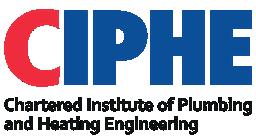
@Altecnic @Altecnic
@Altecnic
T: 0330 6780917 I E: info@baxi.co.uk
Baxi has been manufacturing in the UK since 1866 and provides reliable, energy efficient products, backed by industry leading customer support, hands-on training by experienced professionals and nationwide availability of Baxi genuine parts.
@baxiboilers
@baxiboilers
@baxiuk
@BaxiBoilersUK
T: 01708 463100 I E: info@ciphe.org.uk
The Chartered Institute of Plumbing and Heating Engineering (CIPHE) is the UK’s only chartered body for plumbing and heating professionals. With 7,500 members globally, it supports consultants, engineers, trainers, and practitioners with technical, training, and professional development resources.

T: 0121 557 2831 I E: marketing@ibpgroup.com
Since 1909, Conex Bänninger has been a global leader in high-quality fittings and valves, offering innovative, efficient solutions for HVAC, gas, and water systems. Its products provide quality and ease of installation for commercial and domestic applications.
@conexbanninger_uk
@ConexBanninger
@ConexBanninger @conex-banninger

E: enquiries@cuspuk.com
Born from the ambition to challenge the plastics greenwash within construction and plumbing, CuSP champions environmental thinking, insight sharing and collaboration across industries to encourage the use of copper as a more sustainable choice.
@cuspuk
@cuspuk

@cuspuk
@CuSP – Copper Sustainability Partnership
T: 020 3457 3703 I E: enquiries@corgiservices.com
For over 50 years, CORGI Services has been a trusted name in plumbing, heating, and renewables. Renowned for high standards of reliability, expertise and quality. Supporting tradespeople nationwide, CORGI are trusted to bring warmth, comfort and security to people’s homes.
@corgiservices
@corgiservices1

@corgiservices
T: +44 (0) 330 100 7750 I E: sales@fernox.com
Fernox is a leading manufacturer of water treatment chemical products, central heating system filters, plumbing consumables and diagnostic testing services. Fernox has pioneered the development of energy efficient products both for traditional and renewable technology in domestic and commercial applications.
@Fernox64
@Fernox64
@FernoxWaterTreatment
@Fernox

T: 01926 516800 I E: enquiries@geberit.co.uk
At Geberit, we use our passion for design and technology to deliver contemporary, high quality solutions that transform efficiency, increase safety and enhance living and working environments. As a European market leader in sanitary technology we apply our vast know-how and over 150 years of experience to everything we do.
@Geberit

@GeberitUK
www.linkedin.com/showcase/geberit-uk/
T: 01380 736920 I E: info@grantuk.com
Grant UK supply award-winning air source heat pumps and HVO boilers as well as complete package heating solutions including cylinders, solar thermal and hybrids, and their in-house renewables experts provide comprehensive customer support including product training, system design support and onsite set-up assistance.
@grantuk_pro @grantukpro @MyGrantUK @grant-engineering-uk-ltd
@myGrantUK

T: 01525 850000 I E: grundfos-uk@sales.grundfos.com
Grundfos Pumps is a UK leader in the supply of energy efficient pumps for a wide range of applications around the home. This includes a great line-up of domestic circulator pumps that will meet all your demands.
@grundfos @Grundfosinstallers_UK @grundfosforinstallers @grundfos @grundfos

T: 01926 242300
Founded in 1901, Hansgrohe stands for innovative solutions for bathrooms and kitchens that combine intelligent functionality with outstanding design and quality.
@Hansgrohe_uk @hansgroheUK
@HansgroheUK

T: 01727 875020
Established in 1984, Kamco quickly developed a reputation for quality, reliability, and innovation in the heating industry. Kamco is the leading innovator in the field of power flushing and descaling solutions and has developed and continuously improved a range of products to meet the evolving needs of the fast-paced industry.
@kamcoltd
@kamco-ltd
T: 0345 260 0258 I E: hotwater@kingspan.com
Across all the Kingspan Water & Energy businesses we’re pioneering new technologies to preserve and protect water & energy for future generations. This ideology is especially clear in our hot water cylinders business, where we’re committed to delivering high quality, energy efficient cylinders in both traditional Albion copper and our modern Ultrasteel unvented cylinders ranges.
@KingspanWaterandEnergy


@kingspanWatEner
@KingspanWaterEnergy
T: 01707 278666 I E: Heating@meuk.mee.com
The Ecodan air source heat pump from Mitsubishi Electric is the renewable, low carbon alternative to traditional high carbon heating systems. This reliable, renewable heating technology delivers highly efficient sustainable space heating and hot water all year round.
@Mitsubishi_Electric_Heating_UK
@ecodanheating

@MitsubishiElectricHeatingUK
@Mitsubishi_Electric_Heating_UK
T: 01926 705000
With over 420 branches across the country, Plumb Centre is the UK’s largest trade specialist in high-quality plumbing, heating and bathroom products. We stock the biggest names and most trusted brands. We are also the UK's largest spare parts trade specialist for domestic as well as commercial customers in plumbing, heating, and refrigeration.
@plumb_centre
@plumb_centre
@WolseleyPlumbCentre
@Wolseley-Plumb-Centre

T: 01709 770000 I E: residential@polypipe.com
Polypipe Building Products is the UK’s leading manufacturer of plastic piping systems and low-carbon heating solutions for the residential market. We design, develop, and manufacture over 20,000 product lines which are stocked in plumbers and builders’ merchants nationally.



@polypipetrade @PolypipeTrade
@PolypipeTrade
@PolypipeTrade www.linkedin.com/showcase/polypipetrade
T: 0808 238 9869
RIDGID®, a leading manufacturer of tools and equipment, markets its products in over 140 countries. The company offers more than 300 types of tools serving the rental, plumbing, HVAC/R, utility, industrial, electrical, petroleum, institutional, commercial and hardware markets.
@RIDGID.Europe
@RIDGID.Tools.Europe
@RIDGID_Europe
T: 01384 442852 I E: RJWEng@btinternet.com
Established in 1989, RJW has brought new innovative products to the plumbing industry. The only NHBC approved fitting for the PRV on boilers, the PIPE COWL. The only permanent fix to a holed pipe without cutting the pipe, the CLICK FIX. The only answer stopping dust sheets moving on stairs, the Safety Stair Rods. Also in the Guinness World Records for the largest copper pipe fitting in the world.
T: 01895 449 23 I E: customer.services.uk@rwc.com
RWC and its family of brands develop safe, sustainable, and efficient solutions through a range of engineered and innovative products. Its JG Speedfit, Reliance Valves and SharkBite brands offer a complete range of pipes, valves and fittings. They’re designed to seamlessly integrate, from boiler to point of use, within the modern built environment.
@jgspeedfit @reliancevalves
@JGSpeedfit @RWCUK
@jg-speedfit-uk @reliance-valves-uk
T: 020 8842 0033 I E: sales@saniflo.co.uk
Saniflo is the market leader in the production and sale of macerators, pumps and lifting stations for domestic and commercial use. The company also has the Kinedo range of showering products including cubicles, enclosures, trays and a brand new range of shower panels.
@SanifloUK
@SanifloSupport
@Saniflo-uk-ltd @Saniflo

T: +44 (0) 203 893 2159 I E: installers@tado.com
tado° is the expert in smart heating and home energy management. Our products and services – designed and developed in Germany –offer everything professionals need to help customers to heat and cool their home in an energy-efficient manner.
@tado @tado_com @tado_com

T: +44 (0) 1634 268811 I E: info@talon.co.uk
Talon is the market leader for pipe clips and finishings, including PipeSnug, Snappit, EZ Joist Clip, plus pipe covers. More than ‘just pipe clips’, Talon’s wide range of products makes installations easier, quicker, safer and ensures a professional finish.

T: 01903 771699 I E: marketing@the-ipg.co.uk
Choose one of The IPG member stores for your plumbing and heating supplies. You will benefit from expert advice and excellent products at competitive prices. With stores nationwide, finding your nearest one is easy. Experience the difference with The IPG.
@TheIPG @the_ipg @theipg
@theipg @the-ipg
T: 01495 983 010 I E: info@waterregsuk.co.uk
Water Regs UK collaborates with UK water companies to provide free online guidance on the Water Fittings Regulations and Scottish Byelaws. Plumbers and water fittings professionals can join the Water Industry Plumbers Scheme (WIAPS), run on behalf of 15 UK water companies.
@WaterRegsUK

T: 0800 038 0088 I E: info@hep2o.co.uk
Hep2O is Wavin’s market-leading flexible plumbing that offers a complete range of push-fit solutions. Wavin, a member of the Orbia Group, is the leading supplier of water management, plumbing and drainage systems for the building and construction markets. Other Wavin brands include Hepworth, OSMA, and Tigris K5/M5.
@hep2o
@WavinCoUK @hep2o
T: +44 (0) 1908 555 450 I E: info@wd40.co.uk
Originally created in 1953 as a rust prevention and water displacement solution for the emerging aerospace industry, the blue and yellow cans of WD-40® have become the go-to problem-solver for both DIYers and professionals alike.
@wd40uk
@OriginalWD40.UK
@wd40_uk @wd40uk

T: 01283 523000 I E: sales.uk@wilo.com
Wilo is a significant driving force in the pumps sector in the UK, providing pumps and pump systems for heating, cooling and airconditioning technology as well as water supply and sewage disposal.
@wiloukltd
@WiloUK
@WiloUK @WiloUK
@WiloUK

T: 01291 634 149 I E: plans@wundagroup.com
UK manufacturer, system design and support. Set up in 2006, our priority is to provide a hassle-free process and highly reliable solutions from system design to installation and use, ensuring dependably working heating systems for years to come.
@wunda_group
@Wunda Group PLC
@WundaUK
@wunda_group

43,500+ FOLLOWERS

HIP MAGAZINE’S SOCIAL MEDIA IS THE BEST WAY TO GET YOUR WORK FEATURED AND SEEN BY SOME OF THE INDUSTRY’S LEADING BRANDS AND PROFESSIONALS.
Do you have a bit of graft that you think everyone needs to see? Maybe it’s that new install that’s a cut above the rest, or perhaps you’ve fitted a cylinder for the first time and want the world to know?
To be featured across HIP Magazine’s social space, simply tag us in a photo or video of your work and let us do the rest. And if tagging isn’t
your thing, our DMs are always open! You could be featured in our 'Friday Follow,' where we spotlight someone each week and encourage our viewers to follow them. It's a great chance to grow your followers!
To stay in the know and to avoid missing out on everything we have to offer, search HIP Magazine across all platforms and give us a follow.









